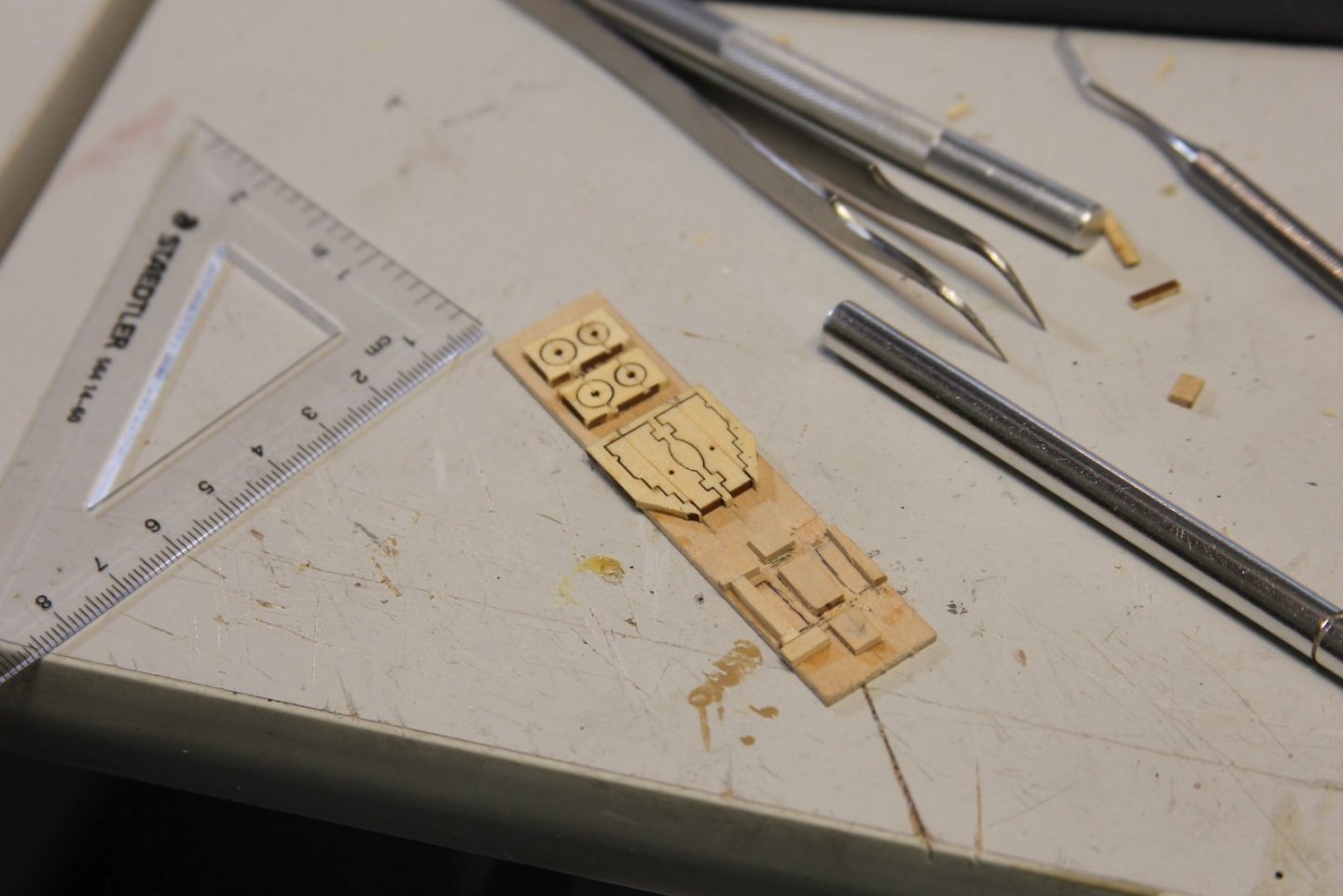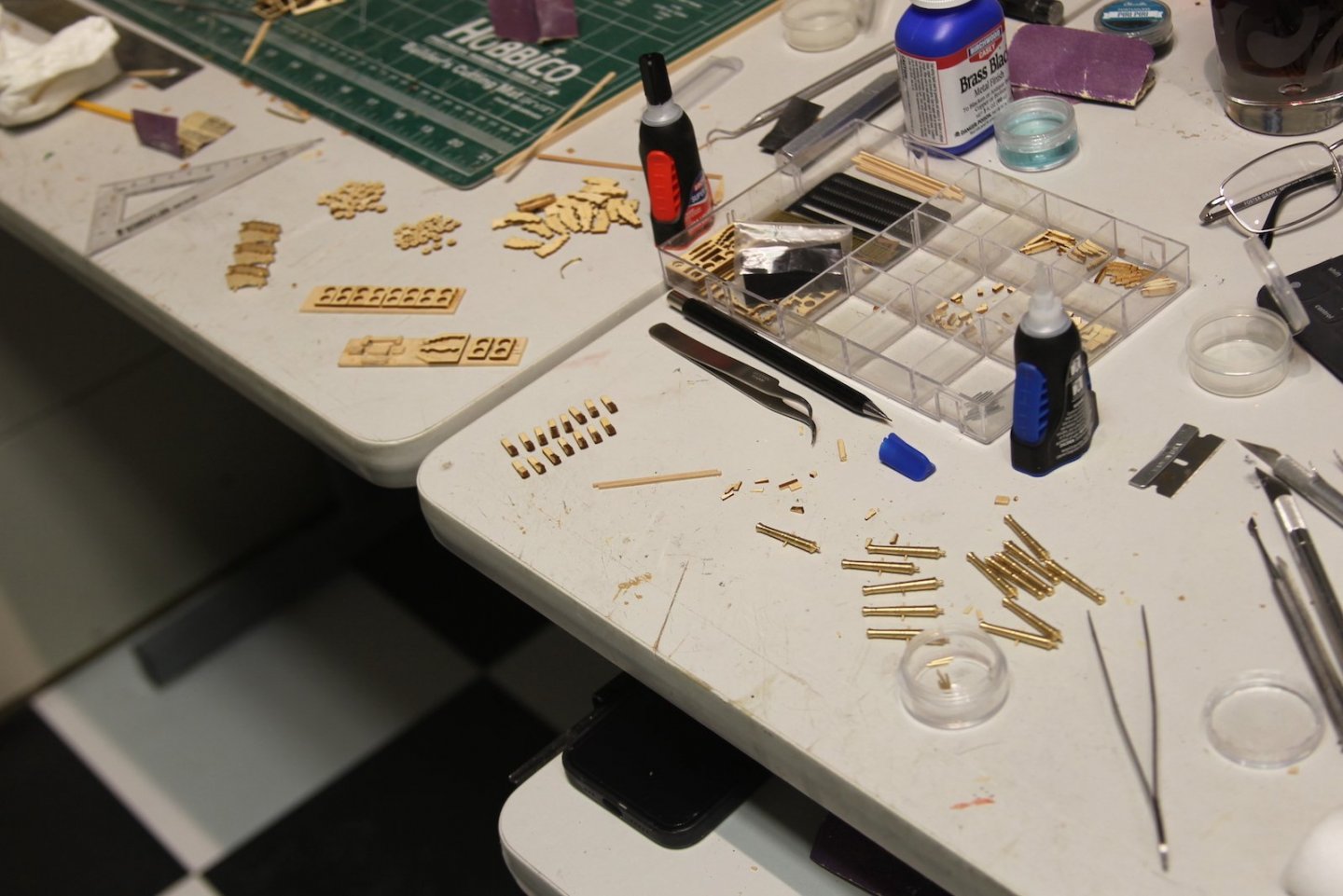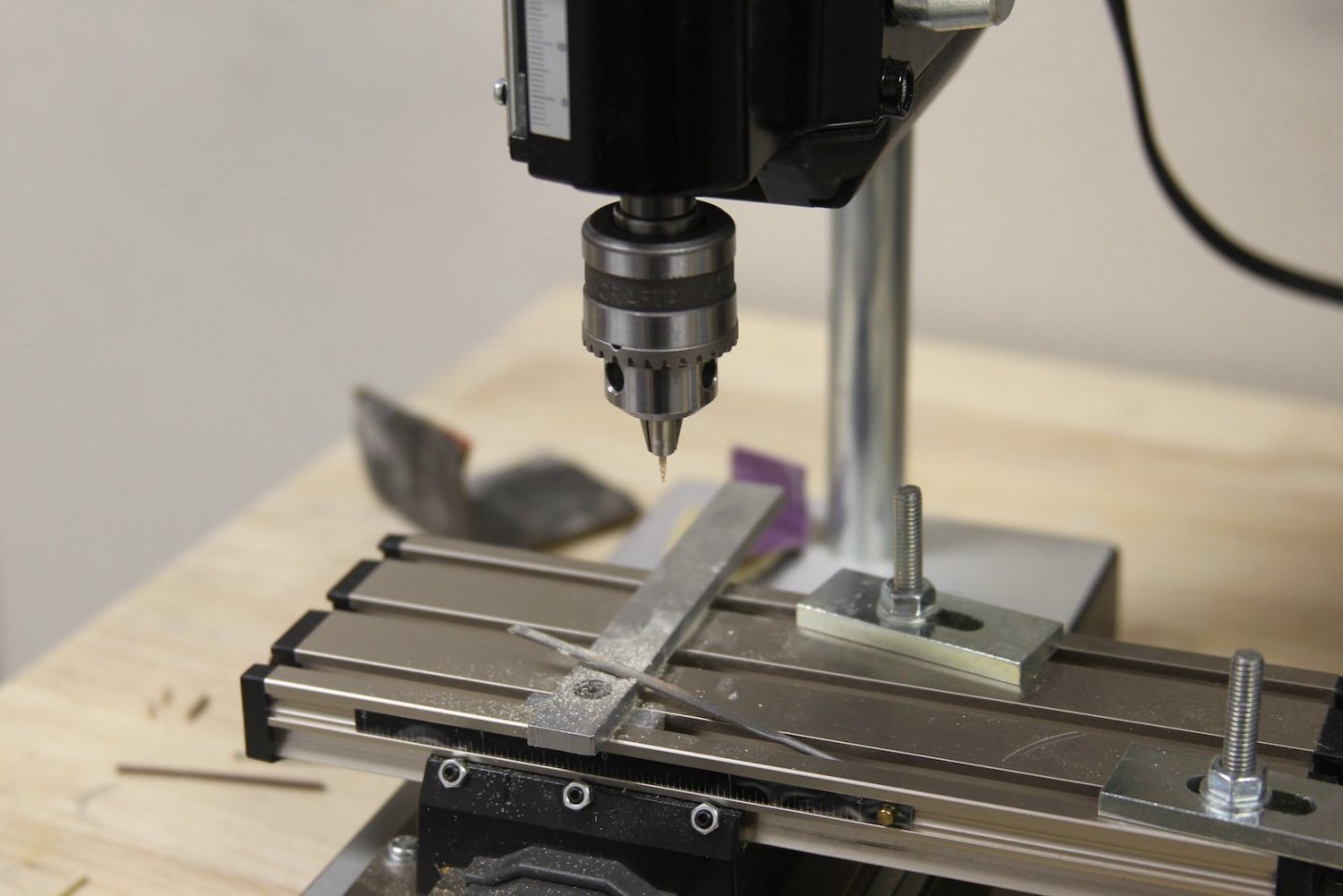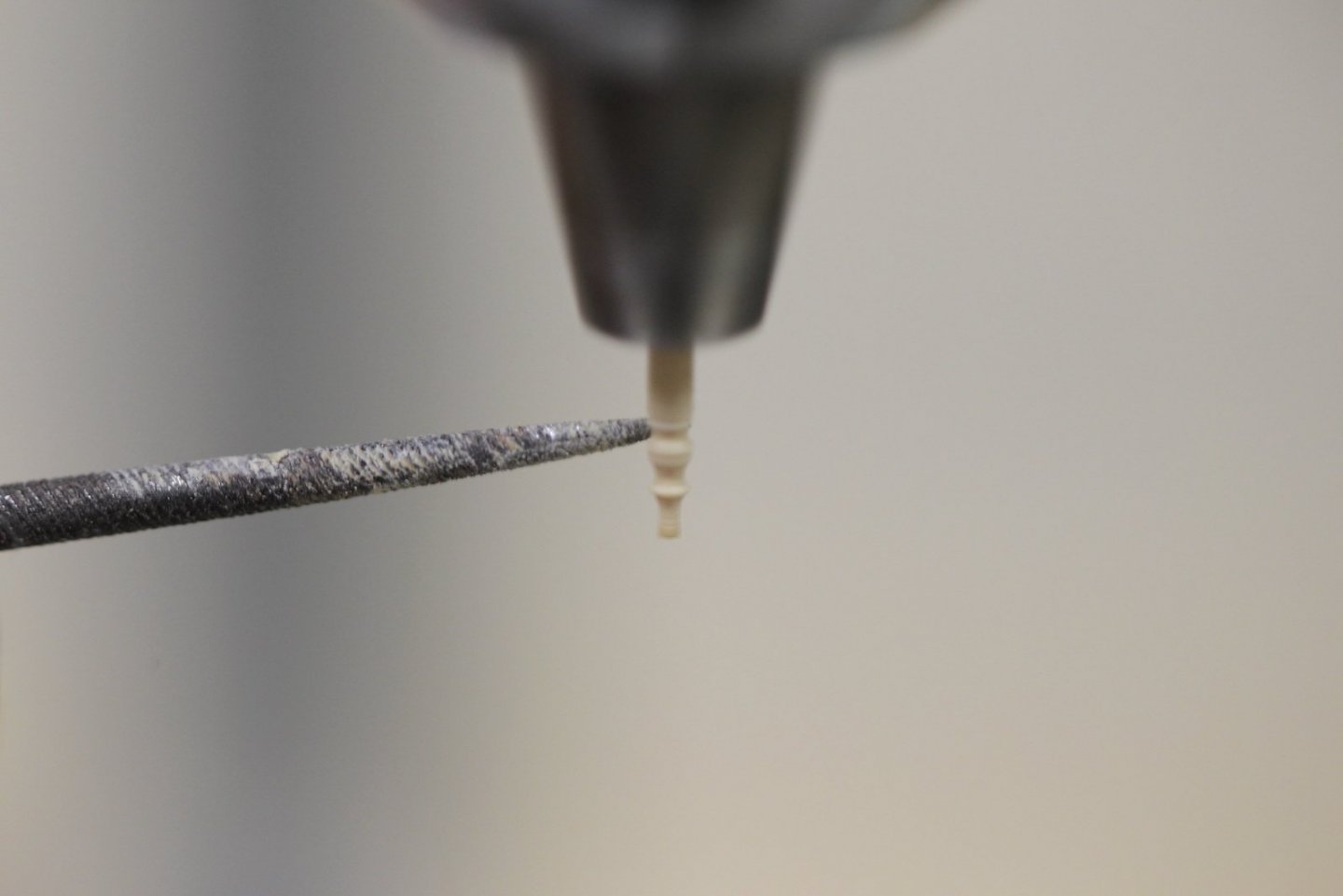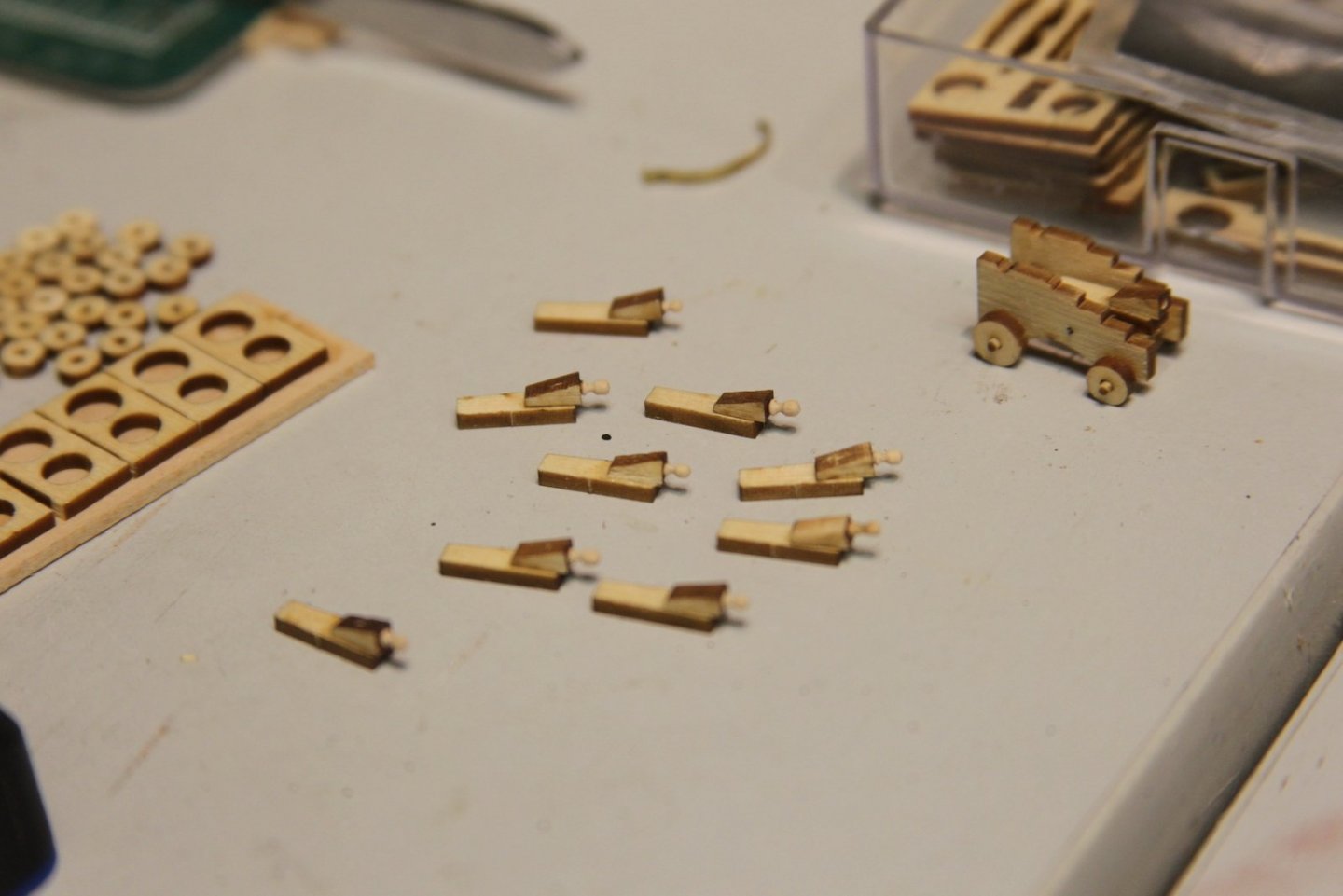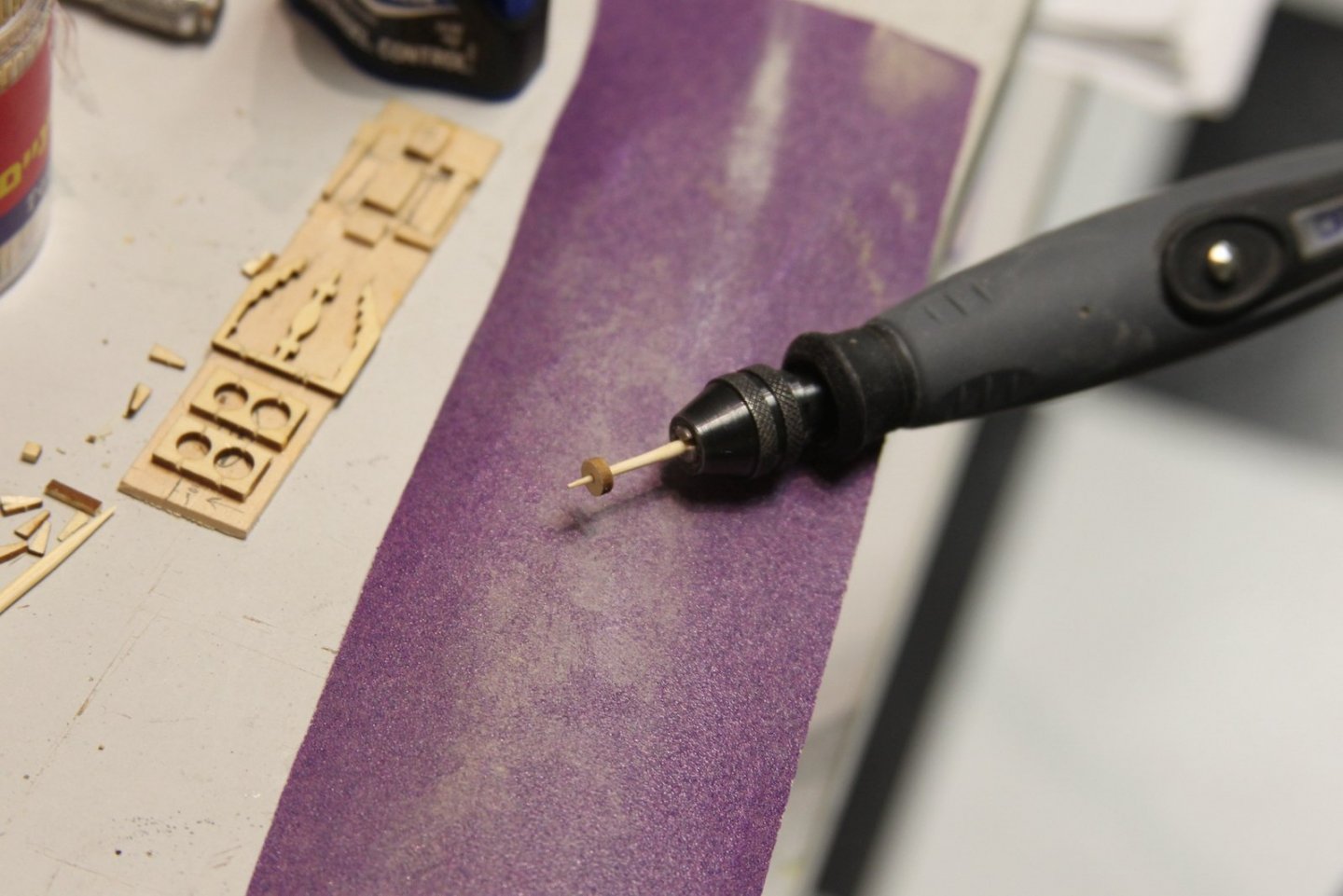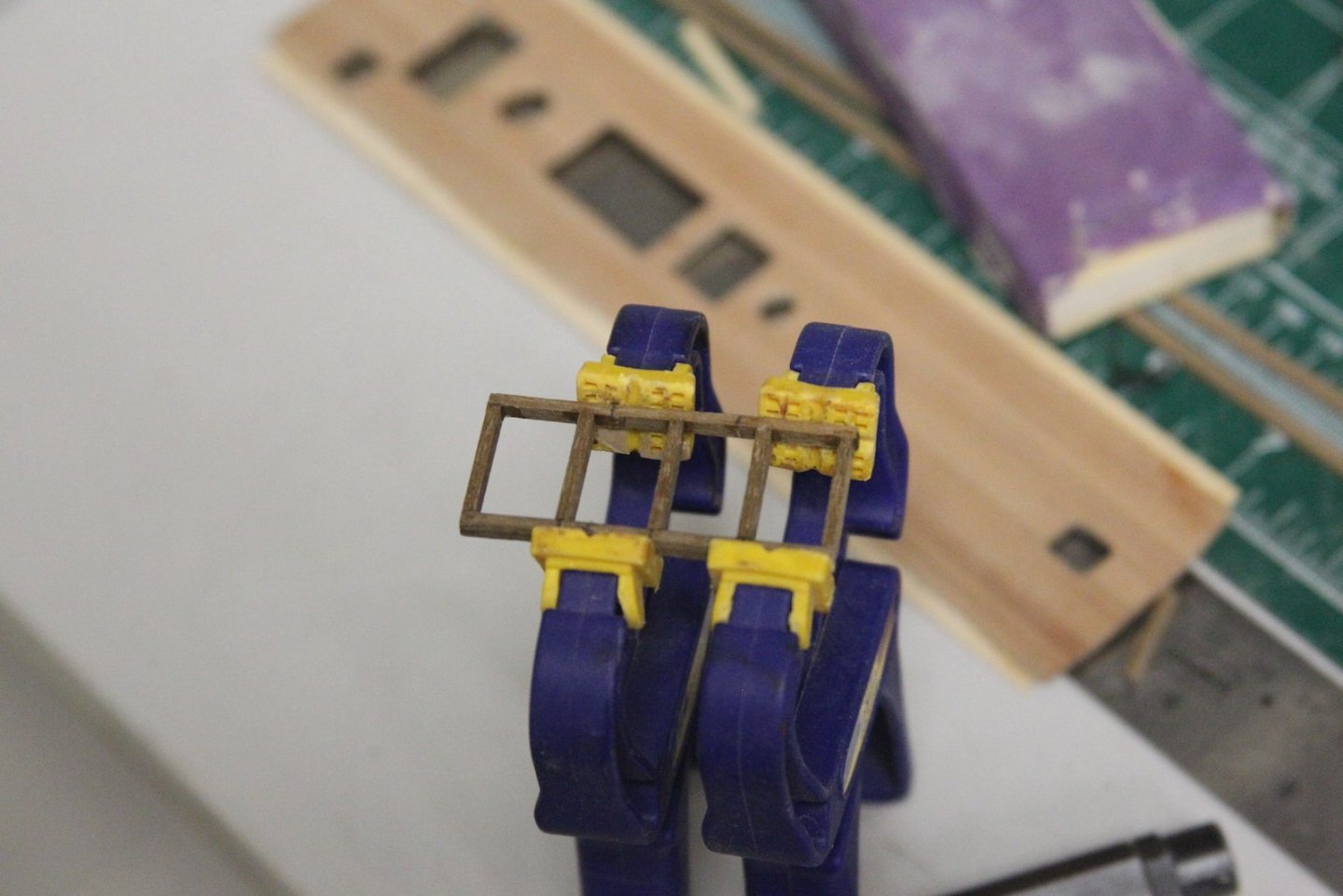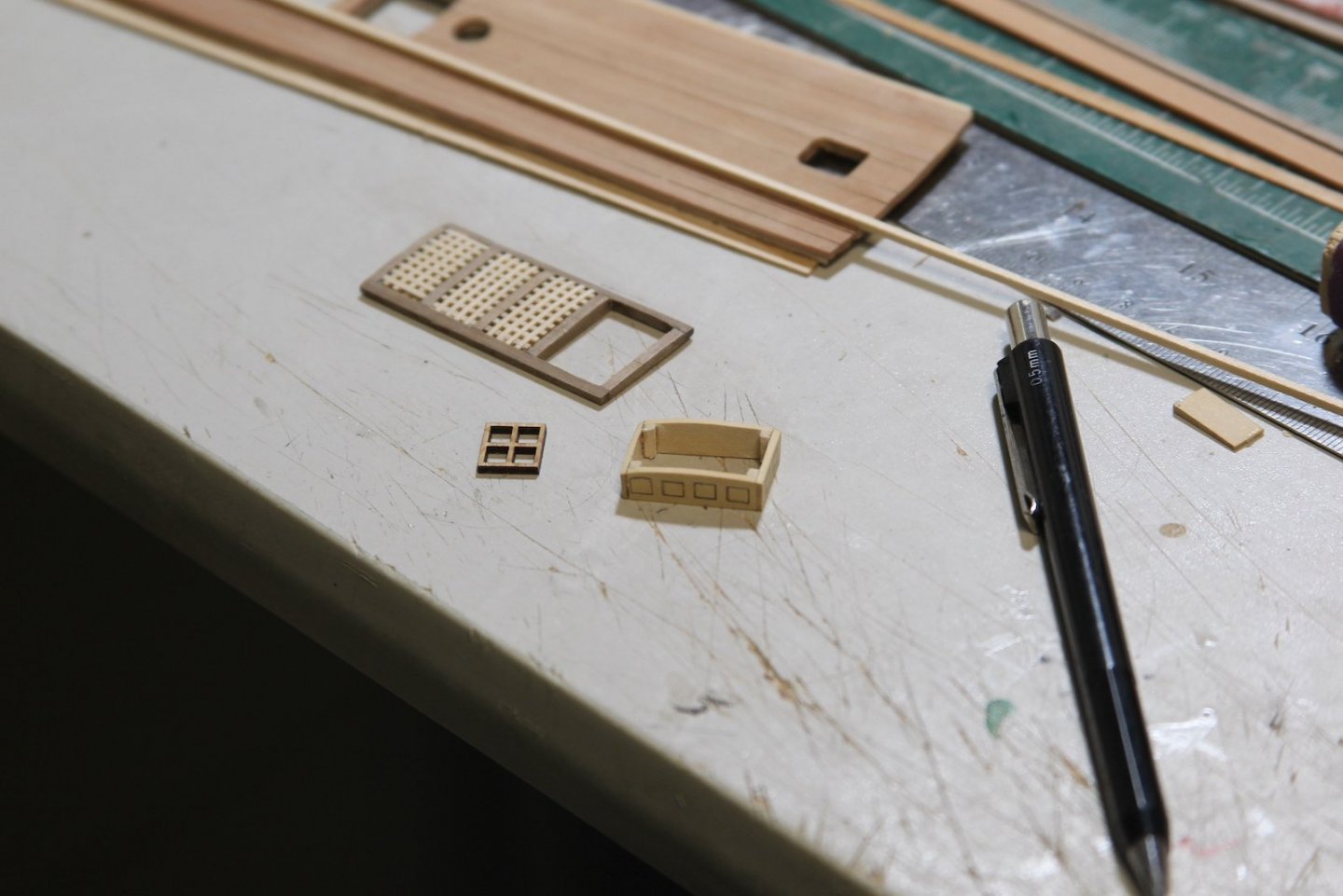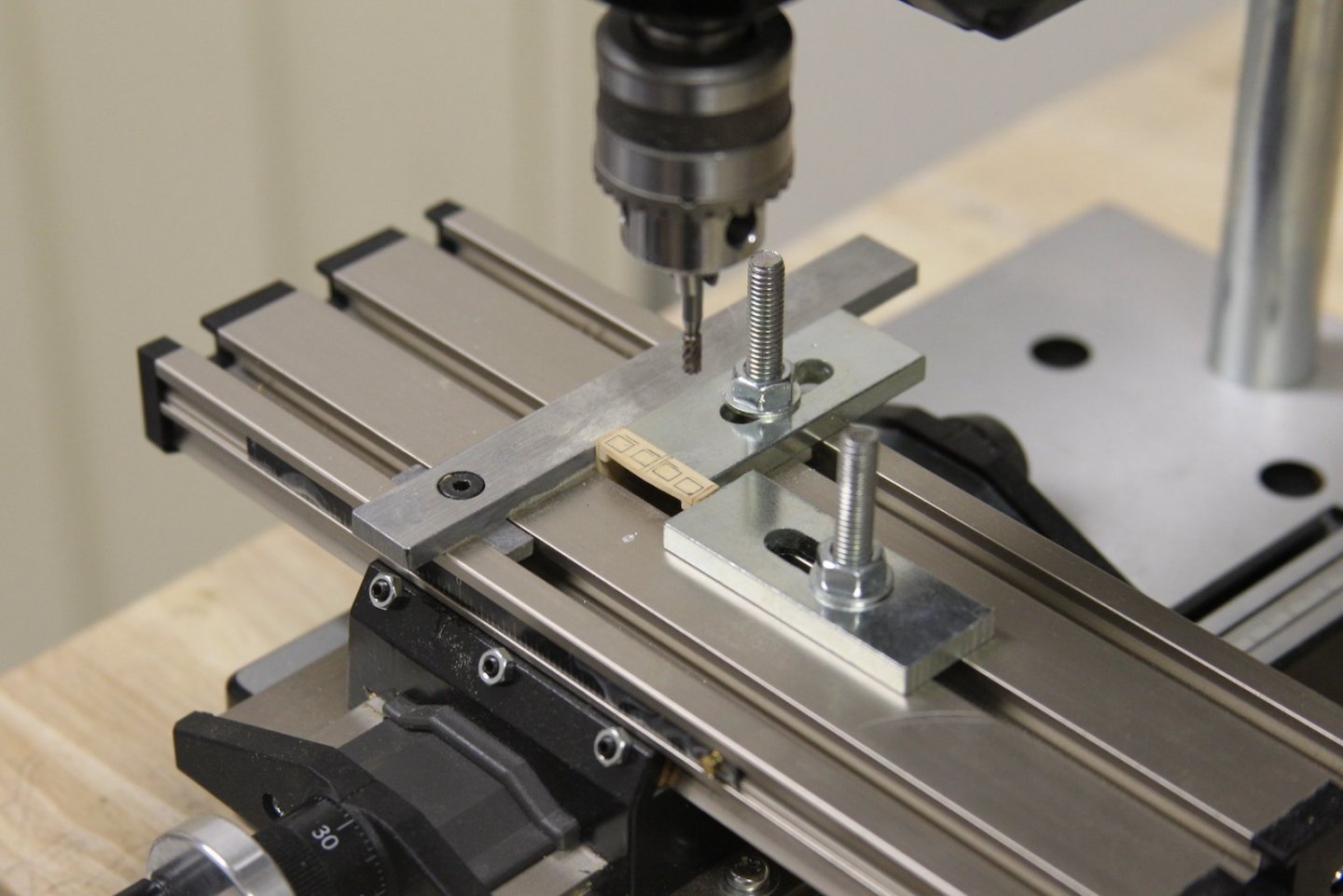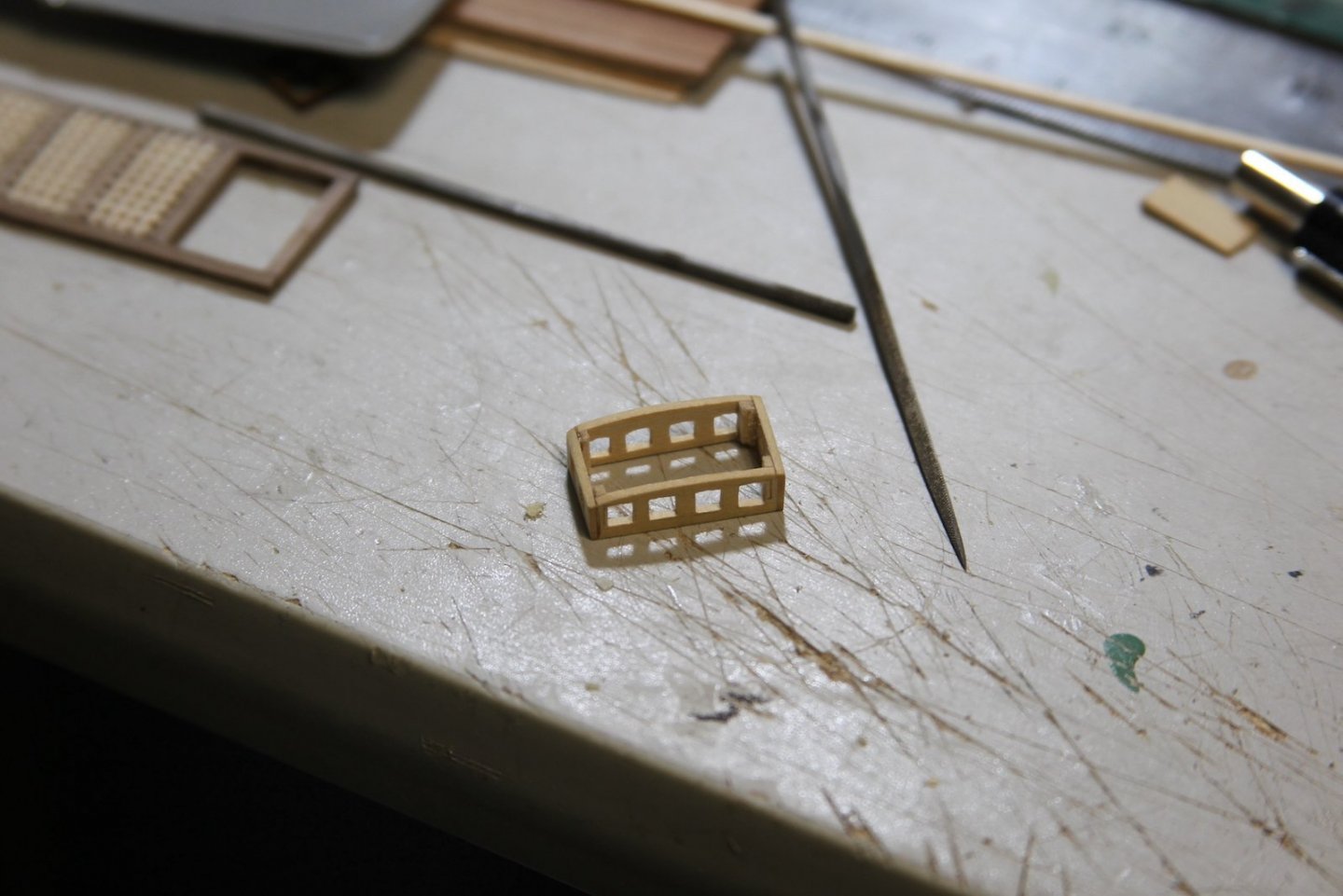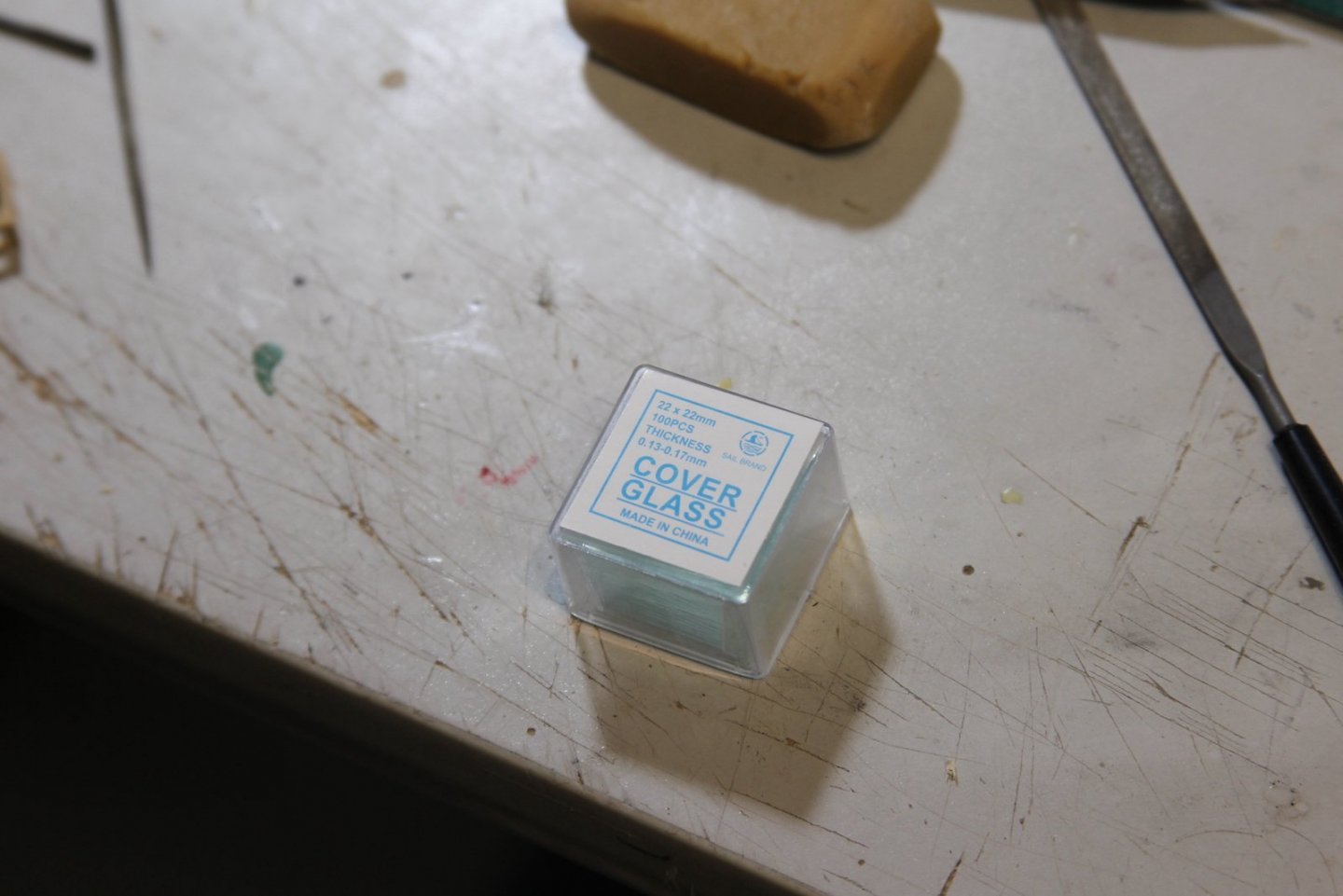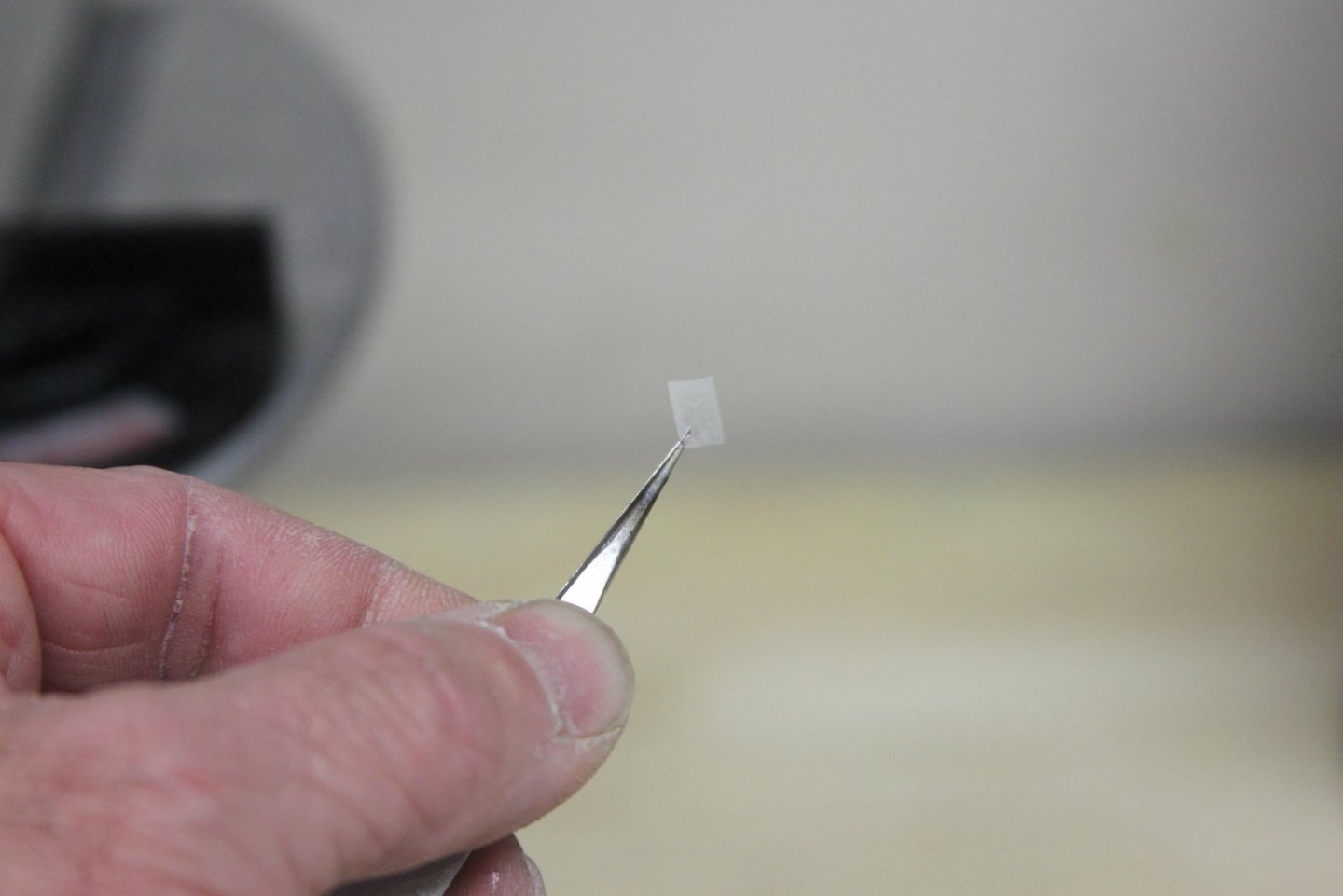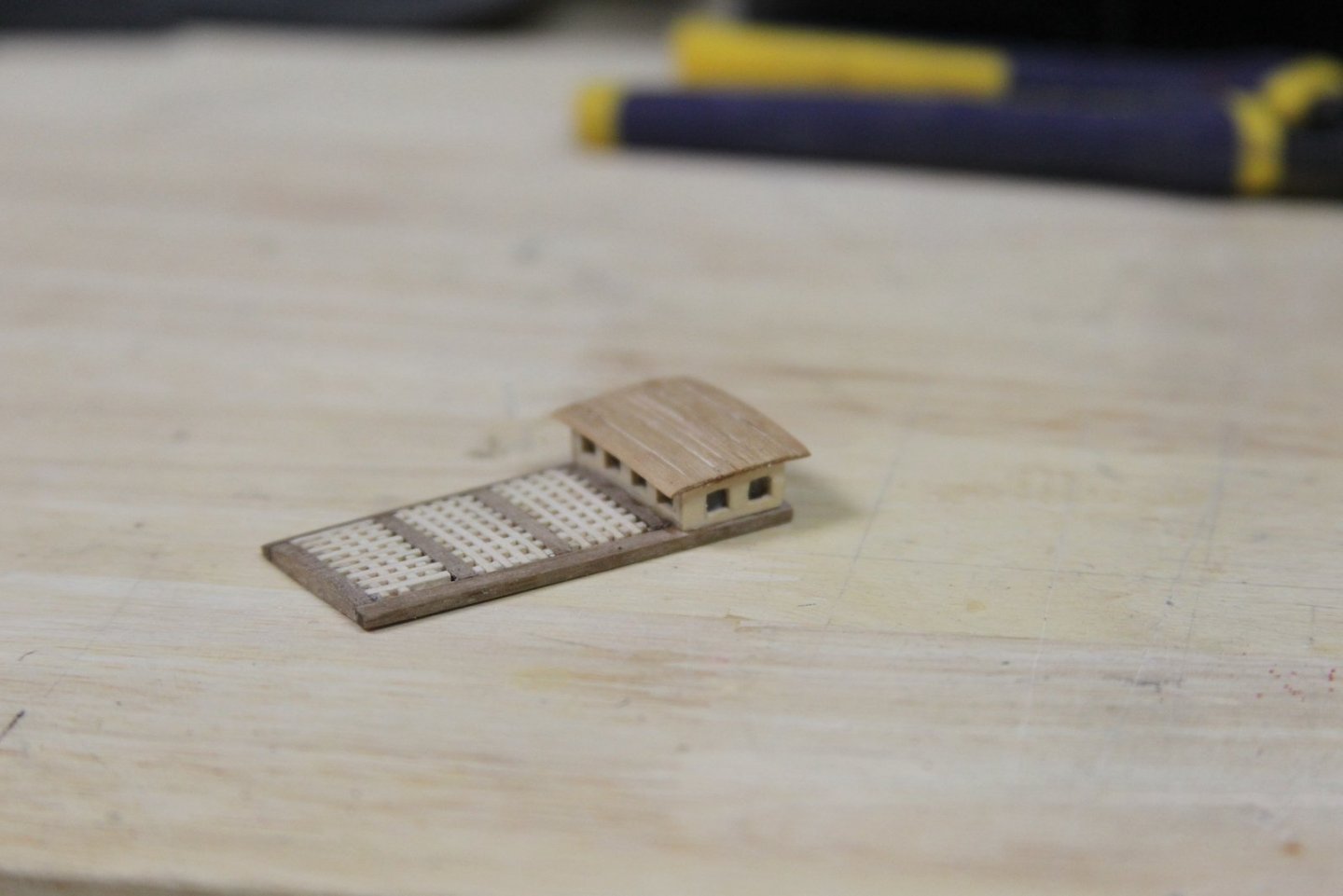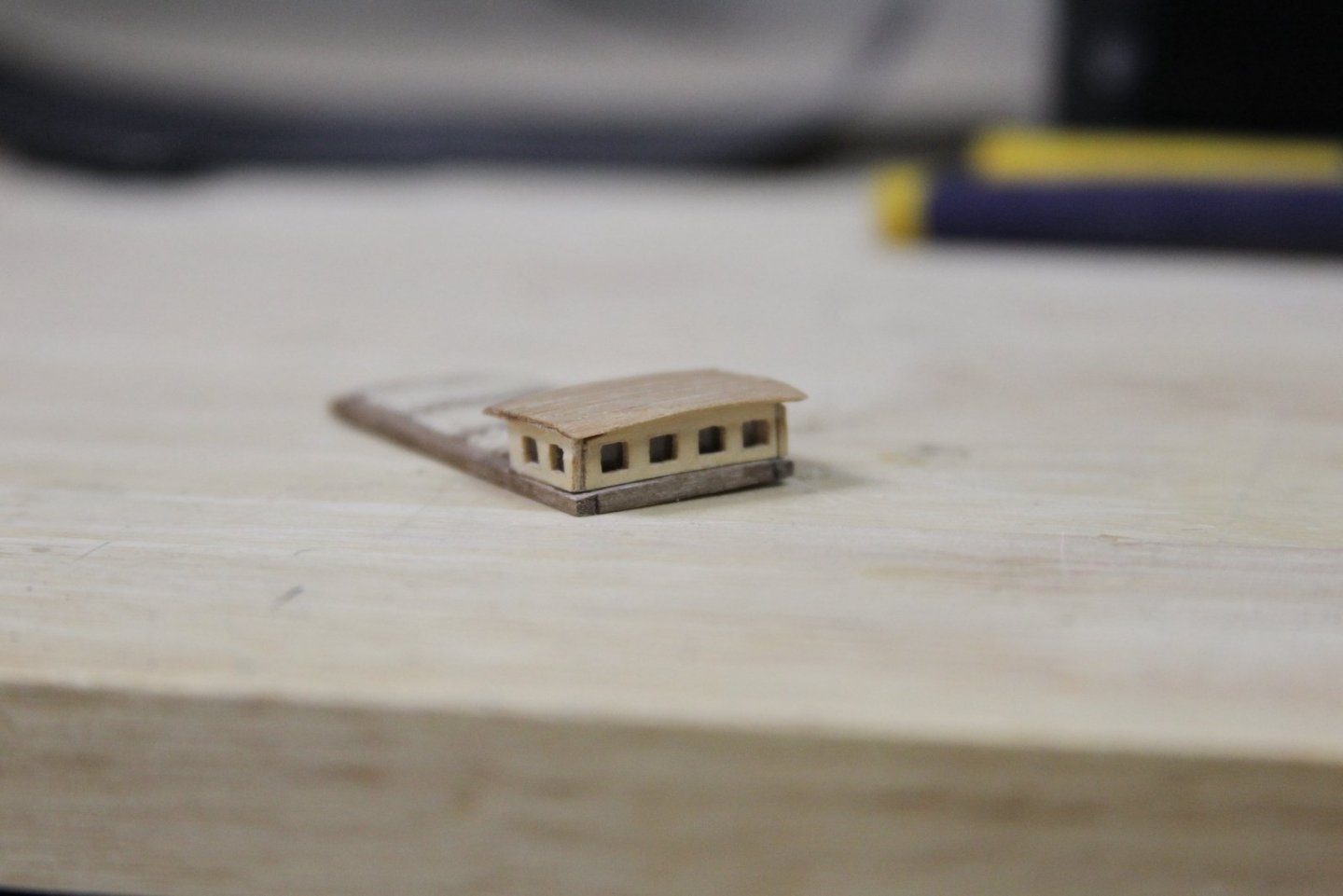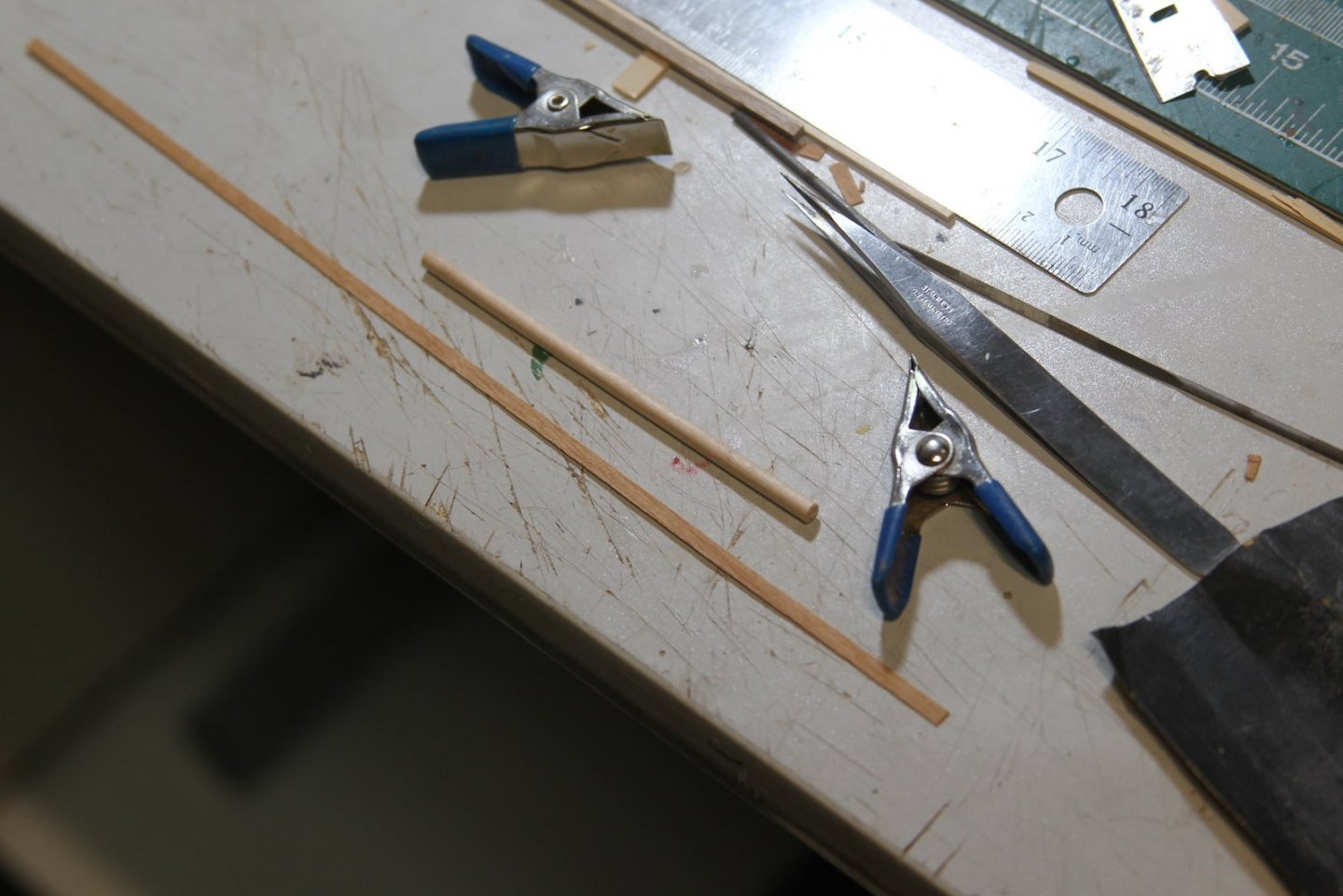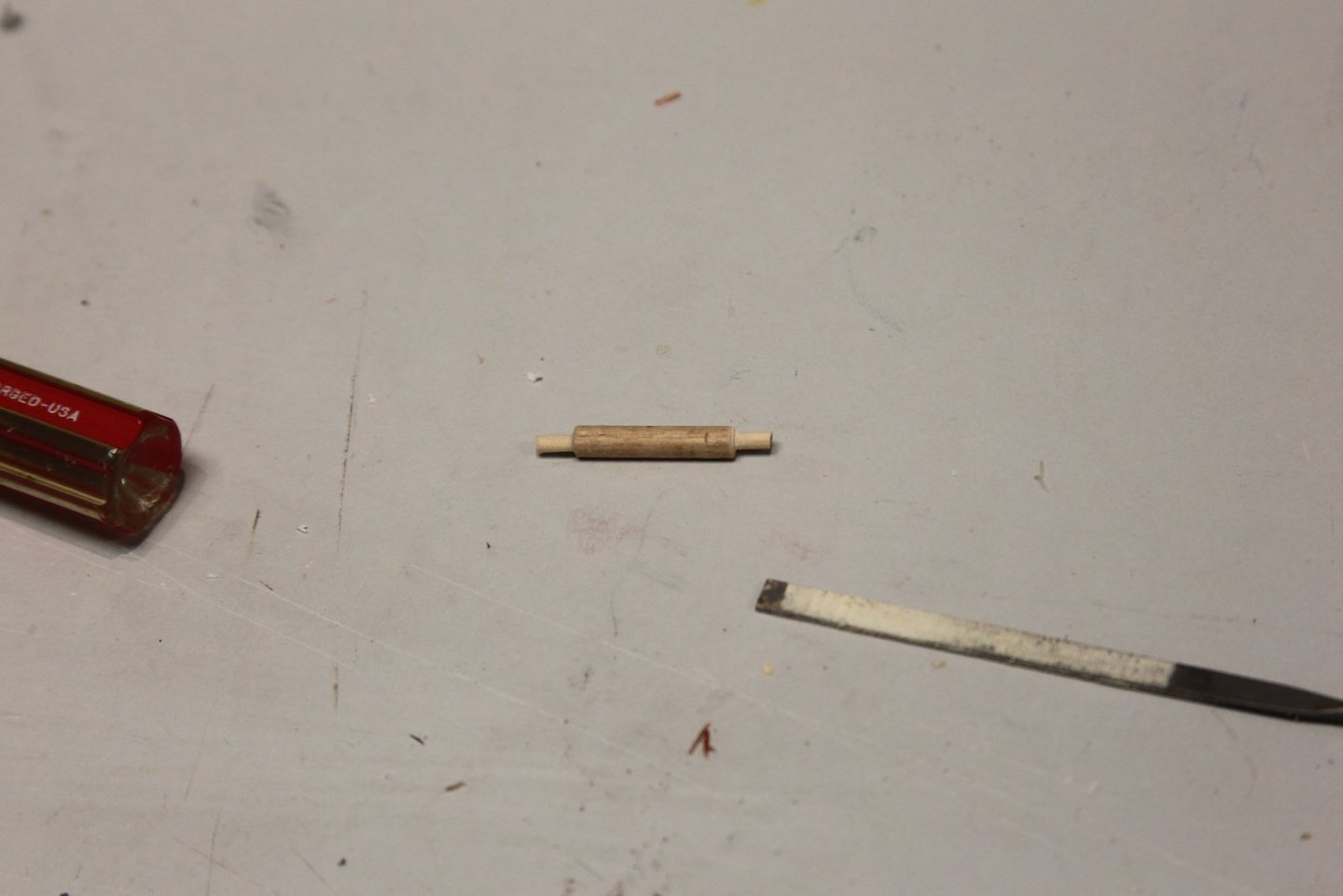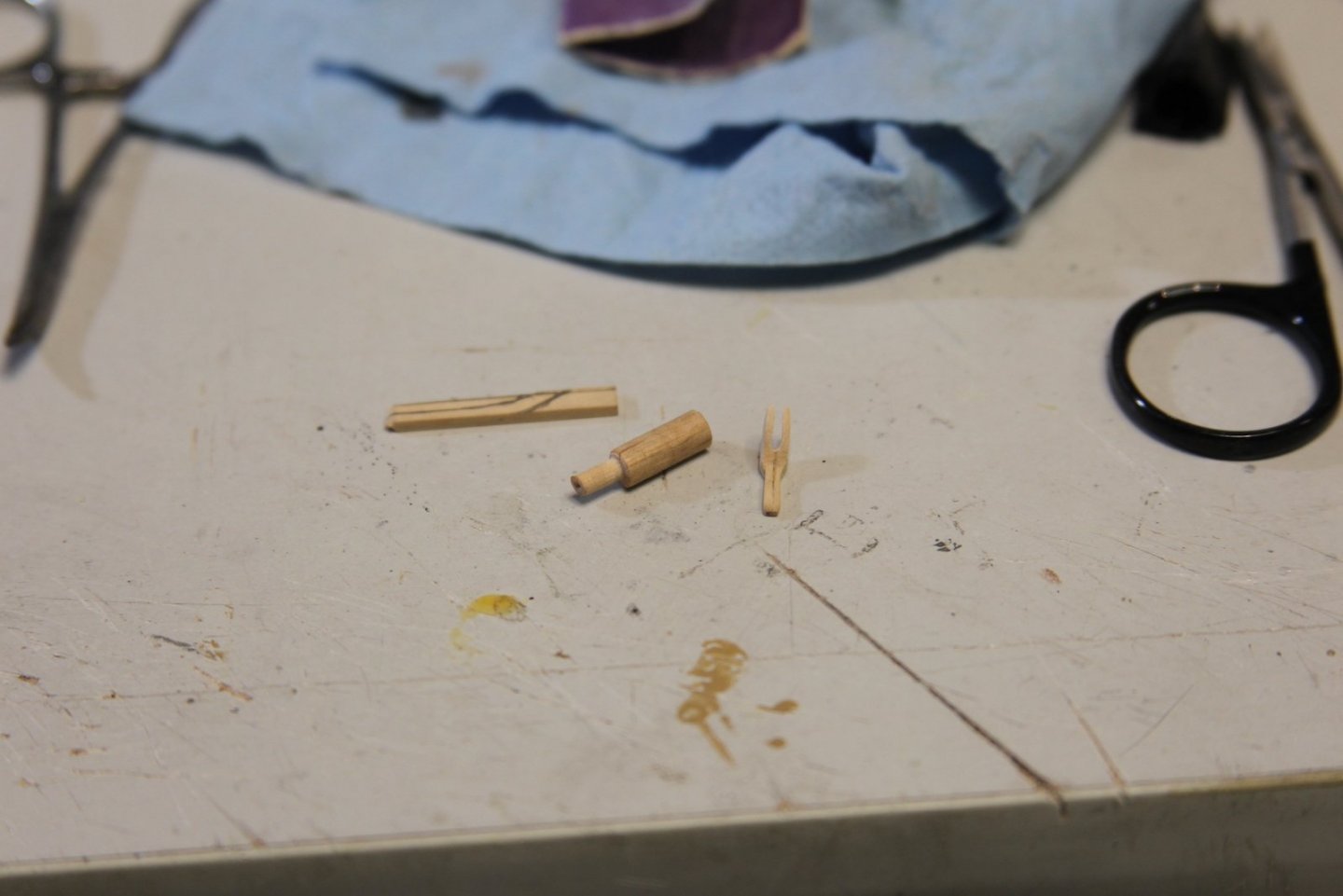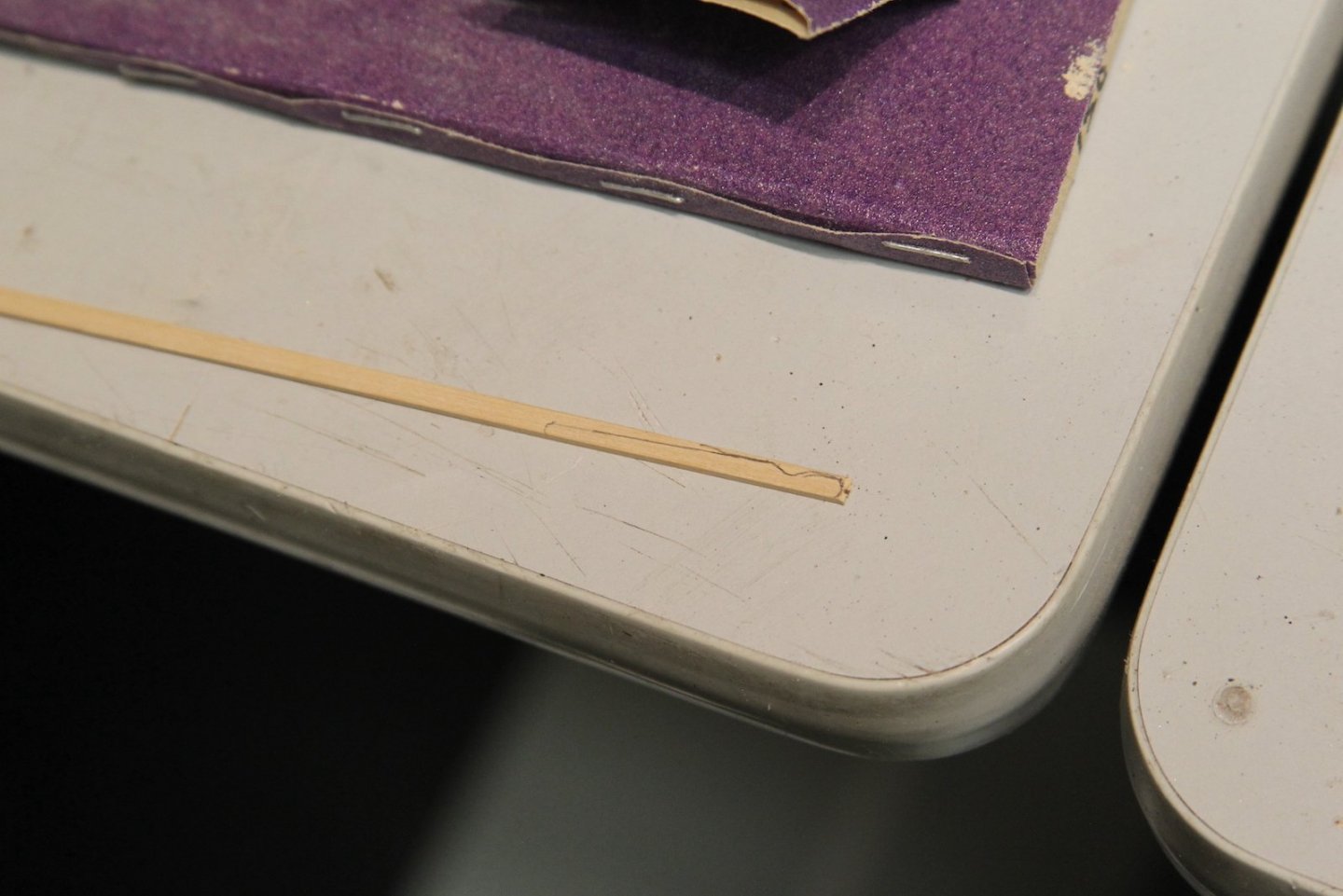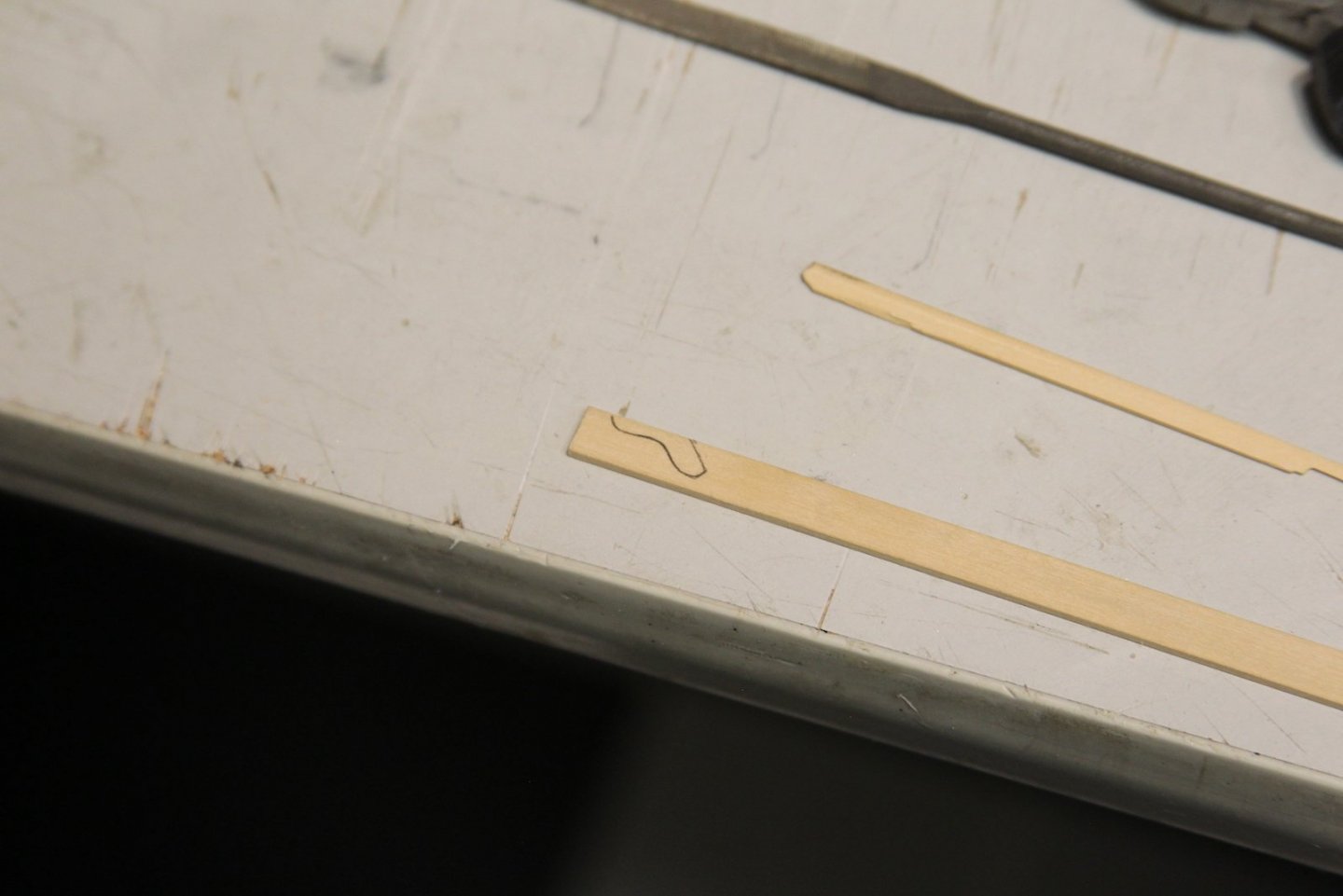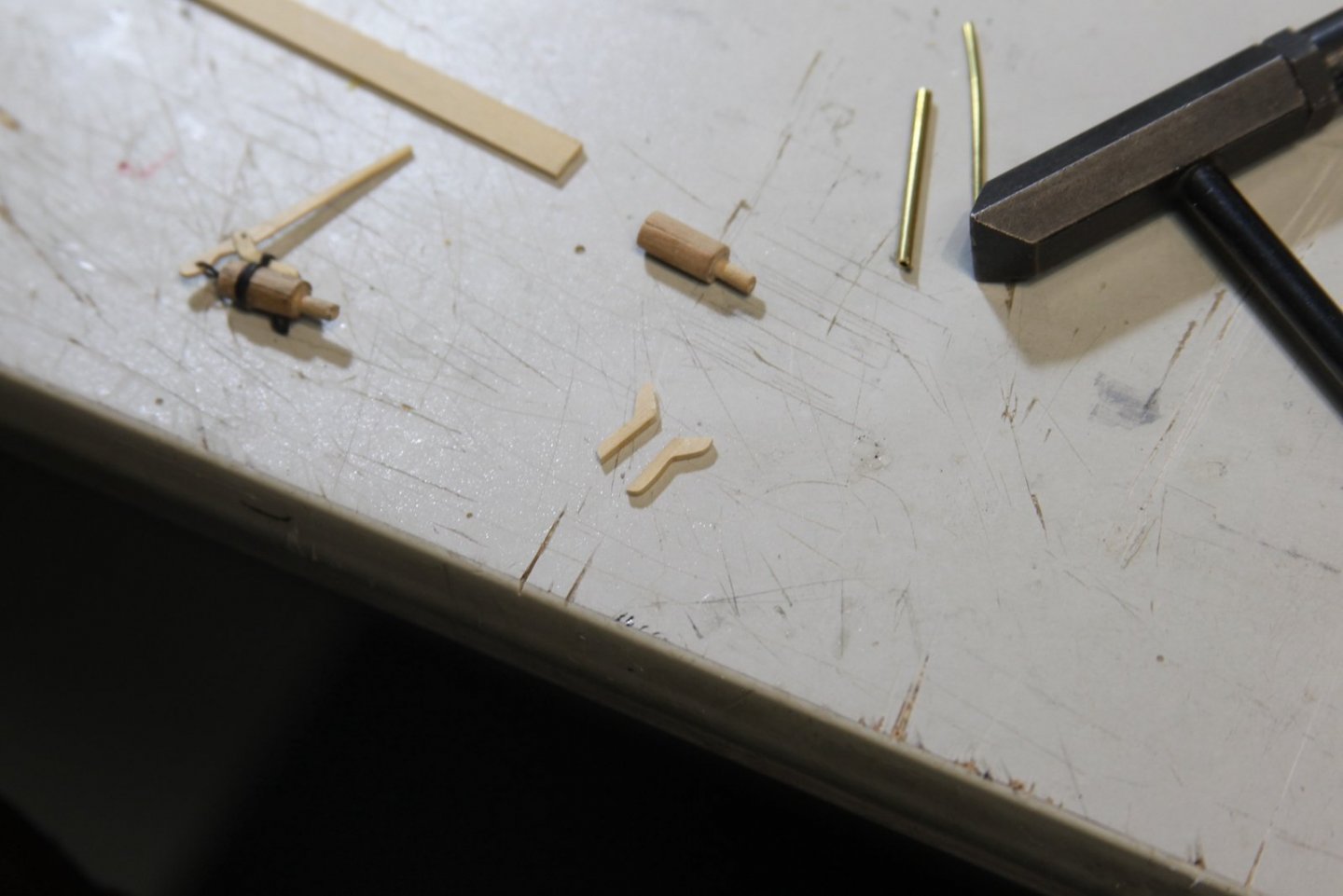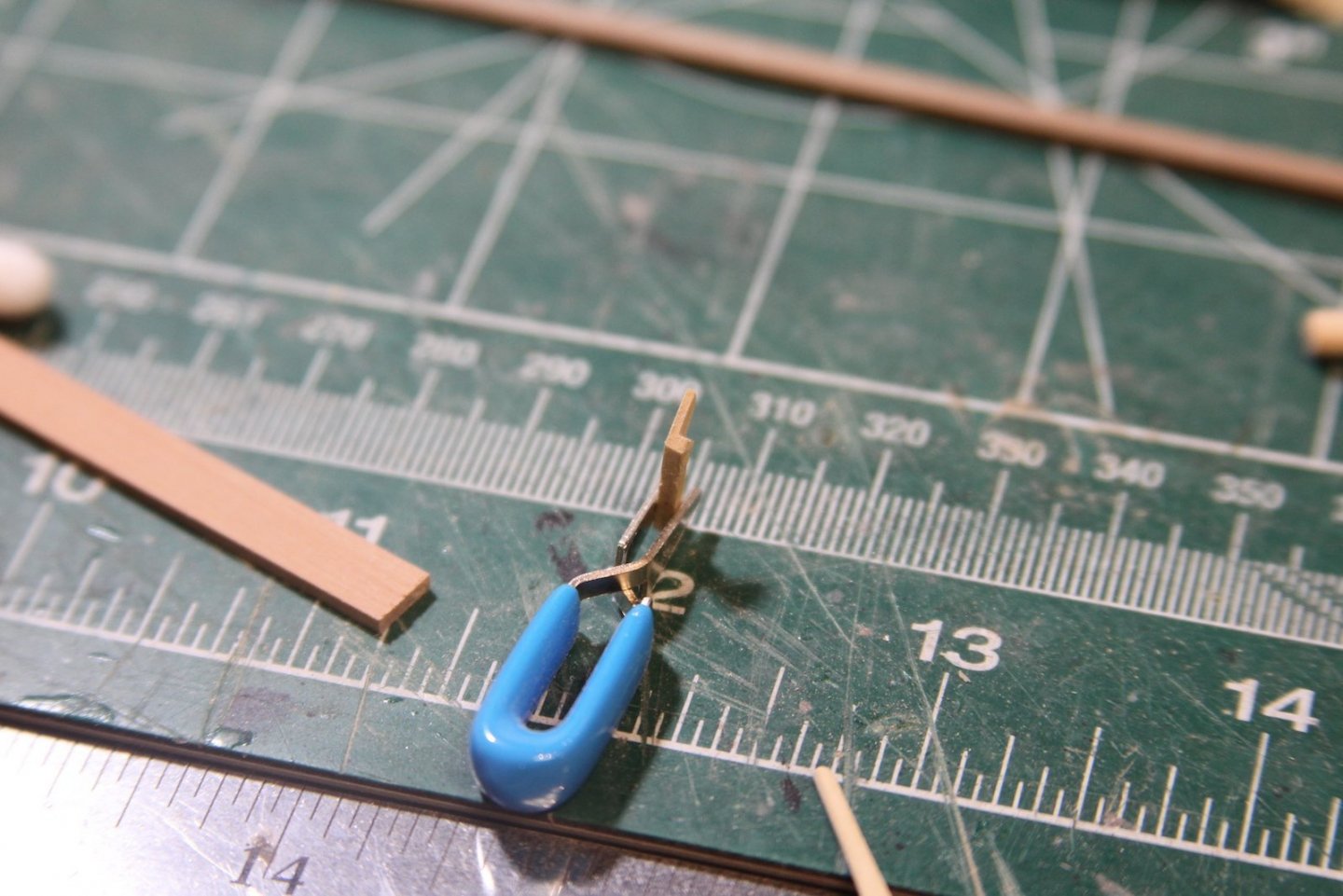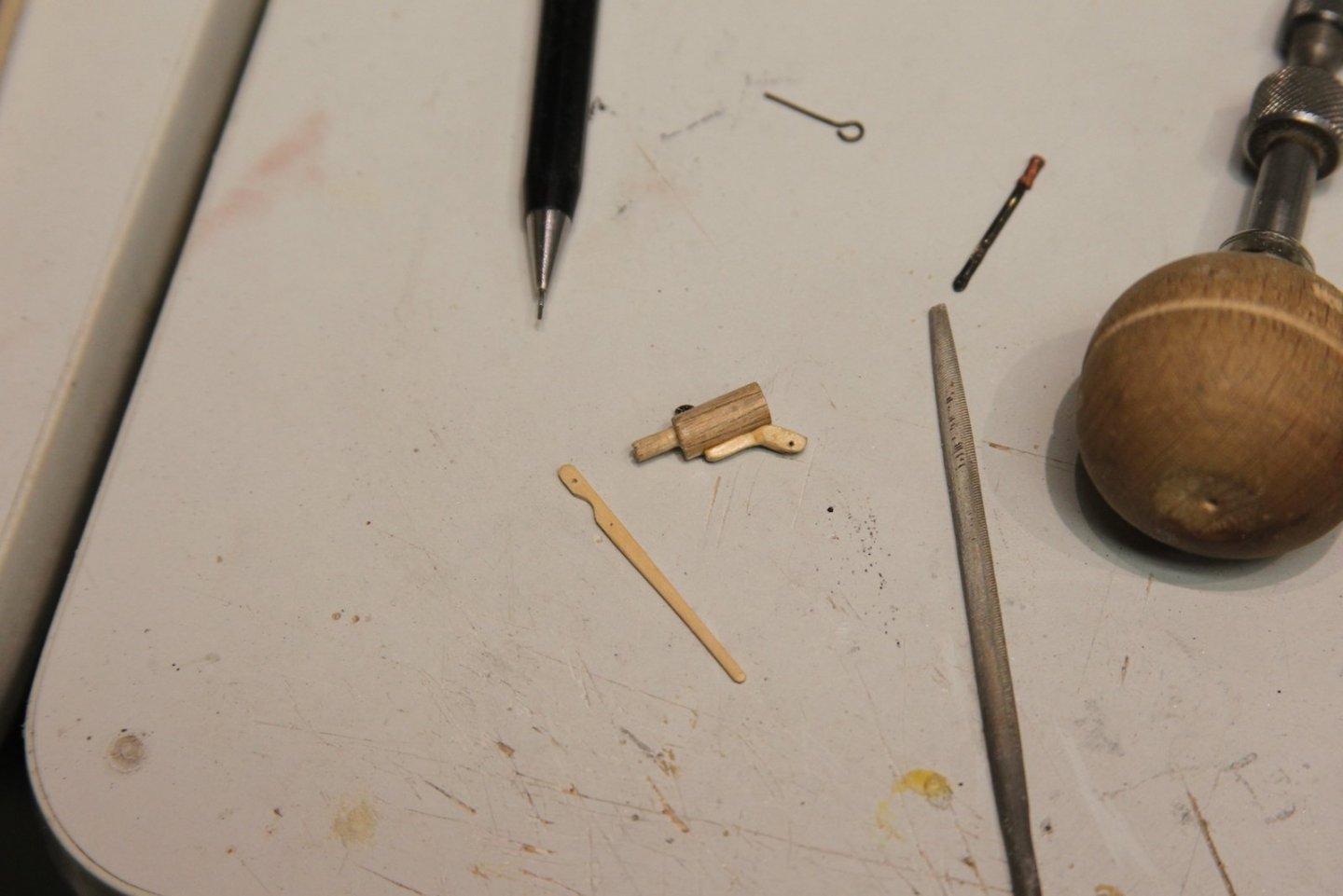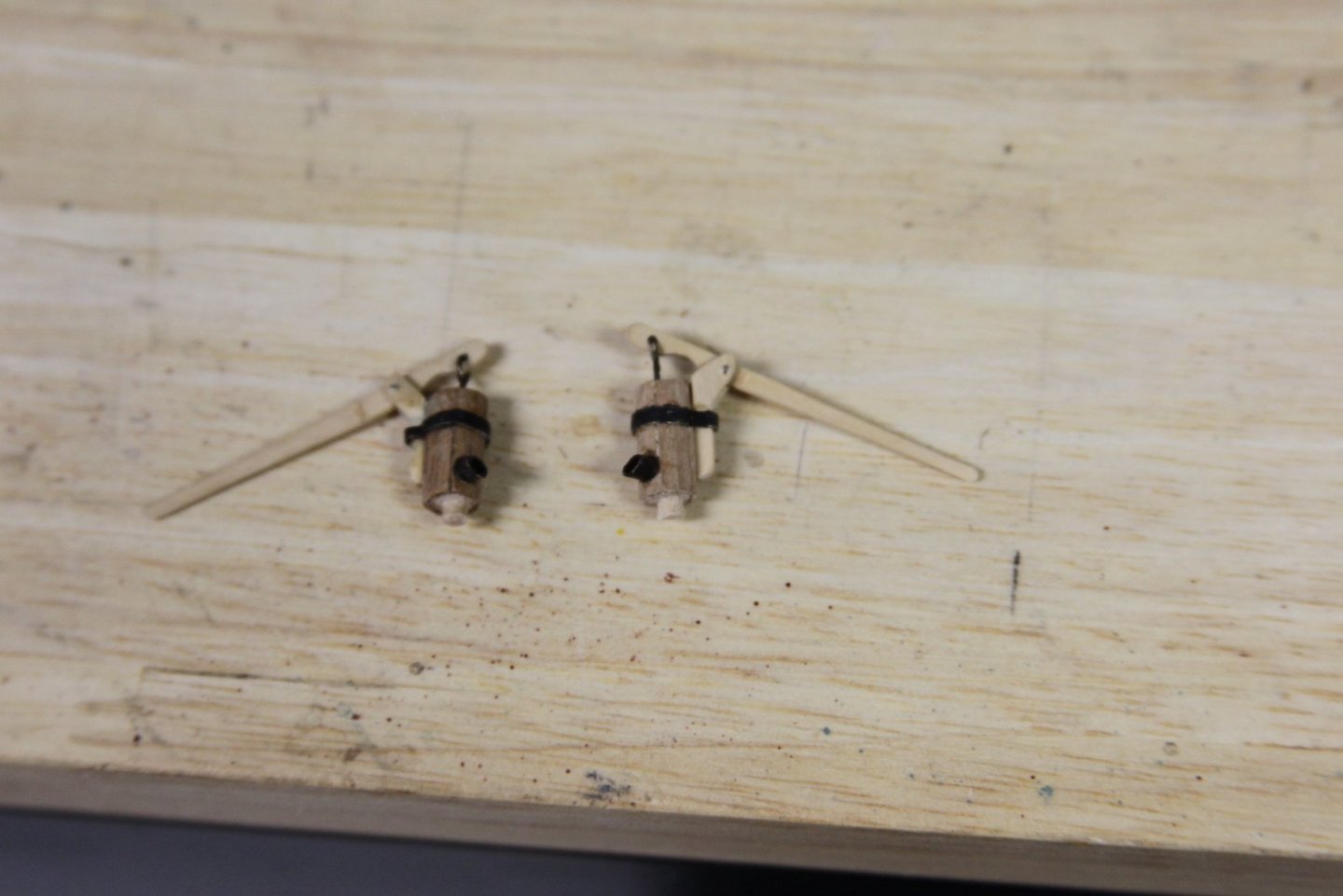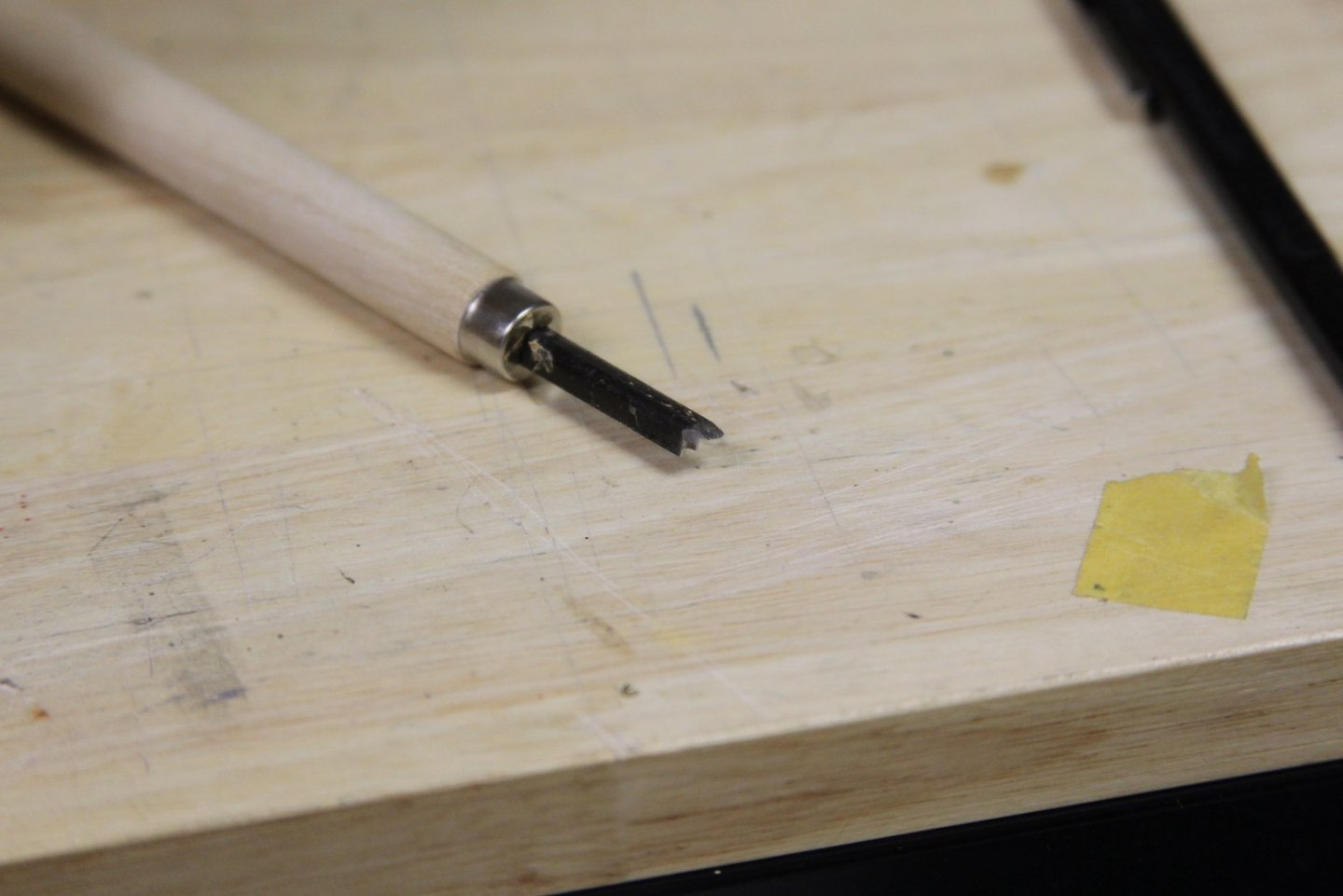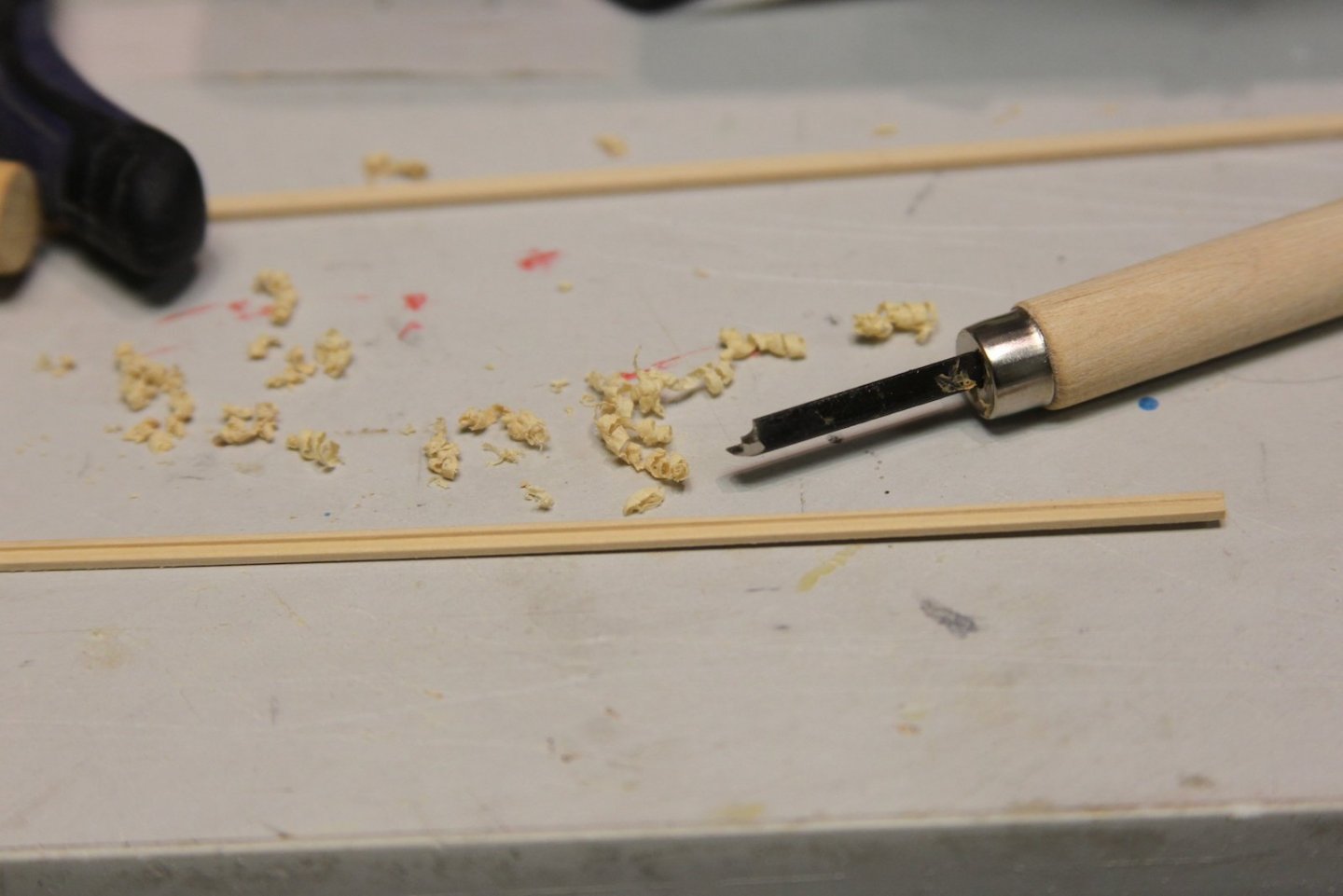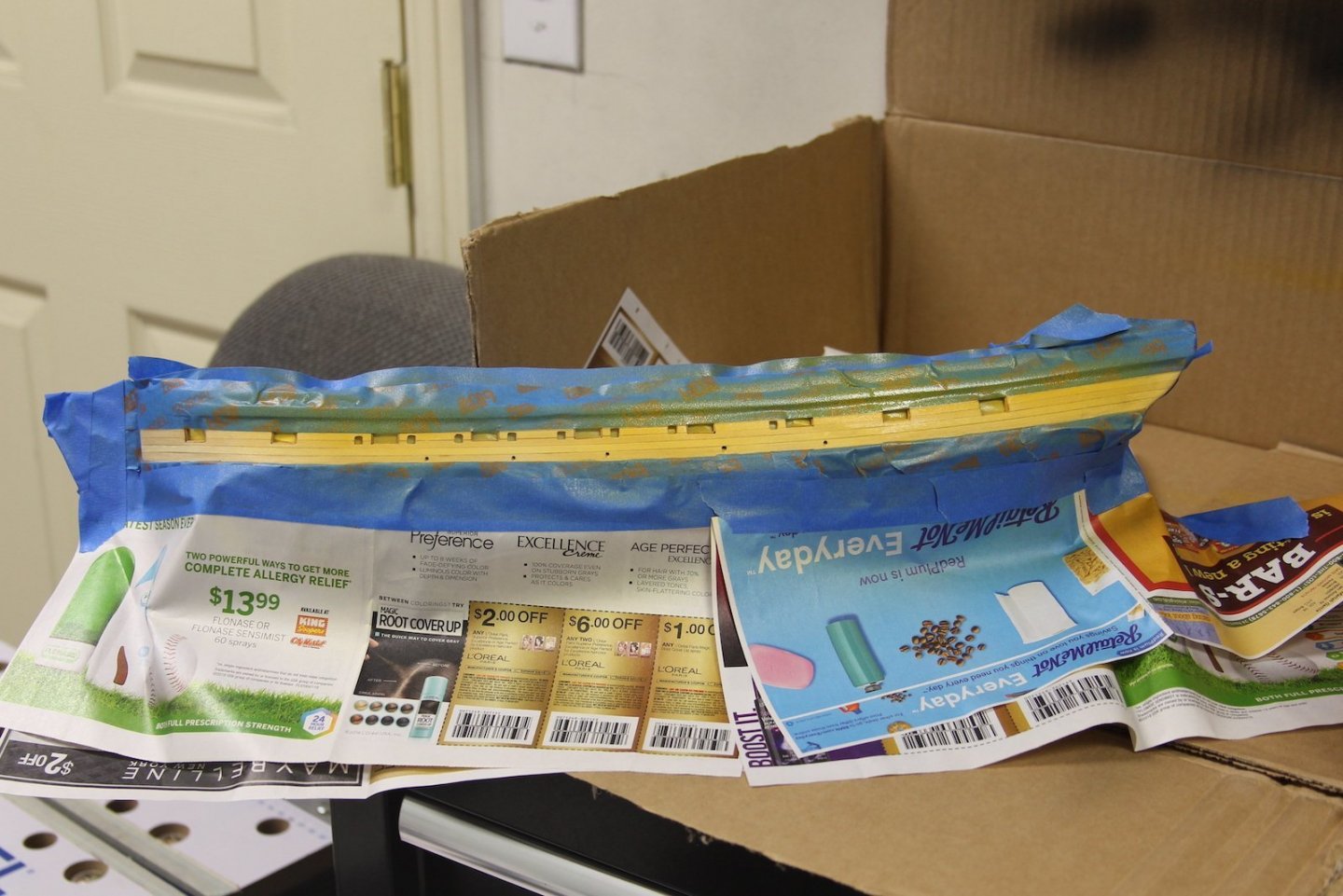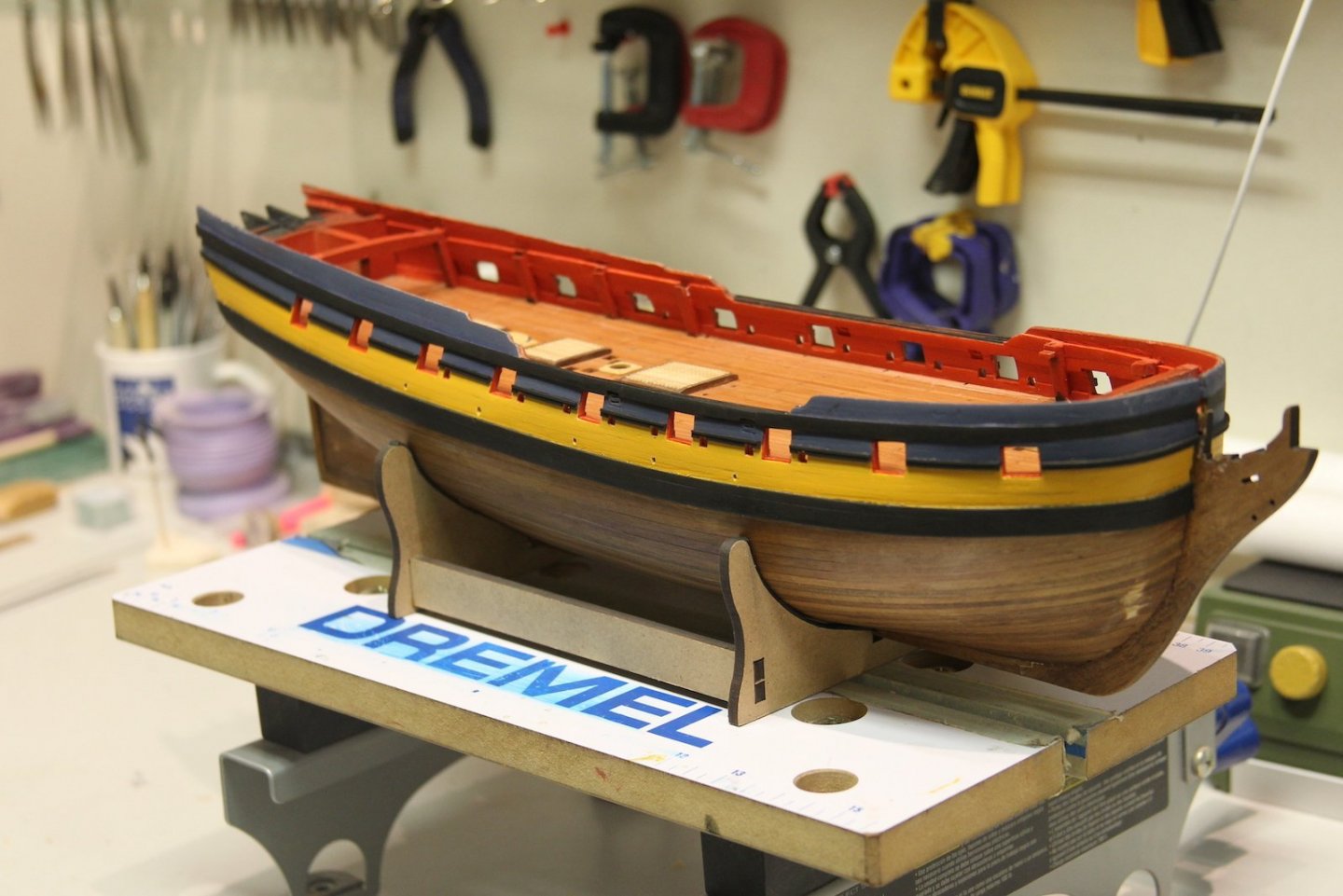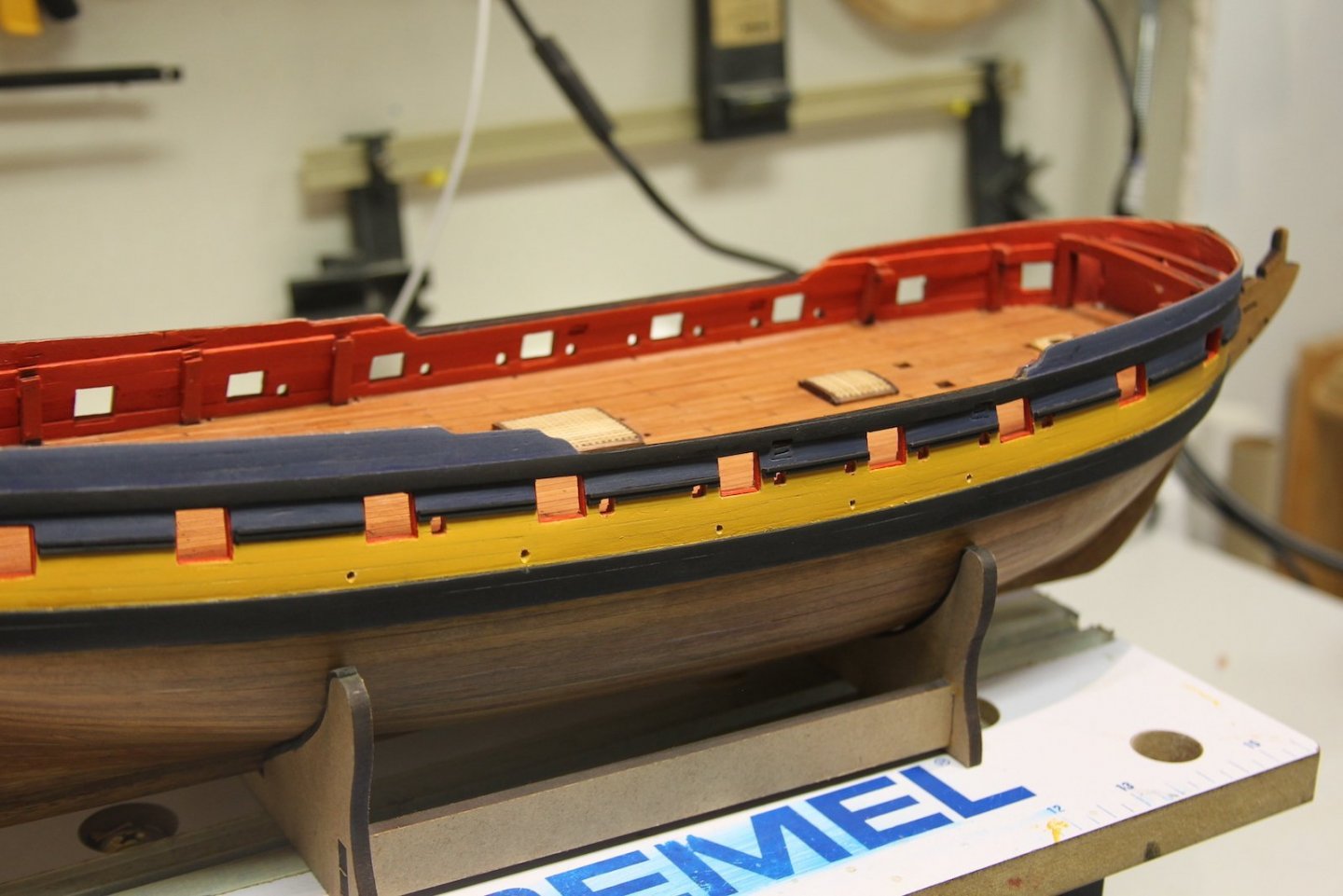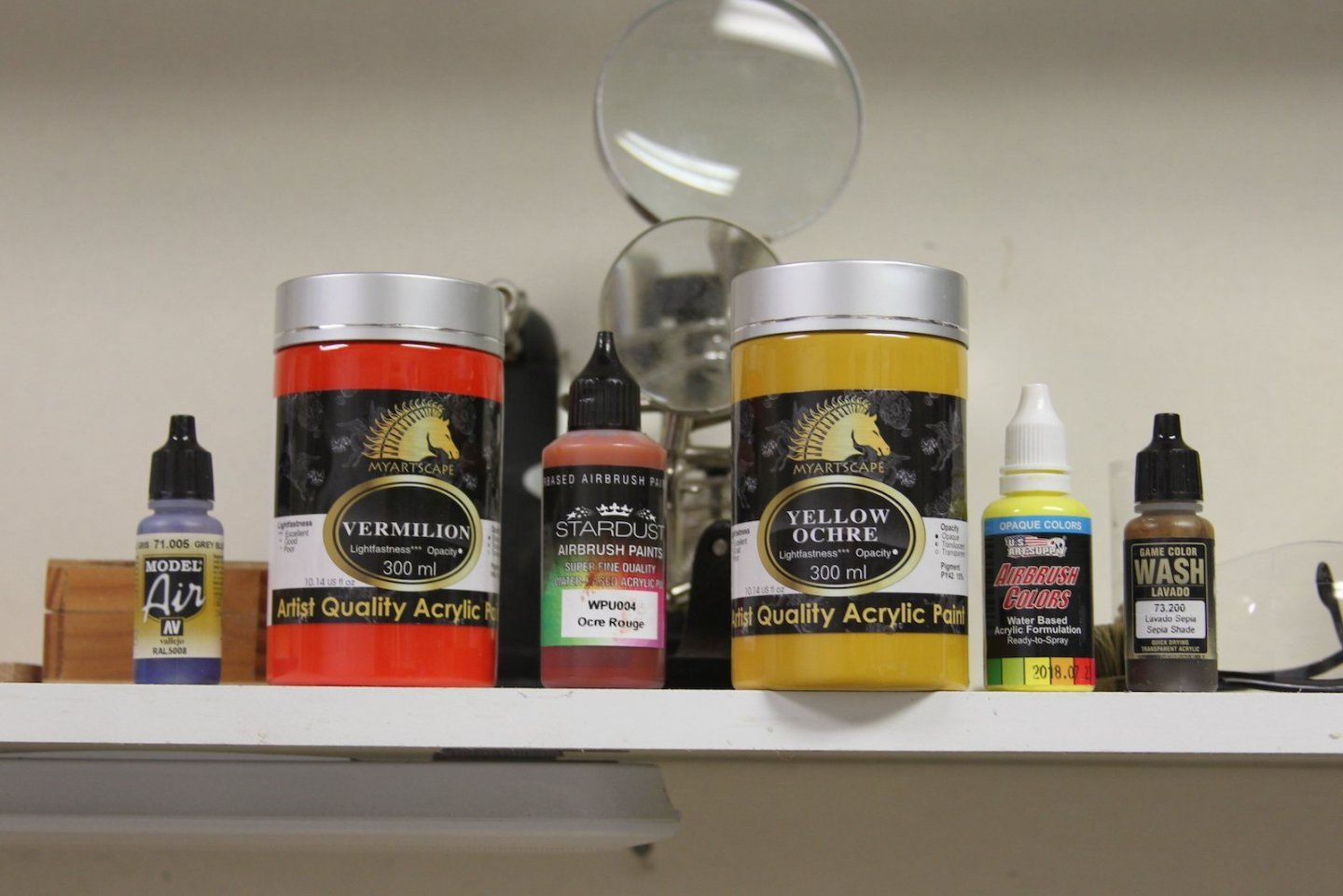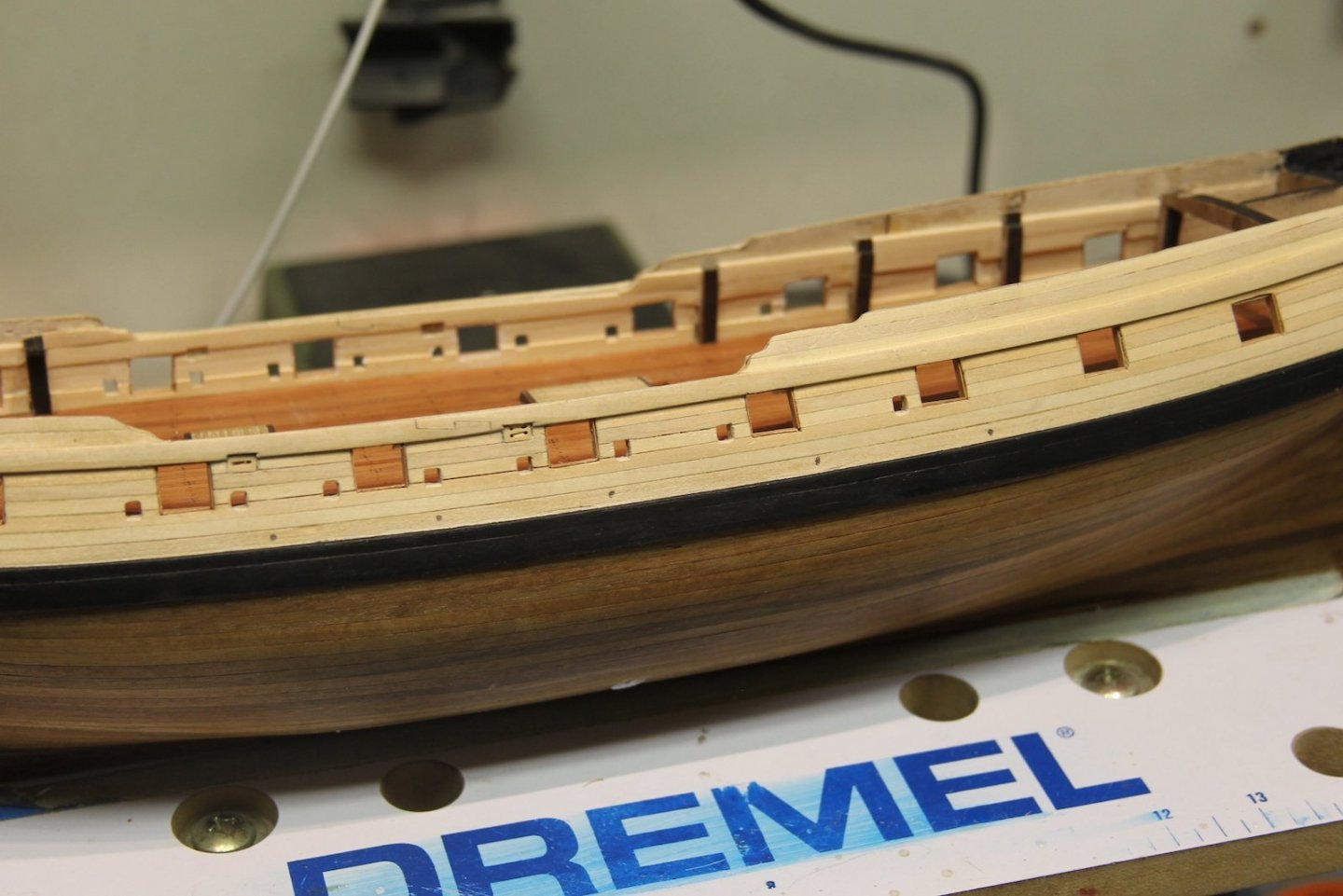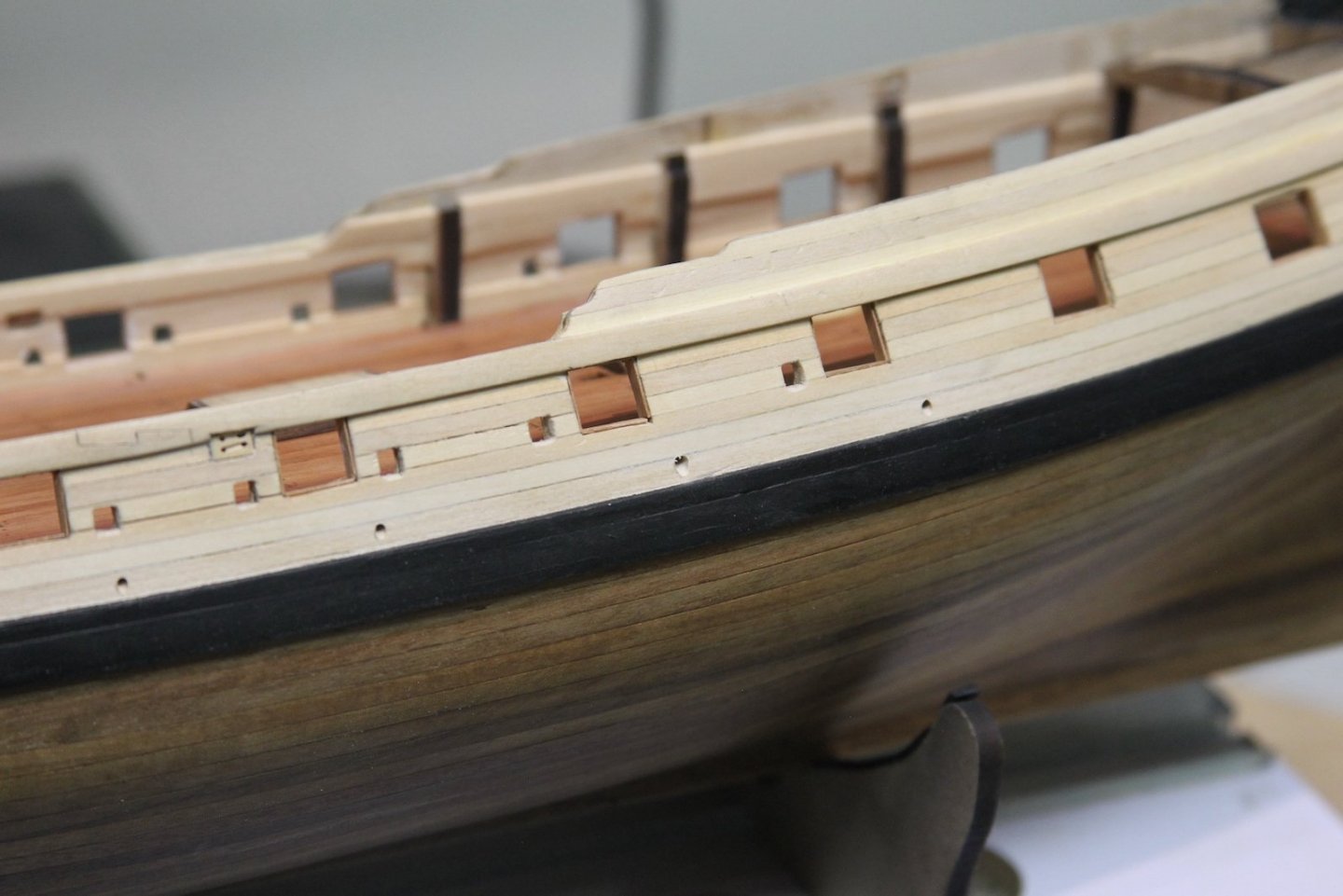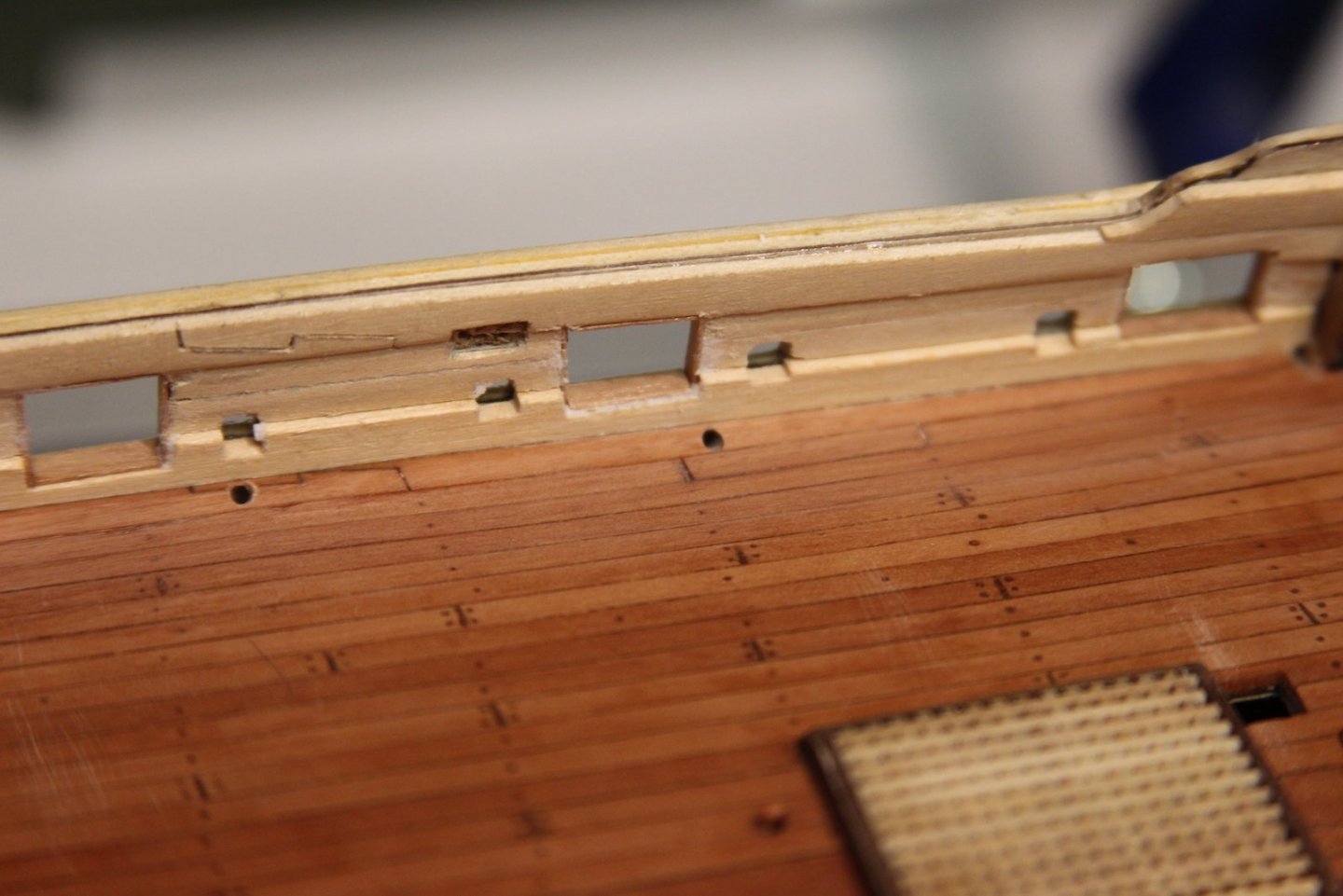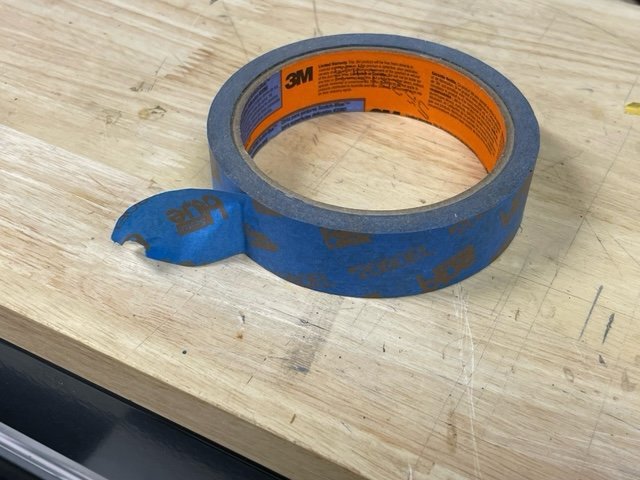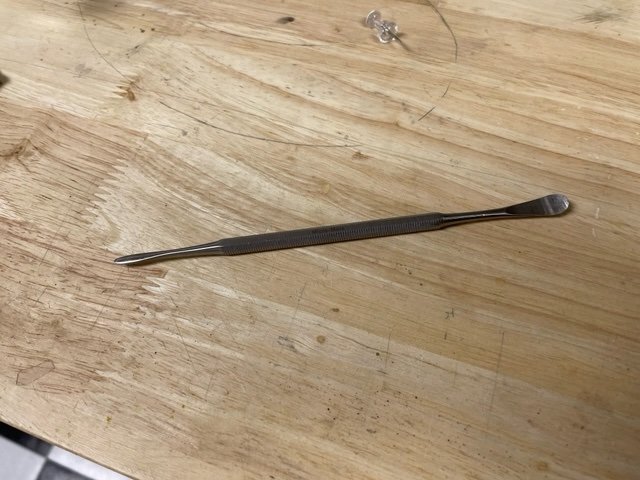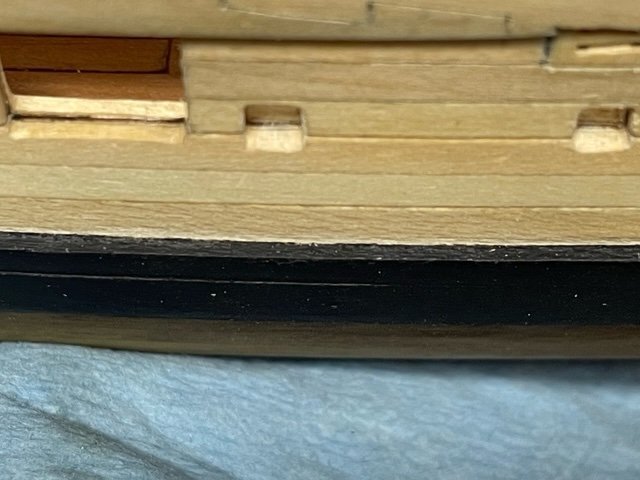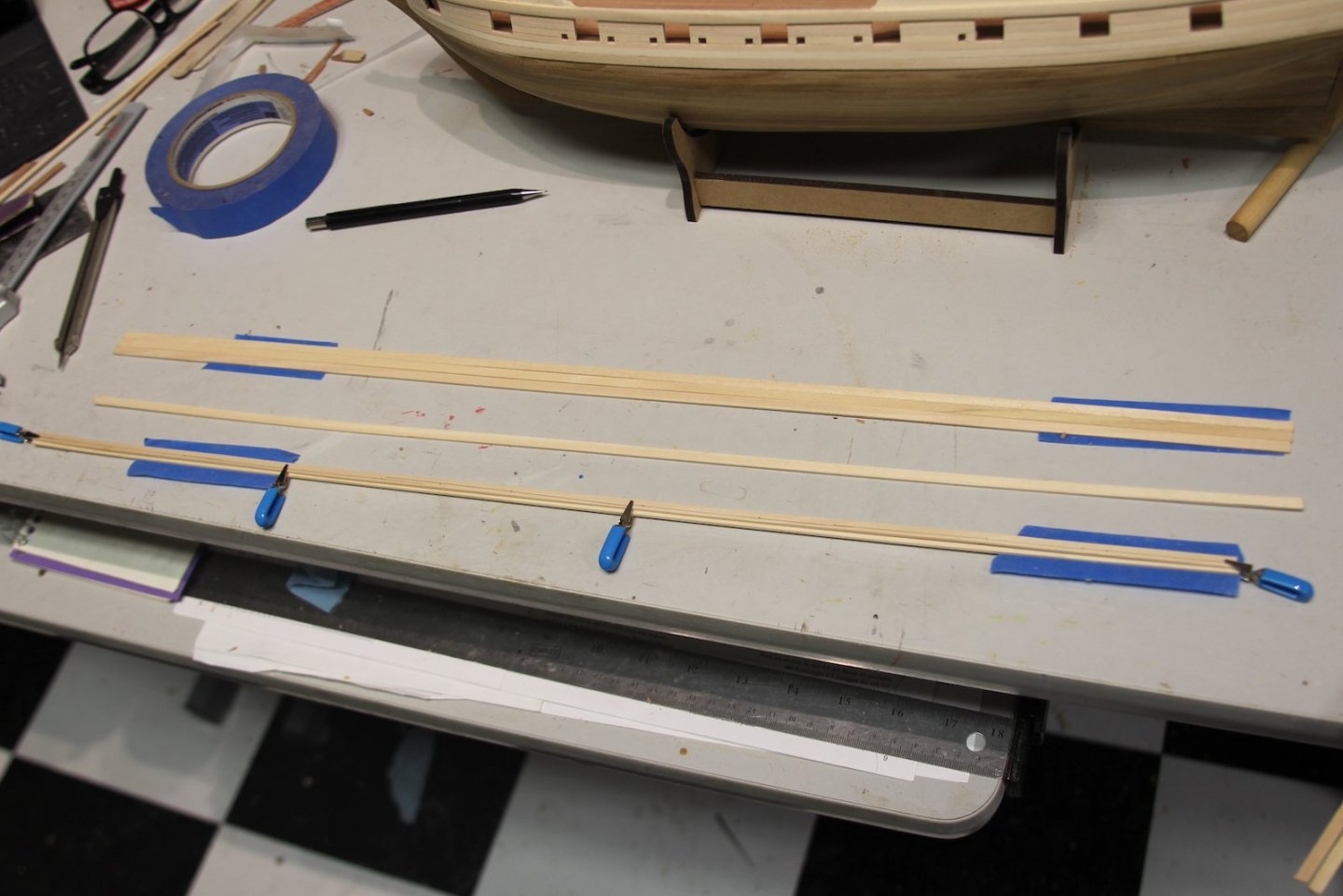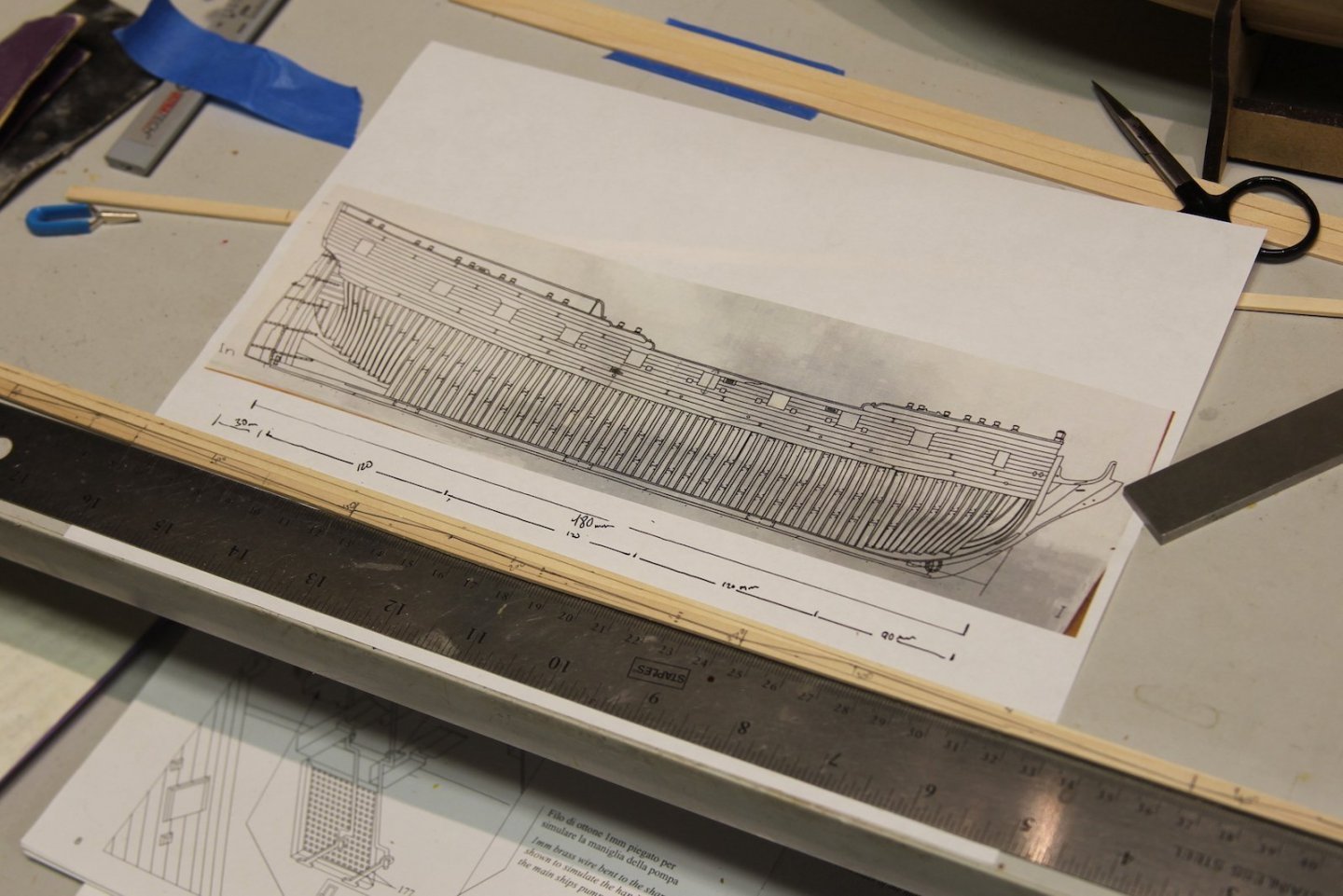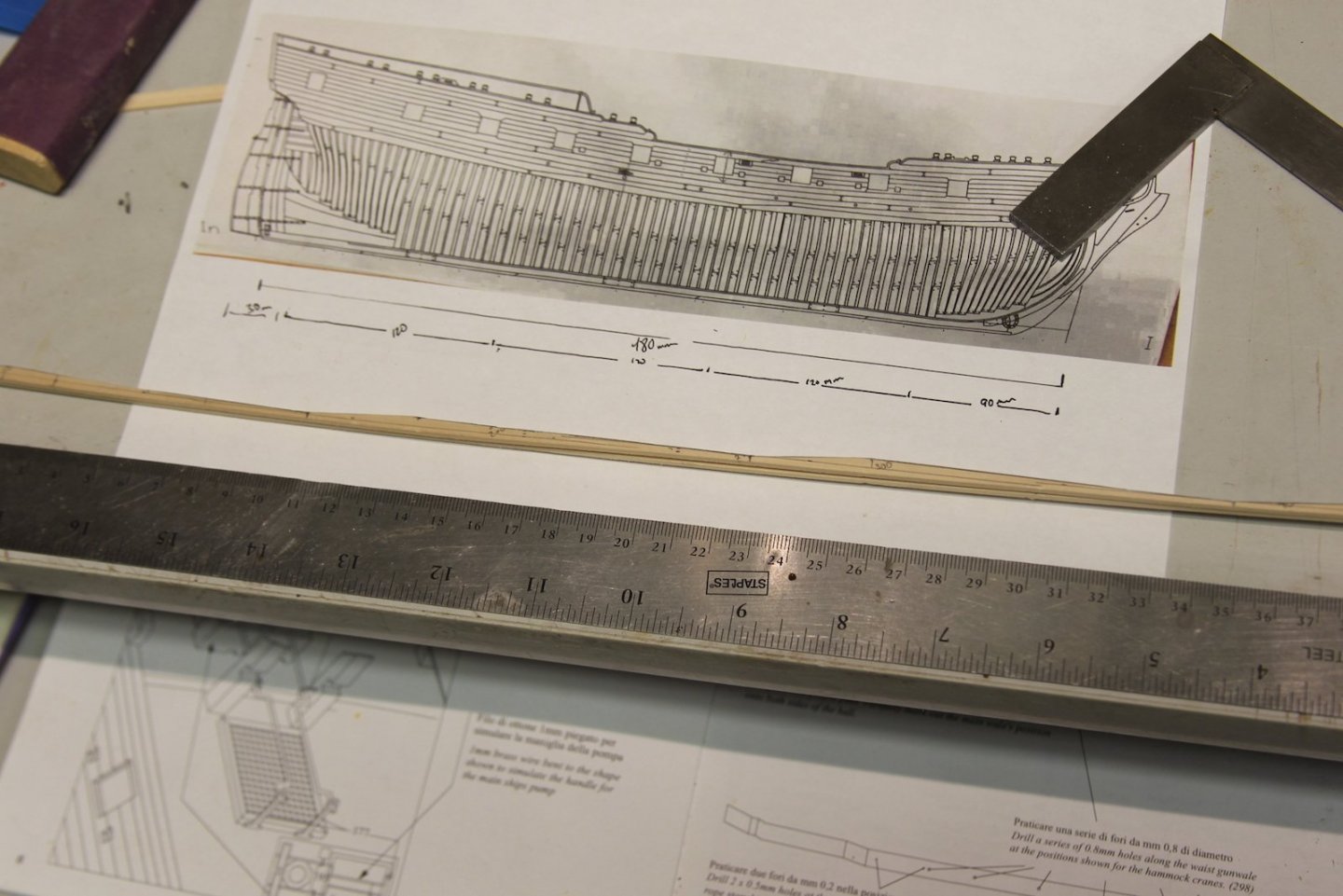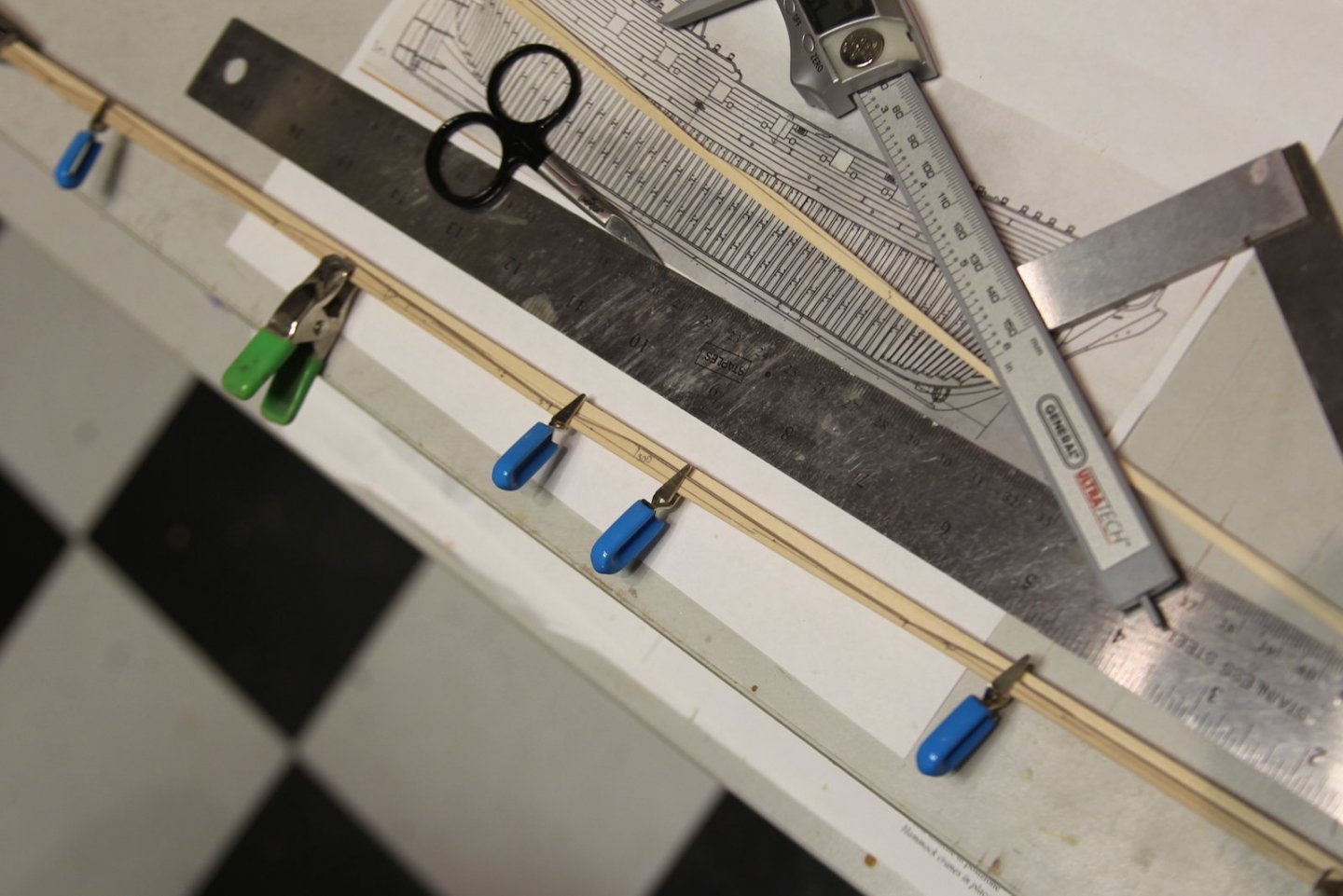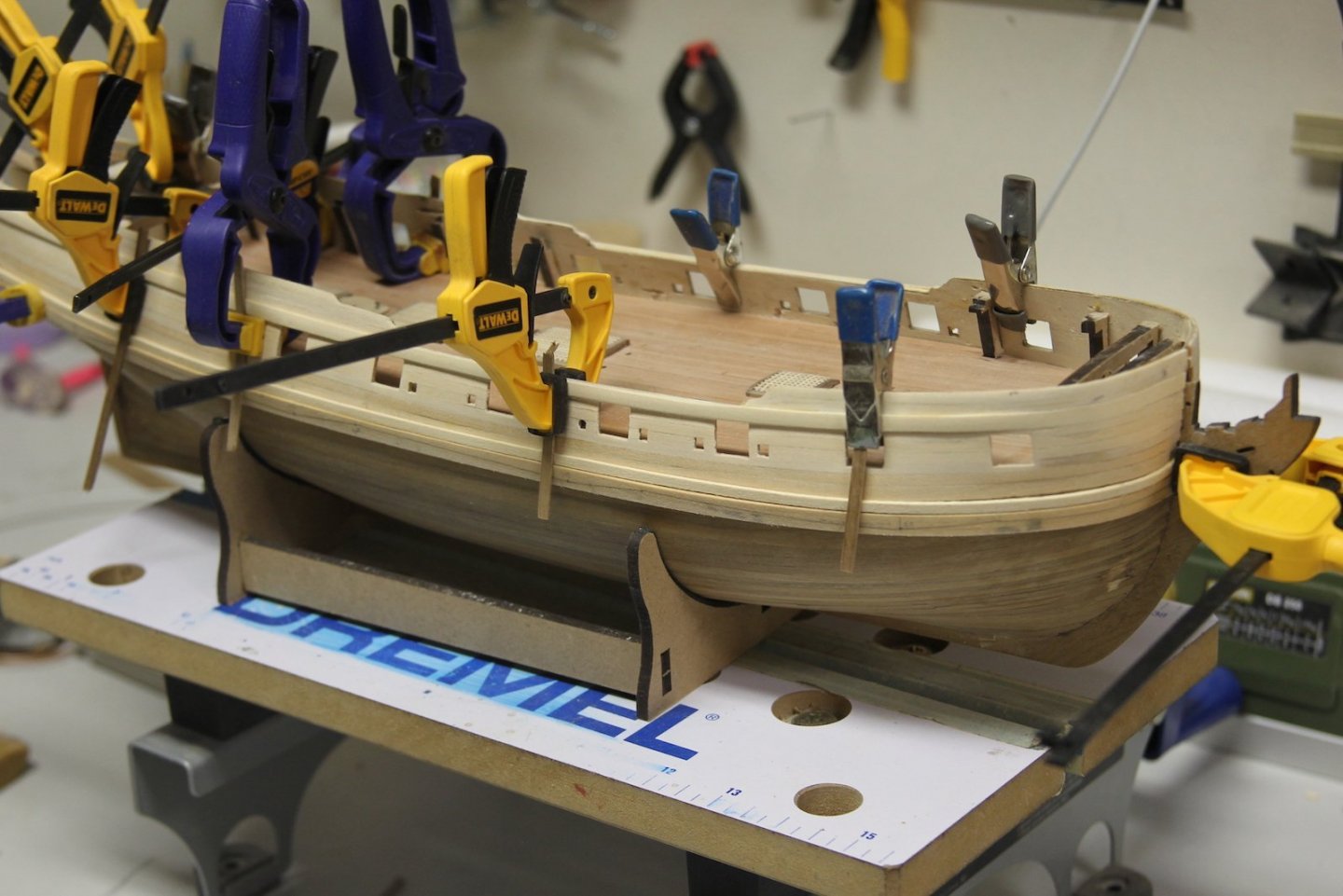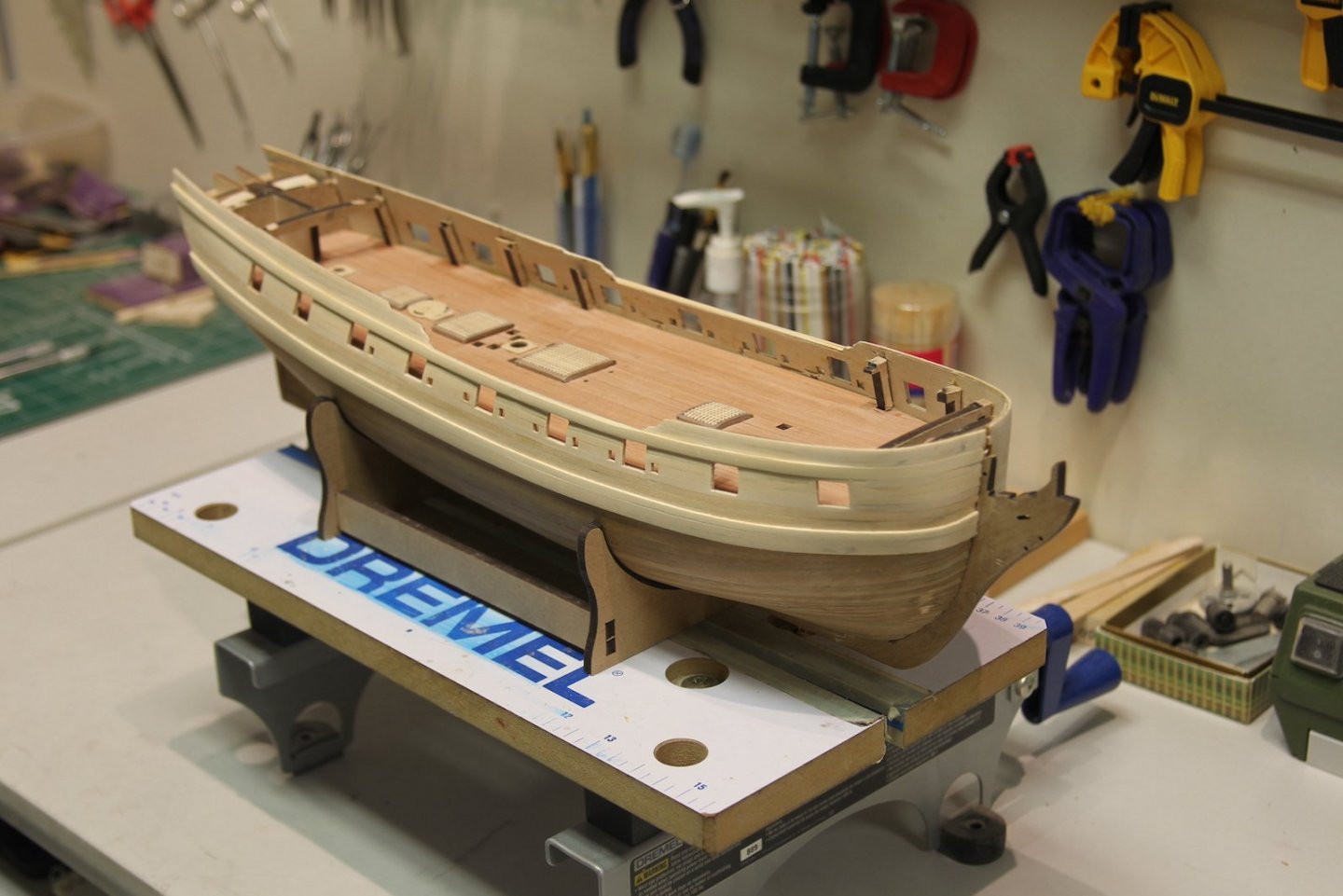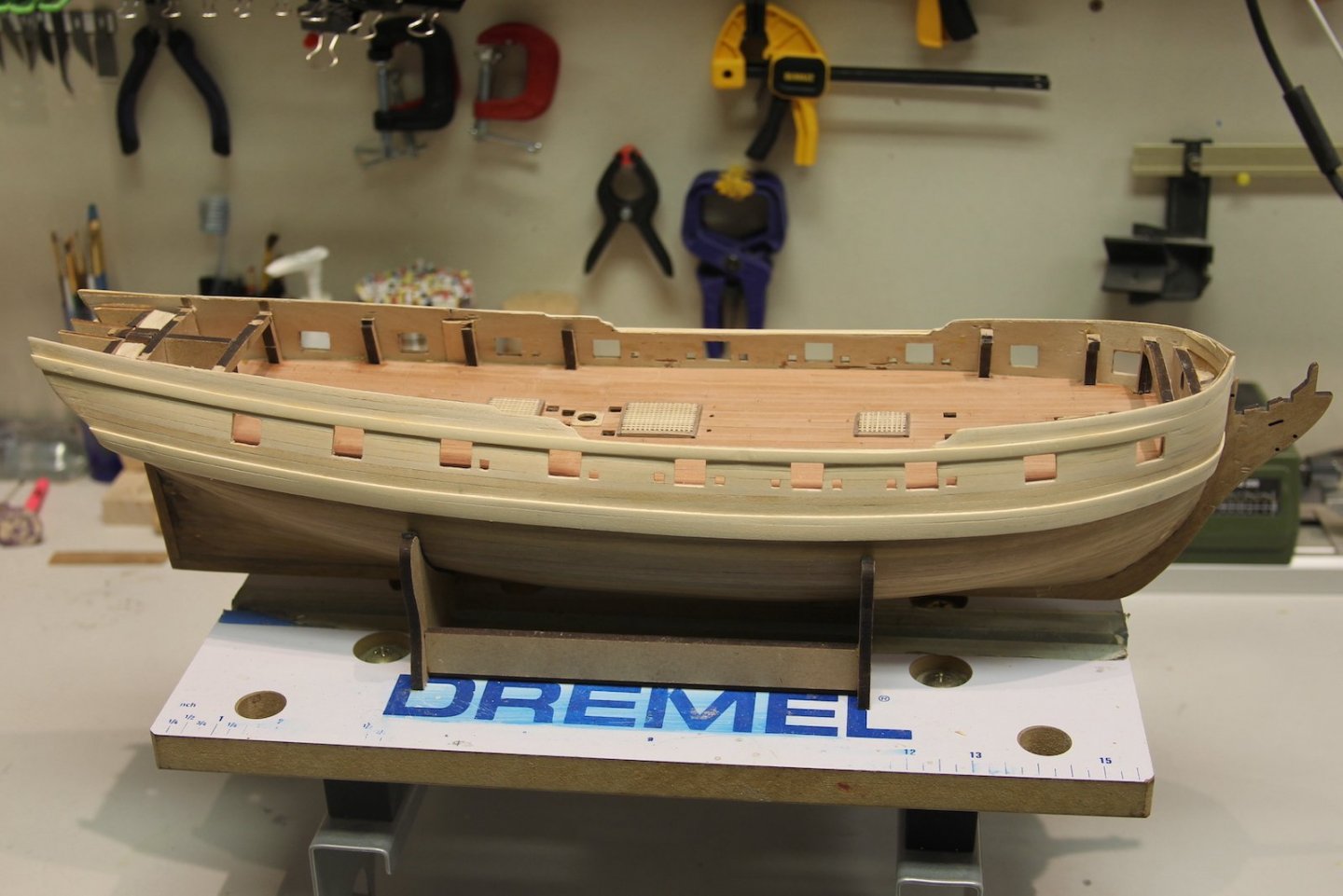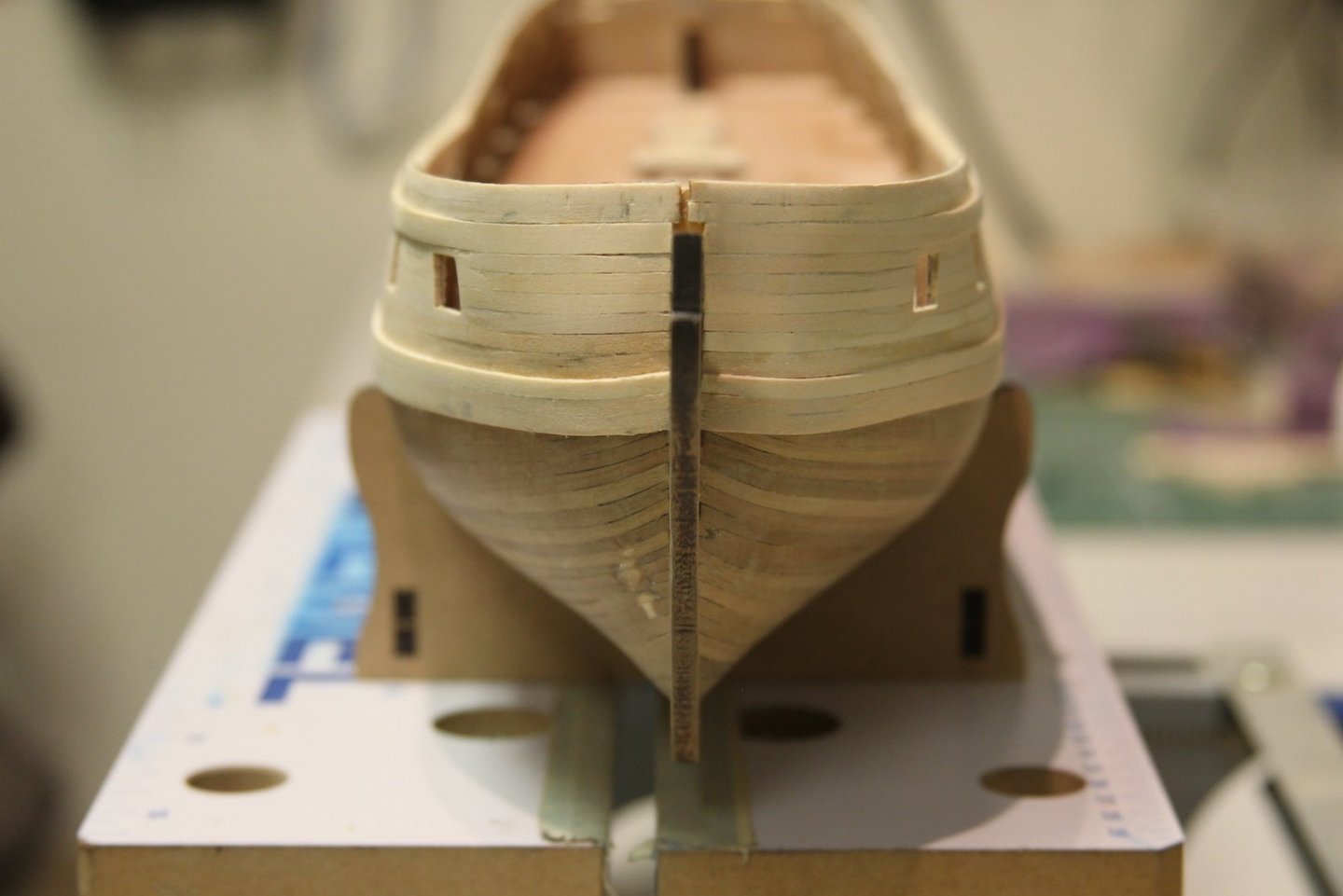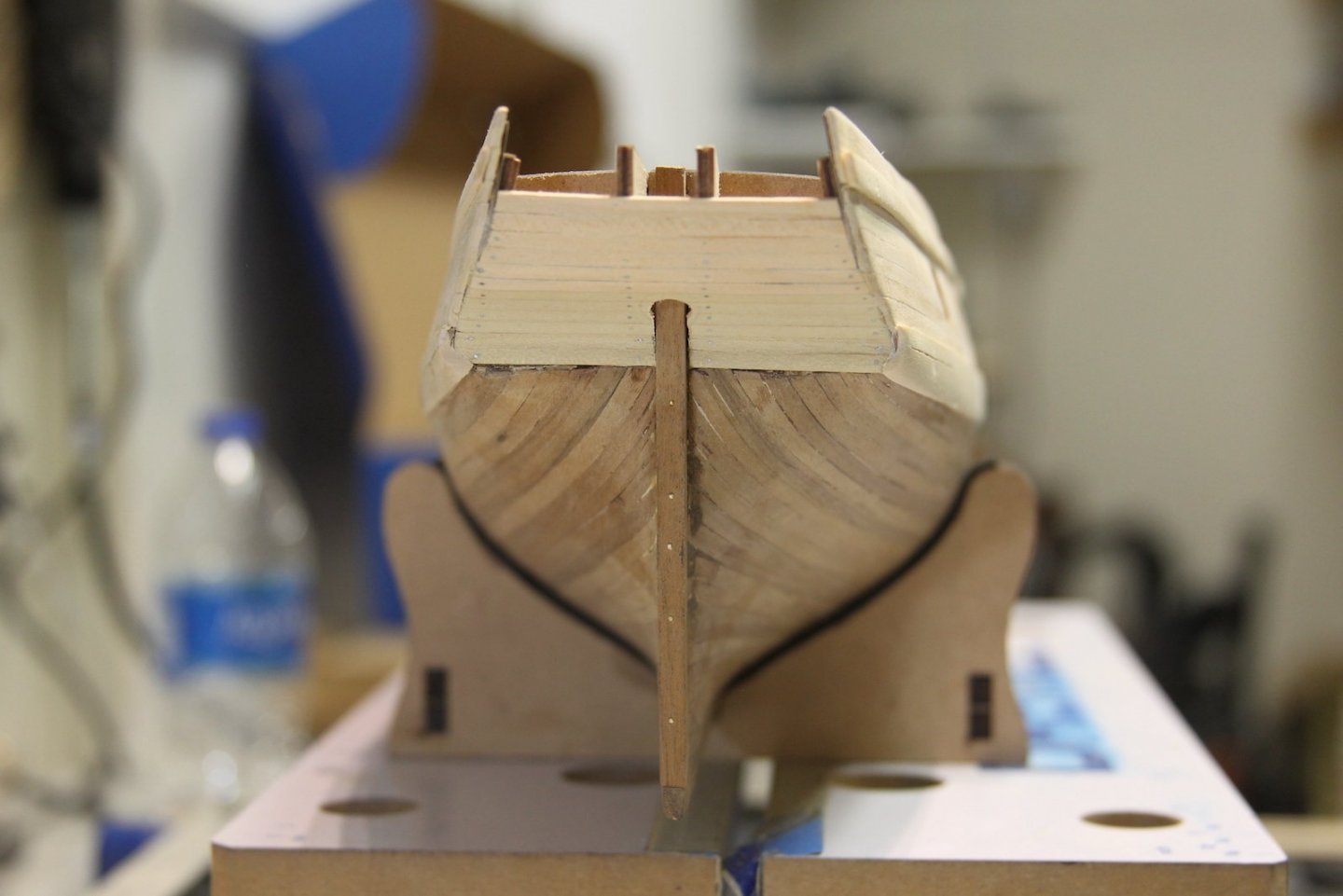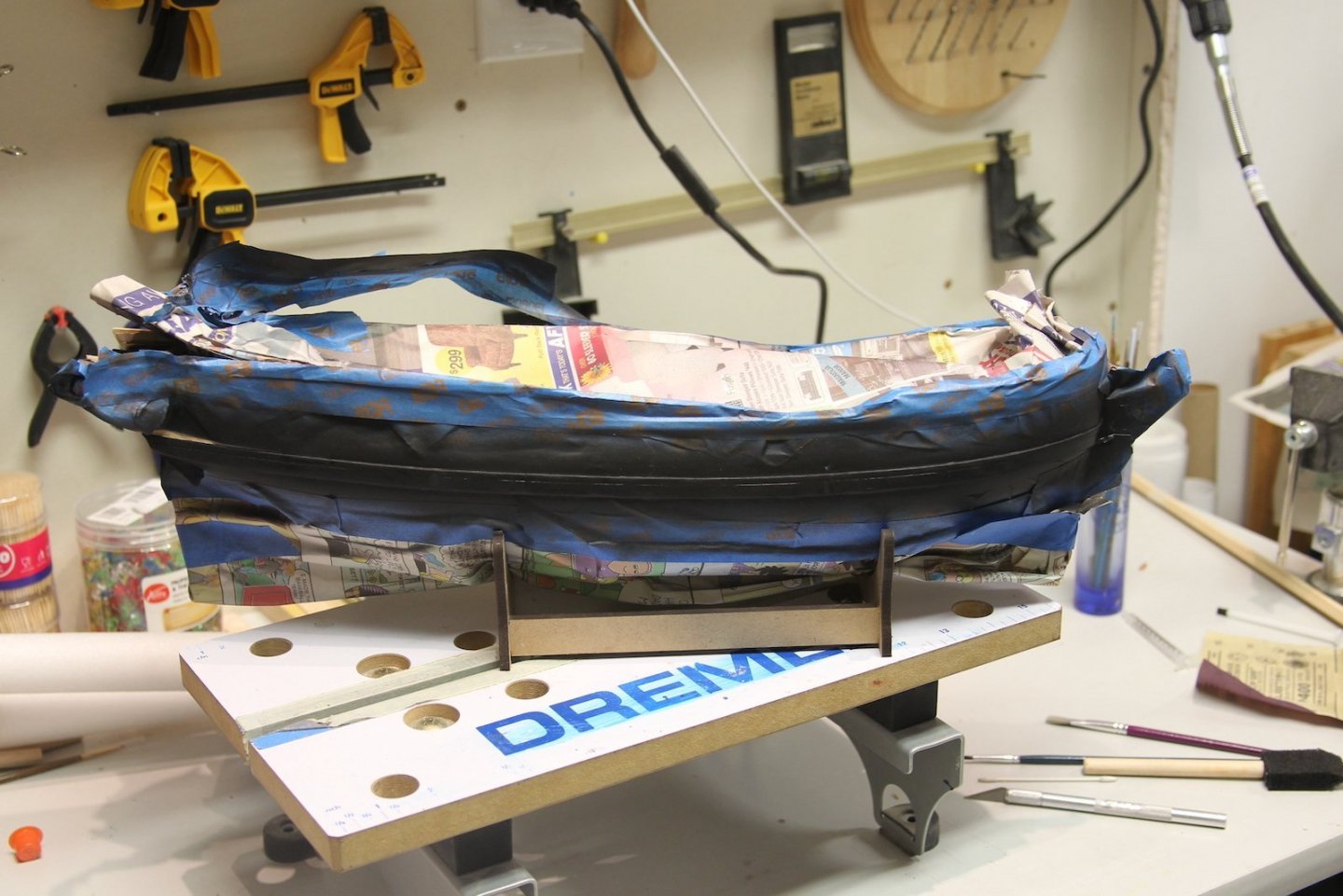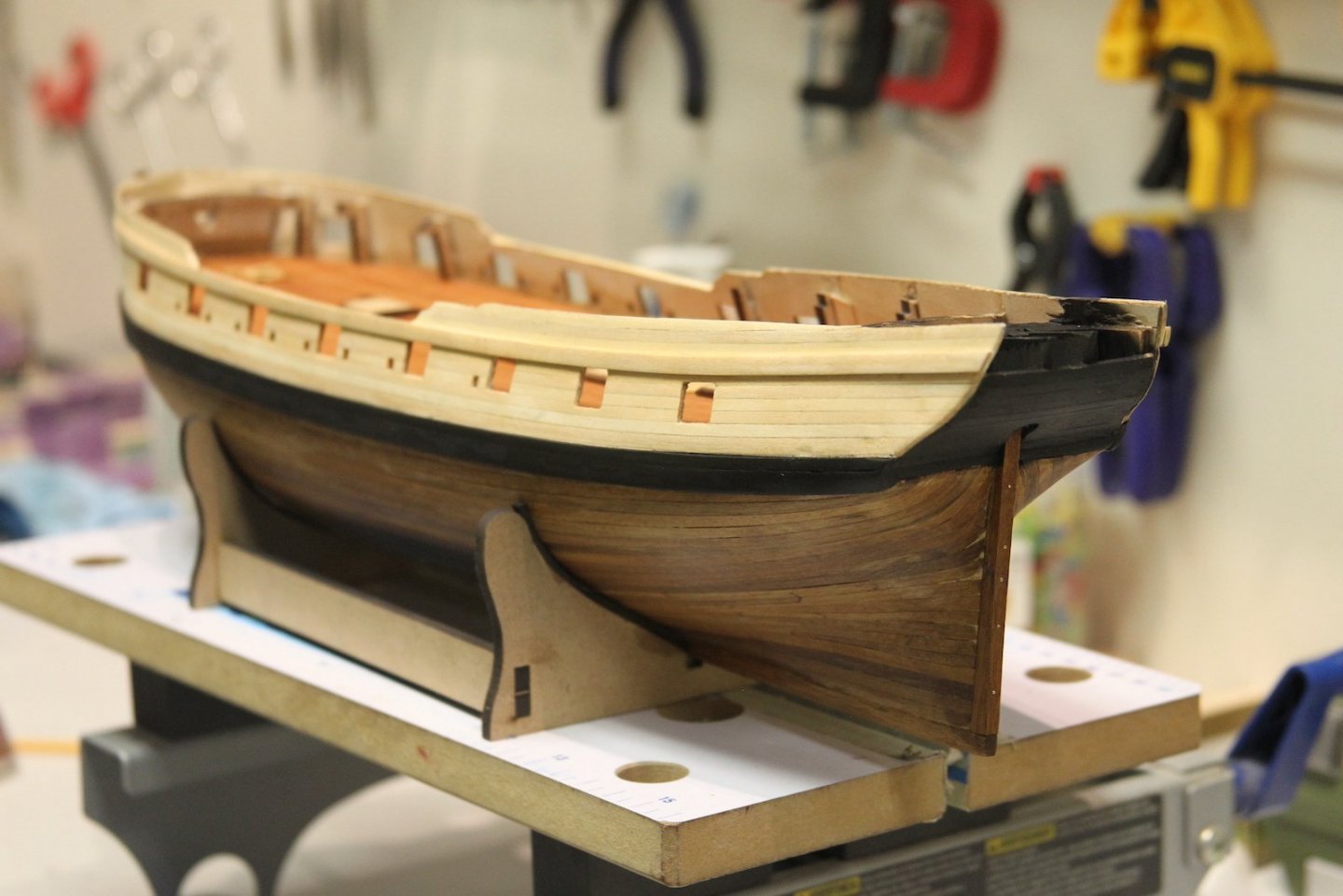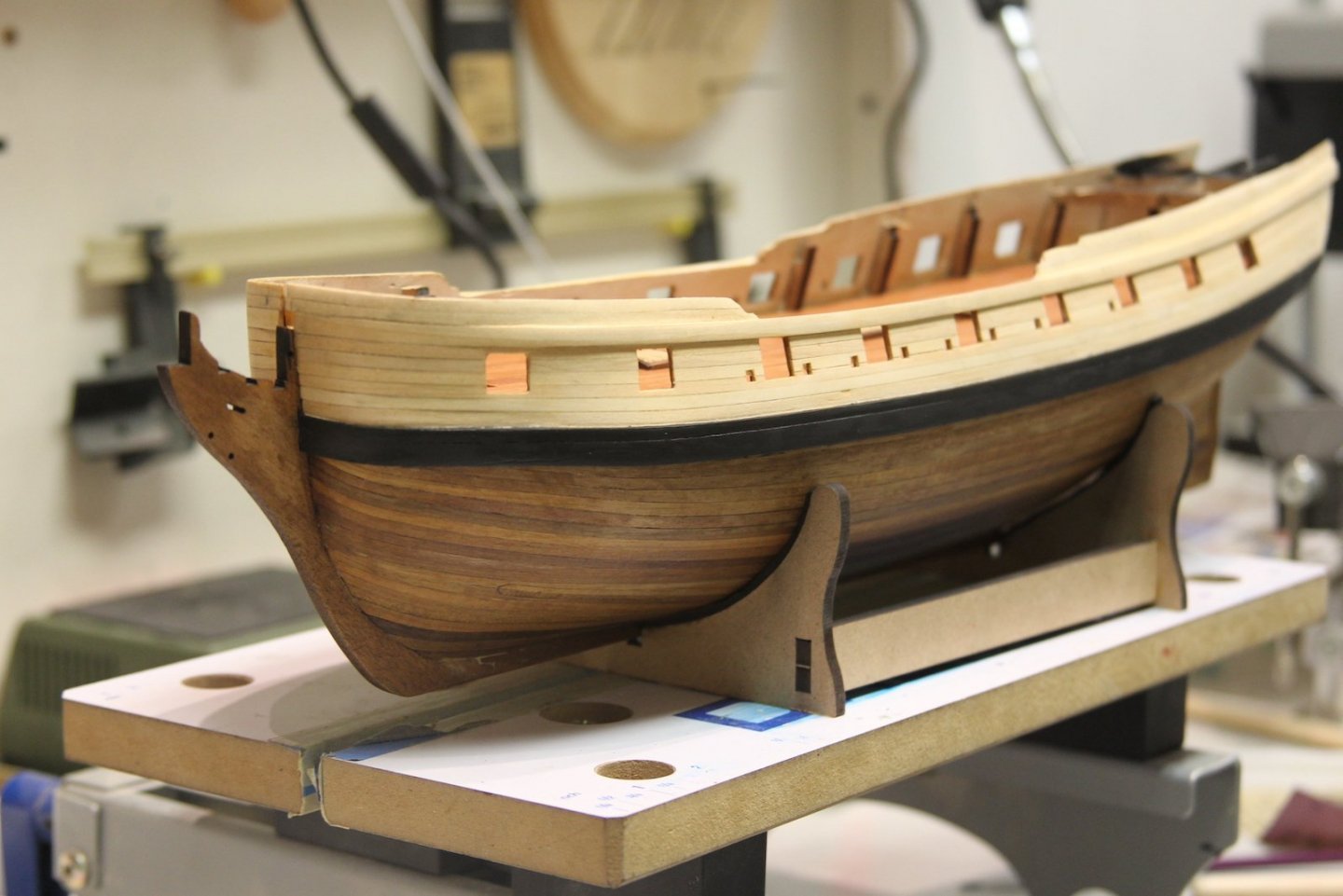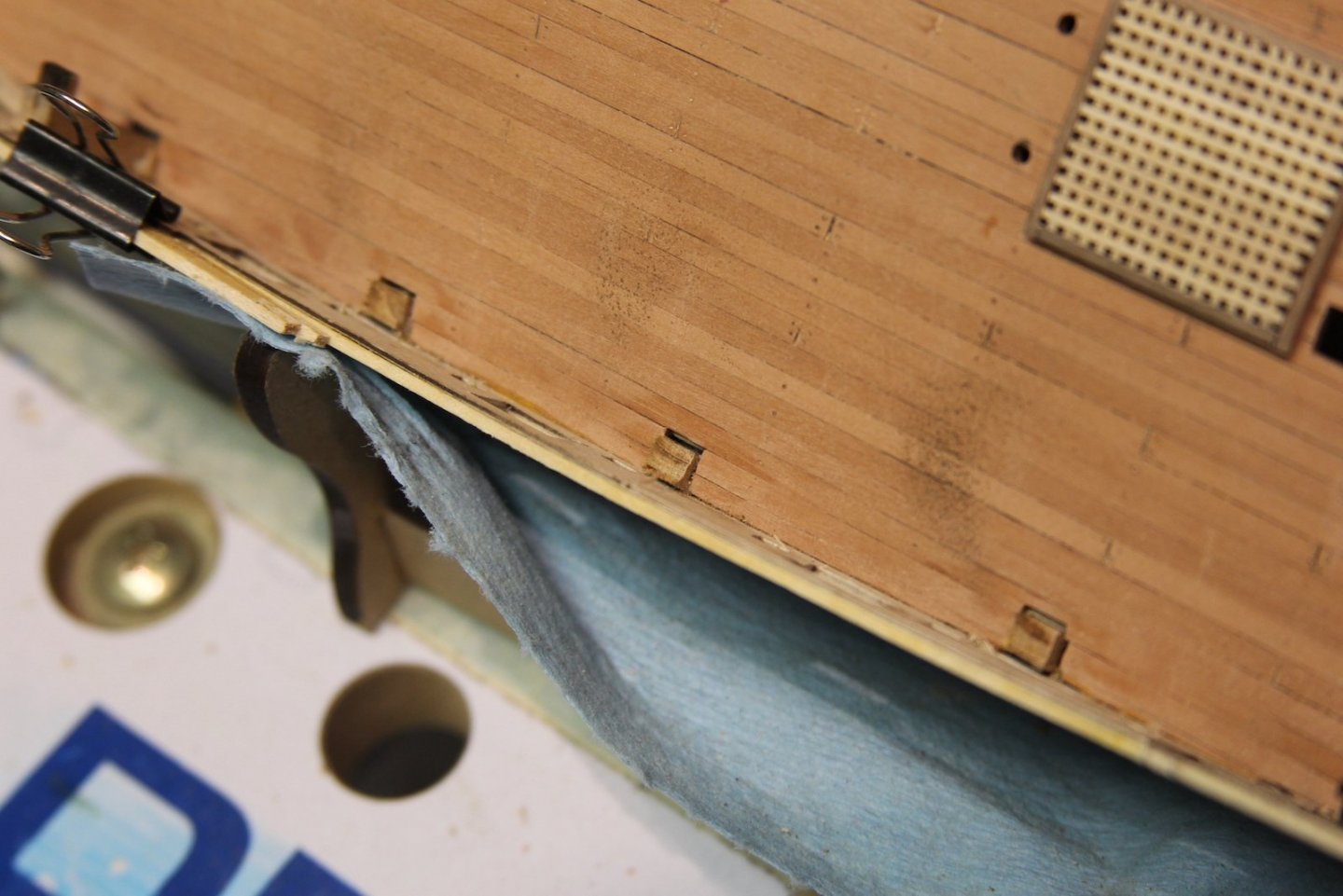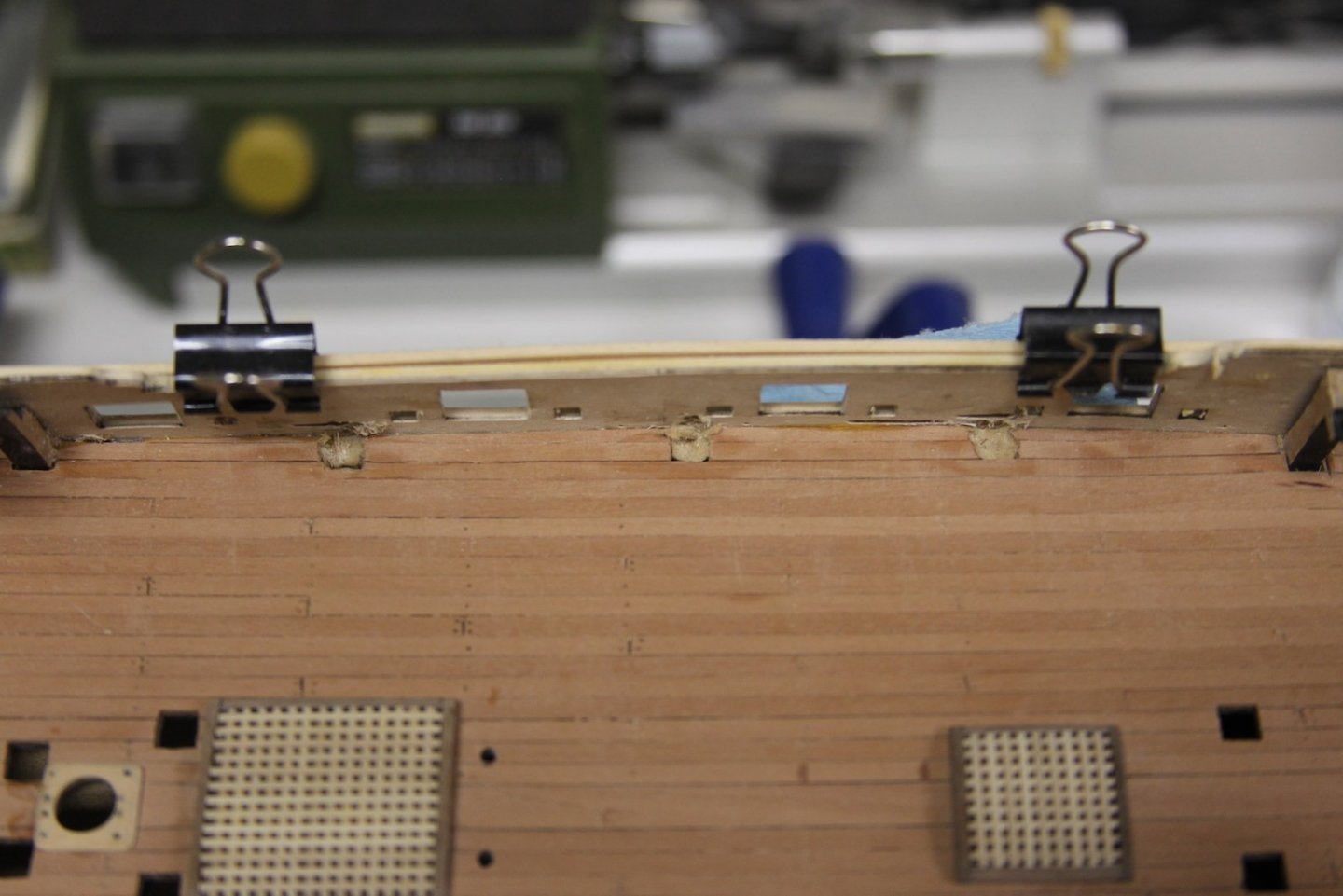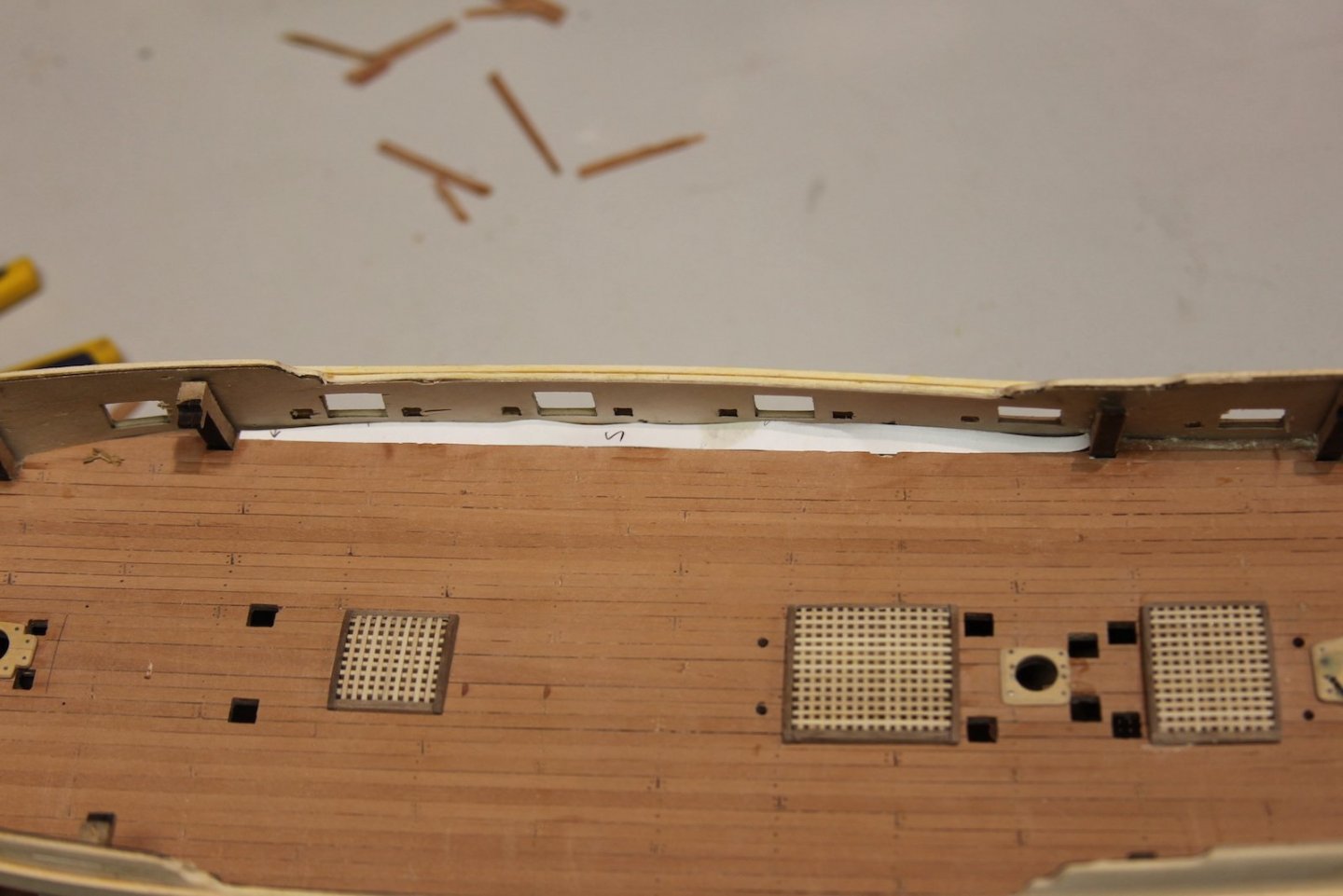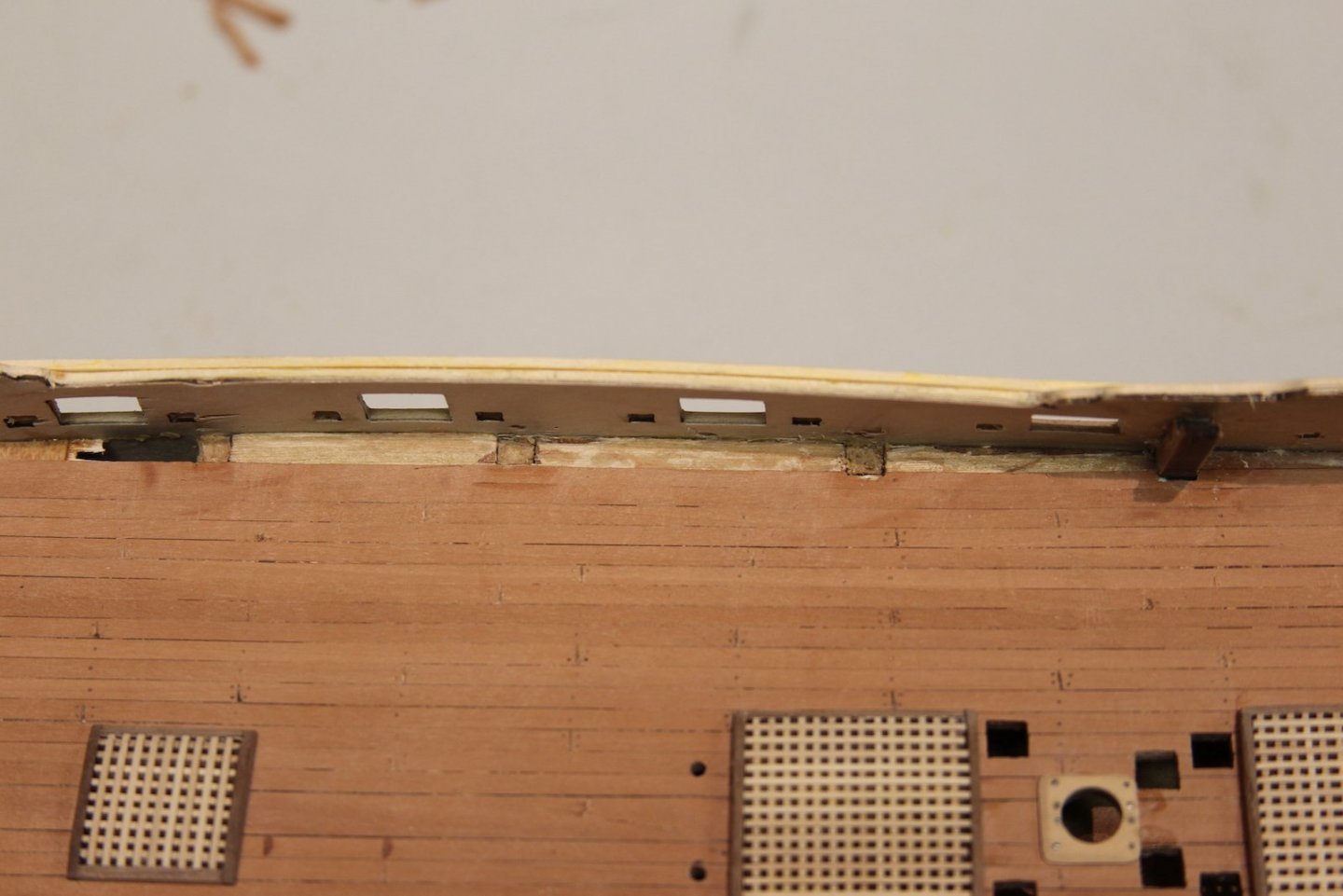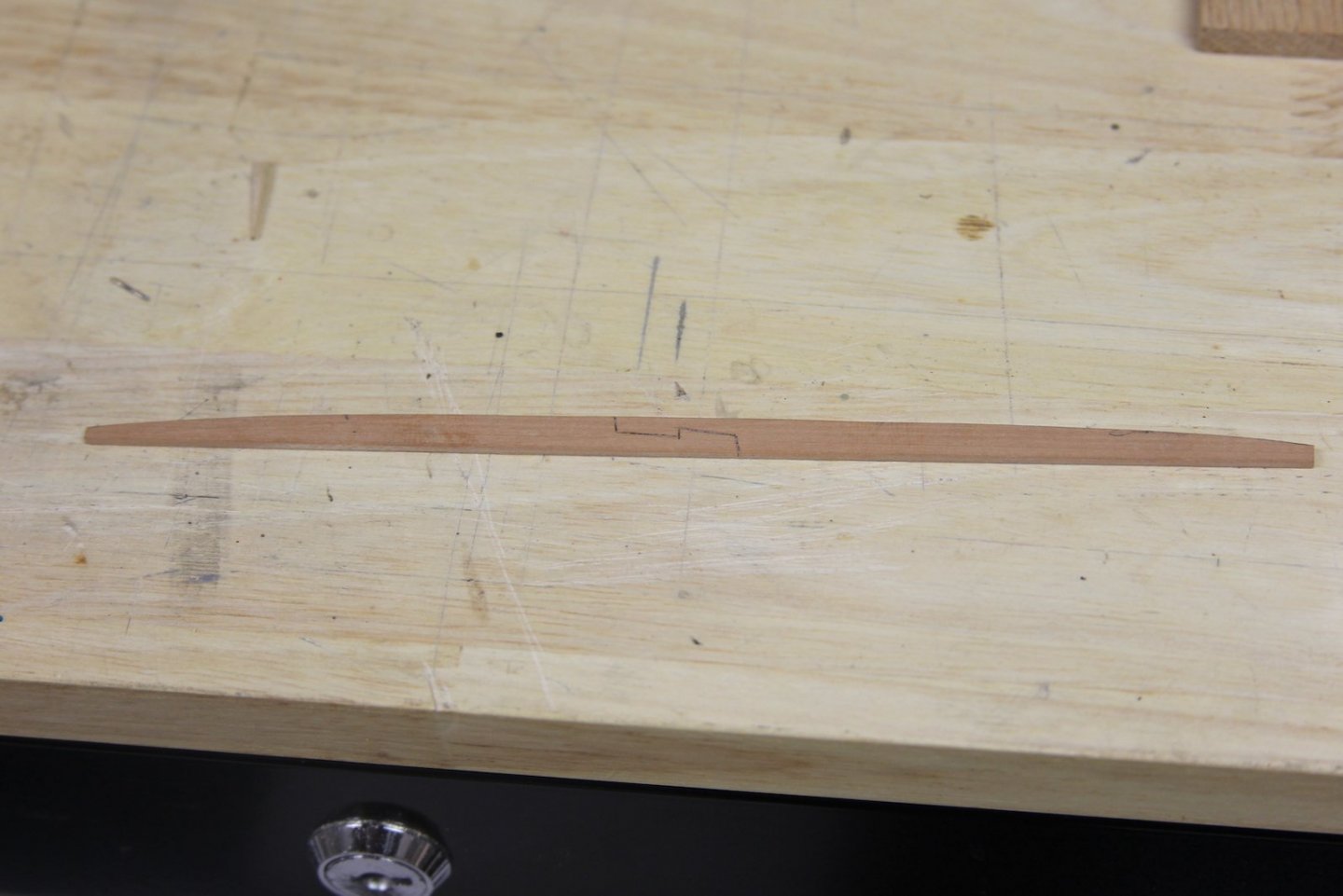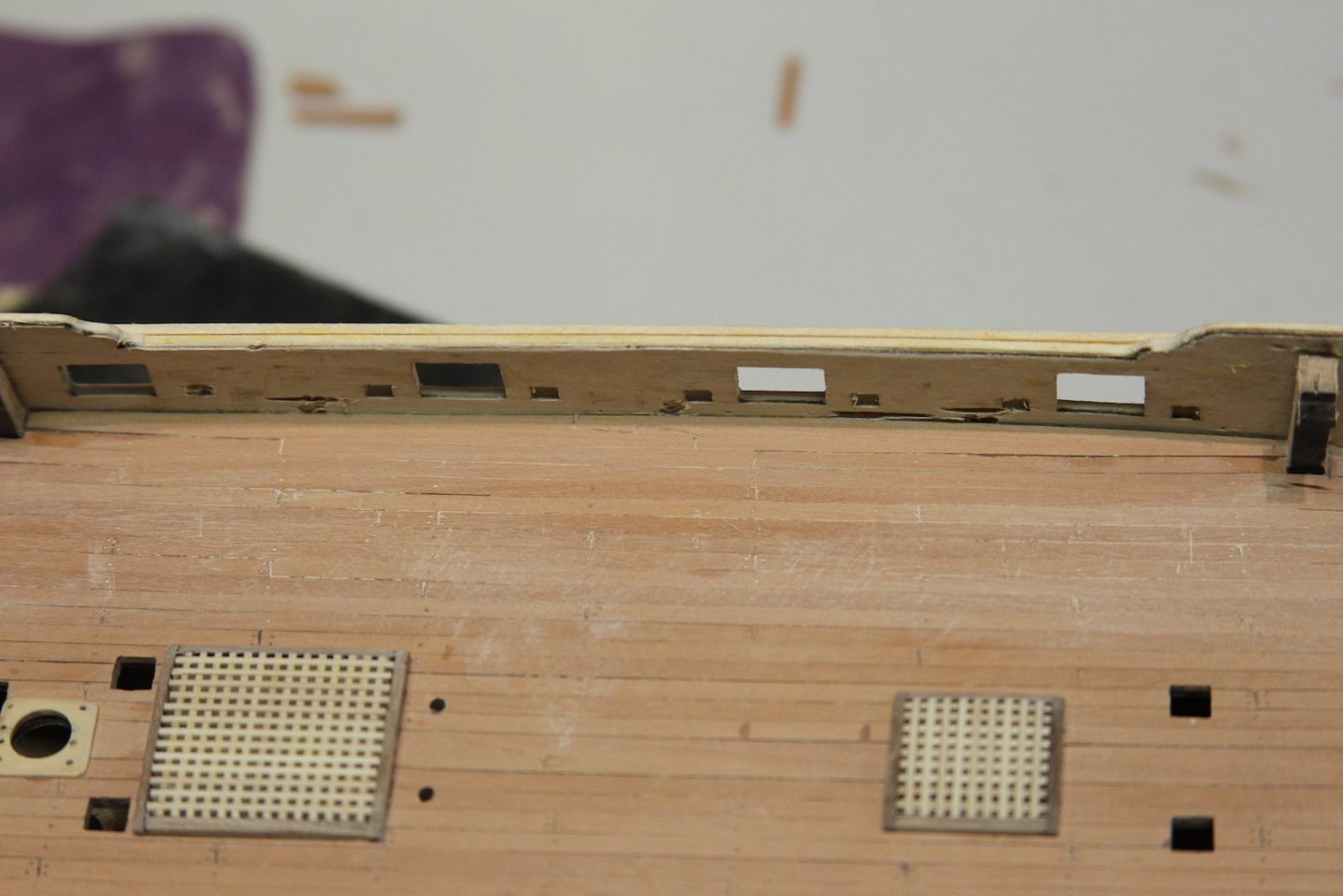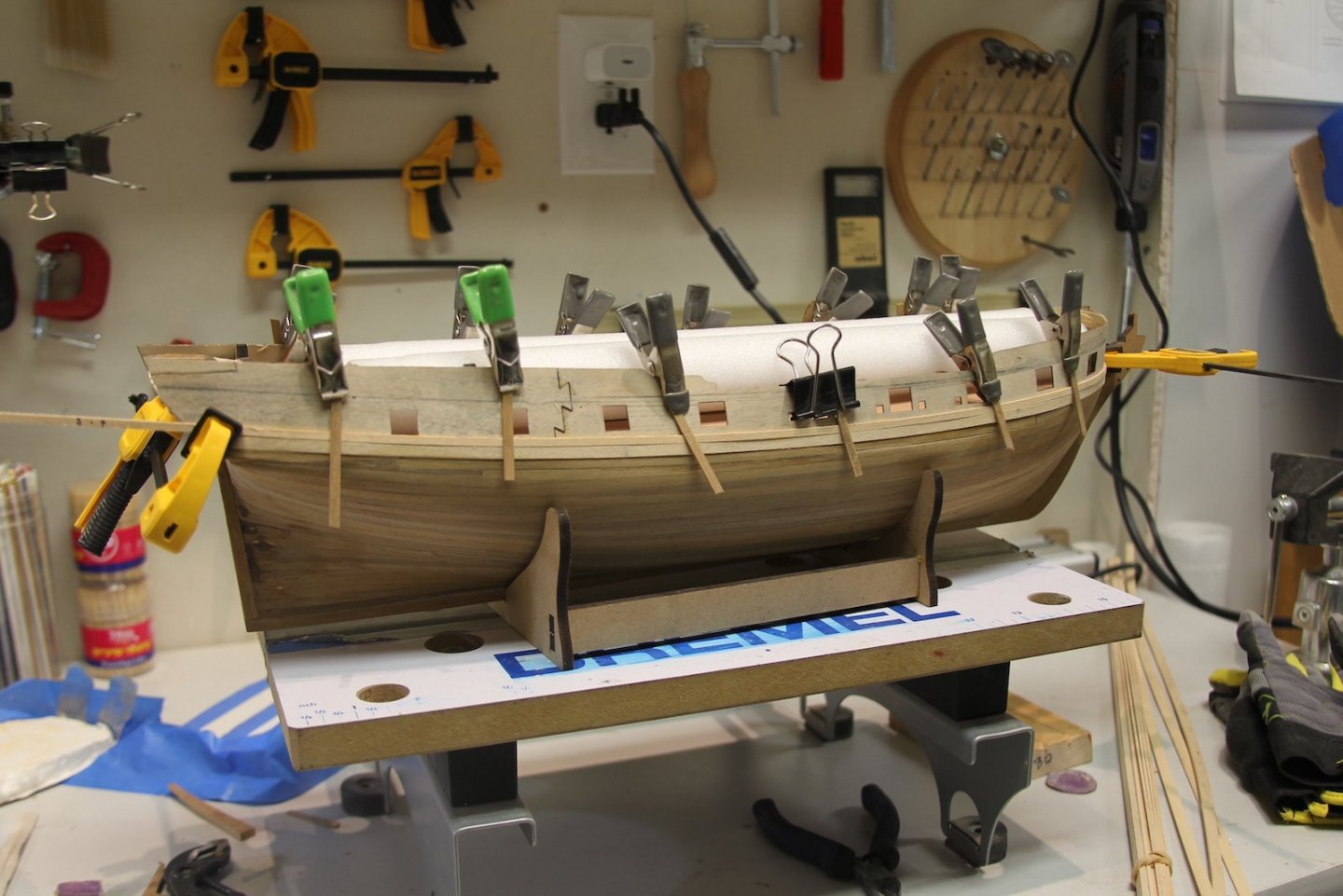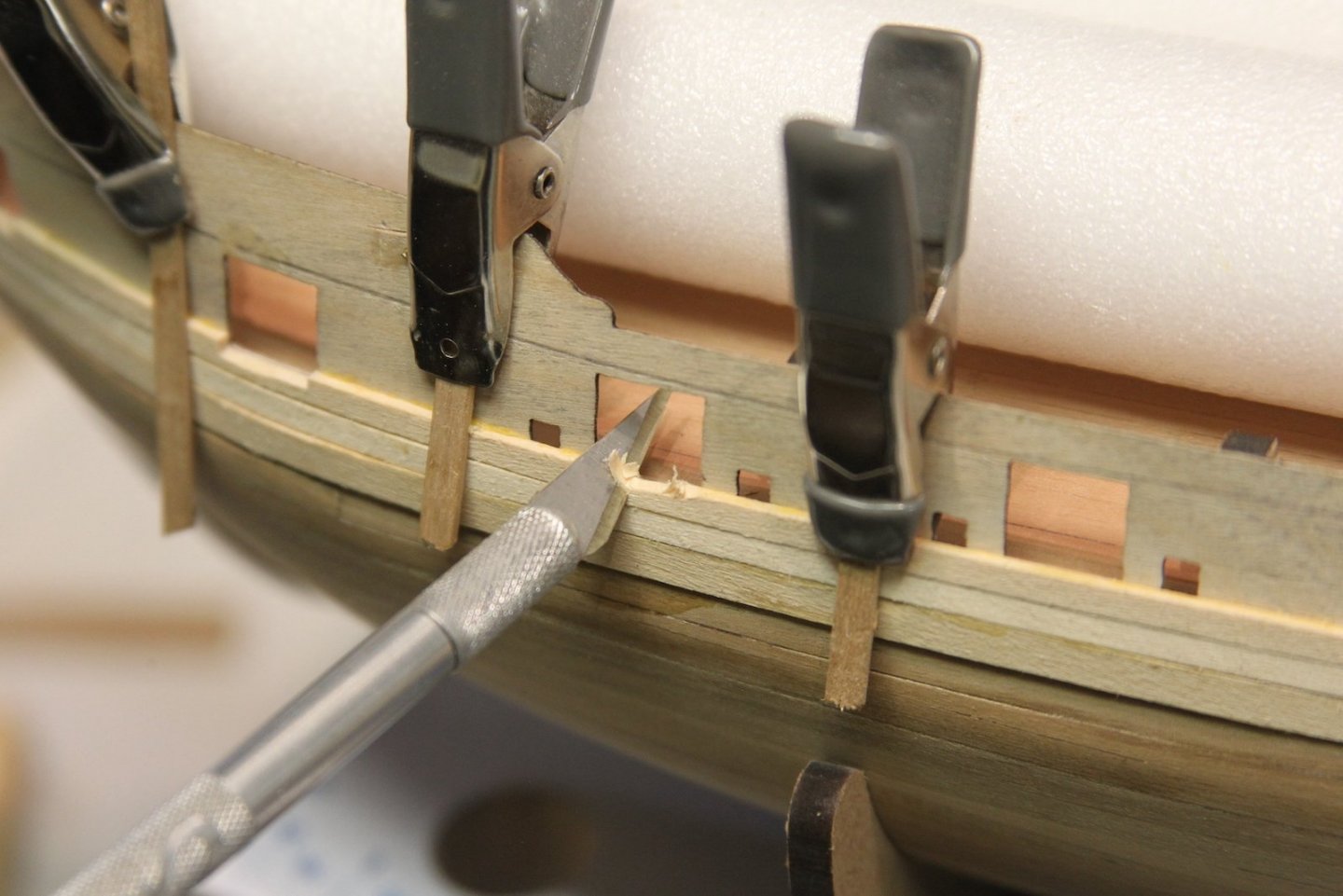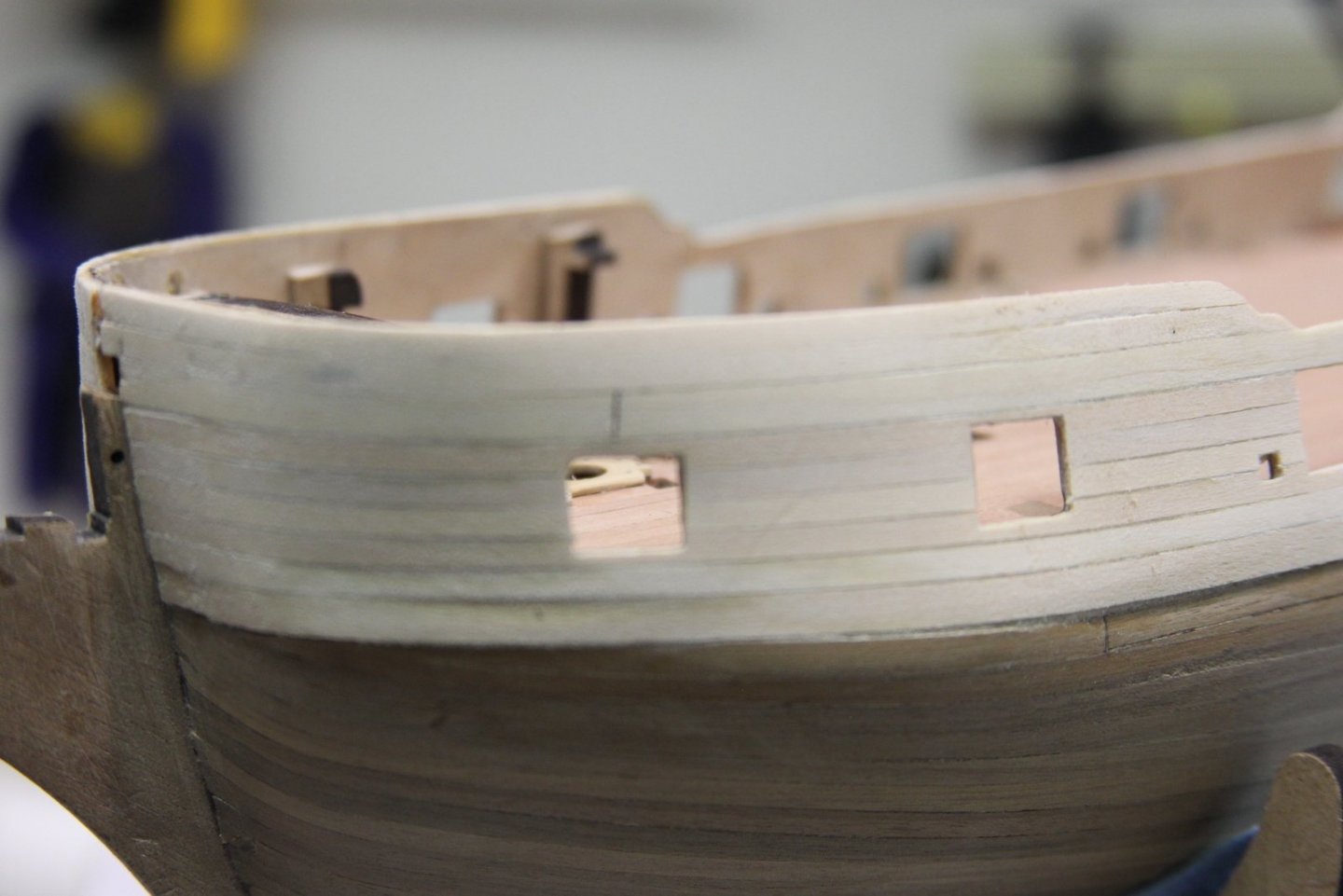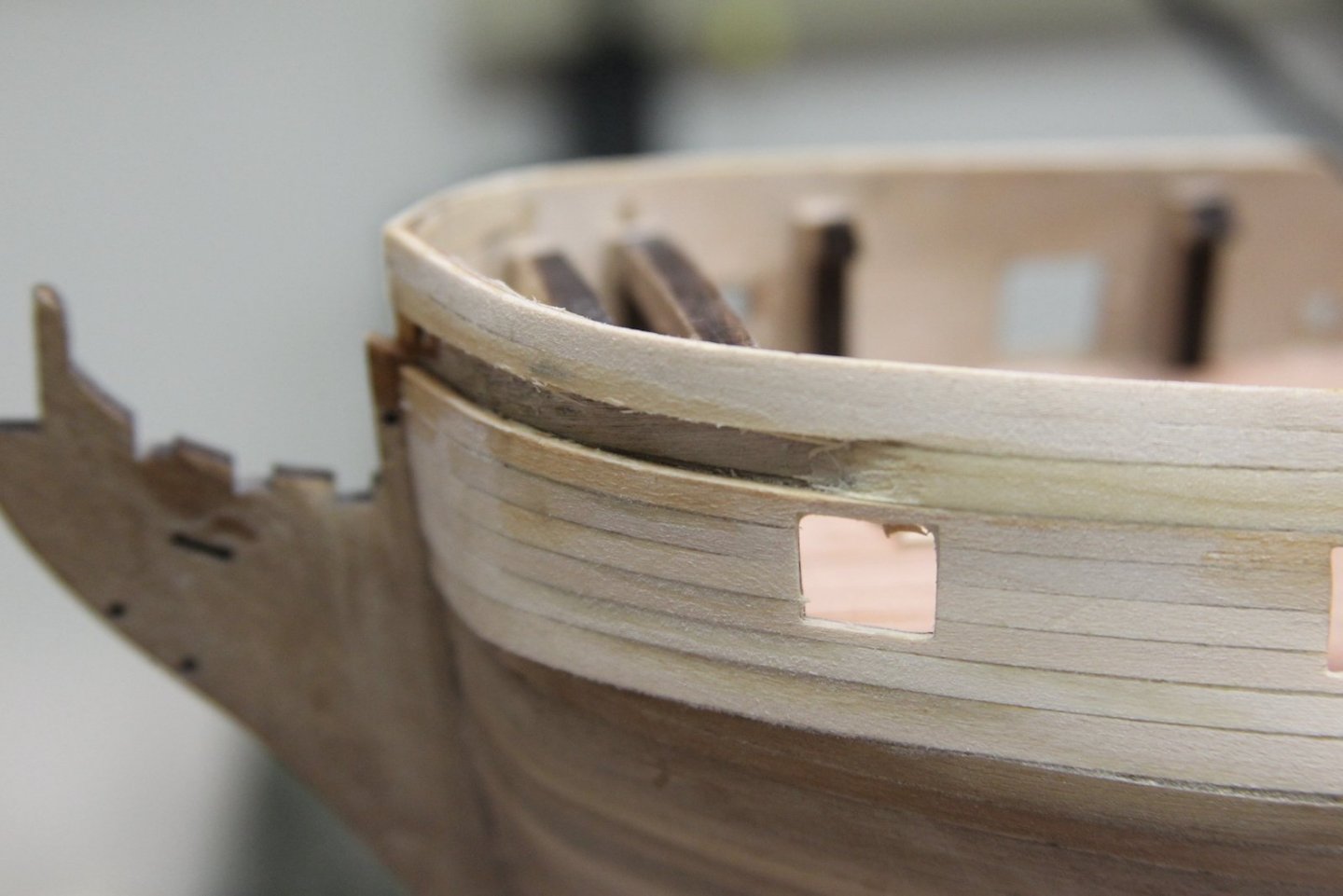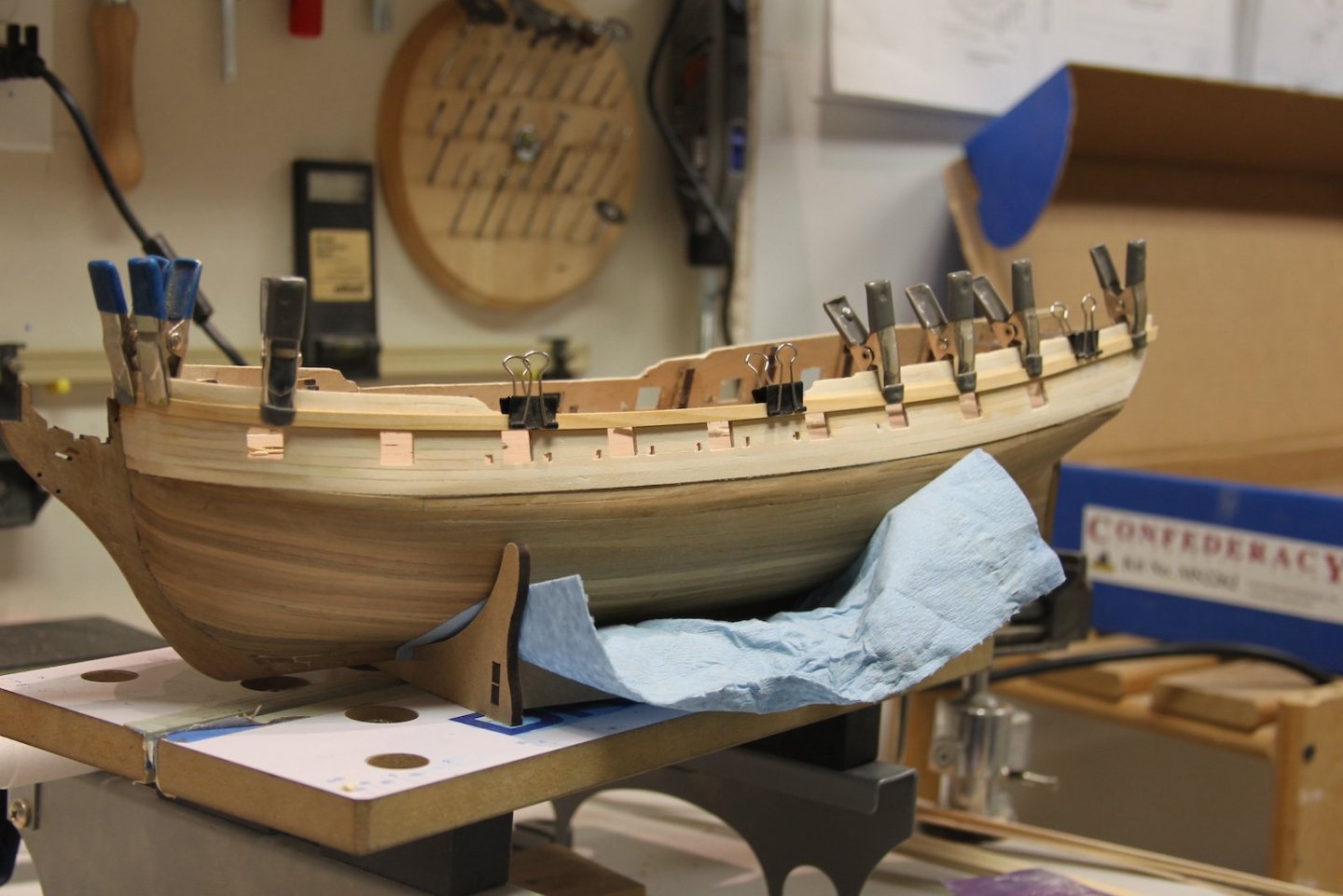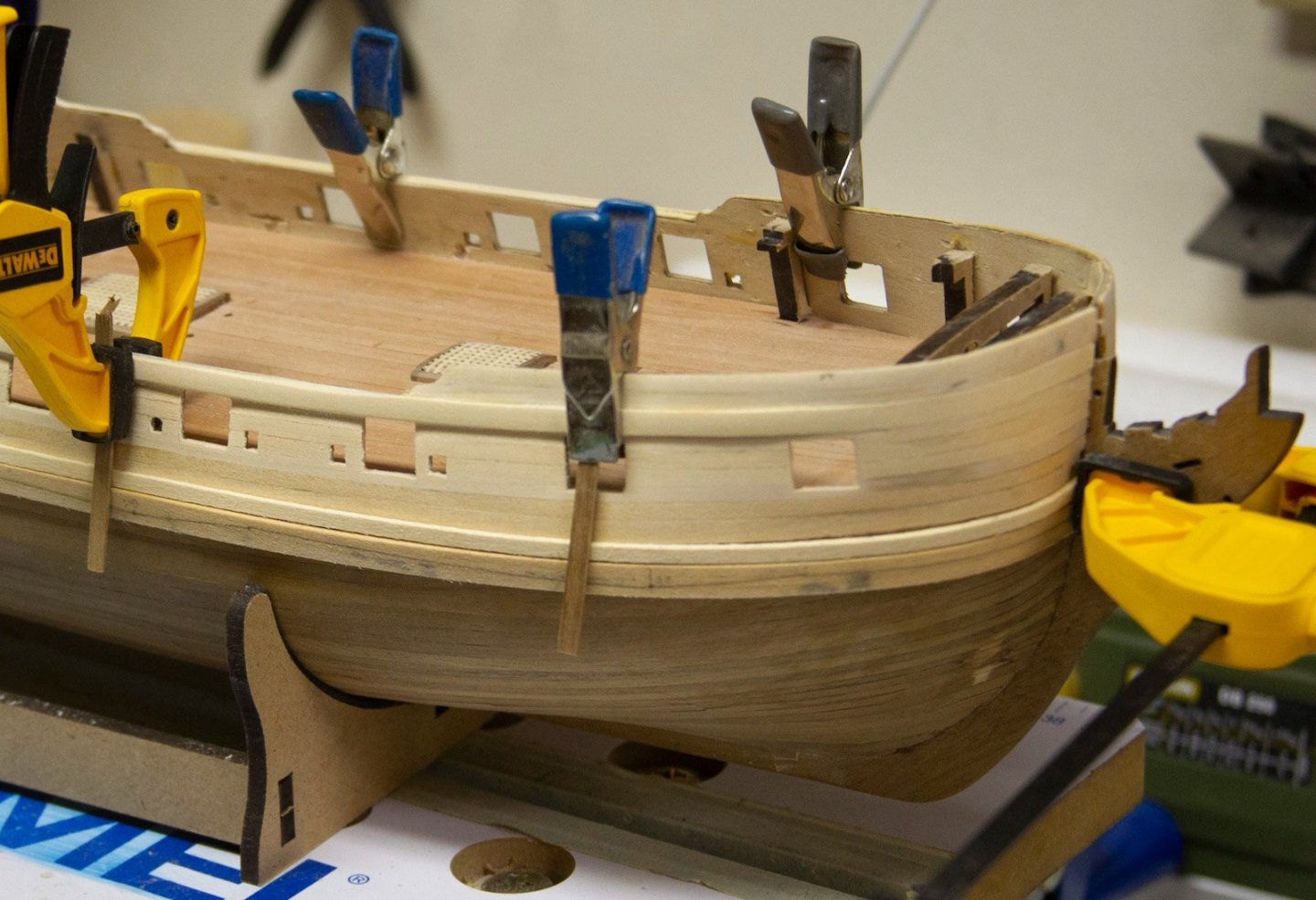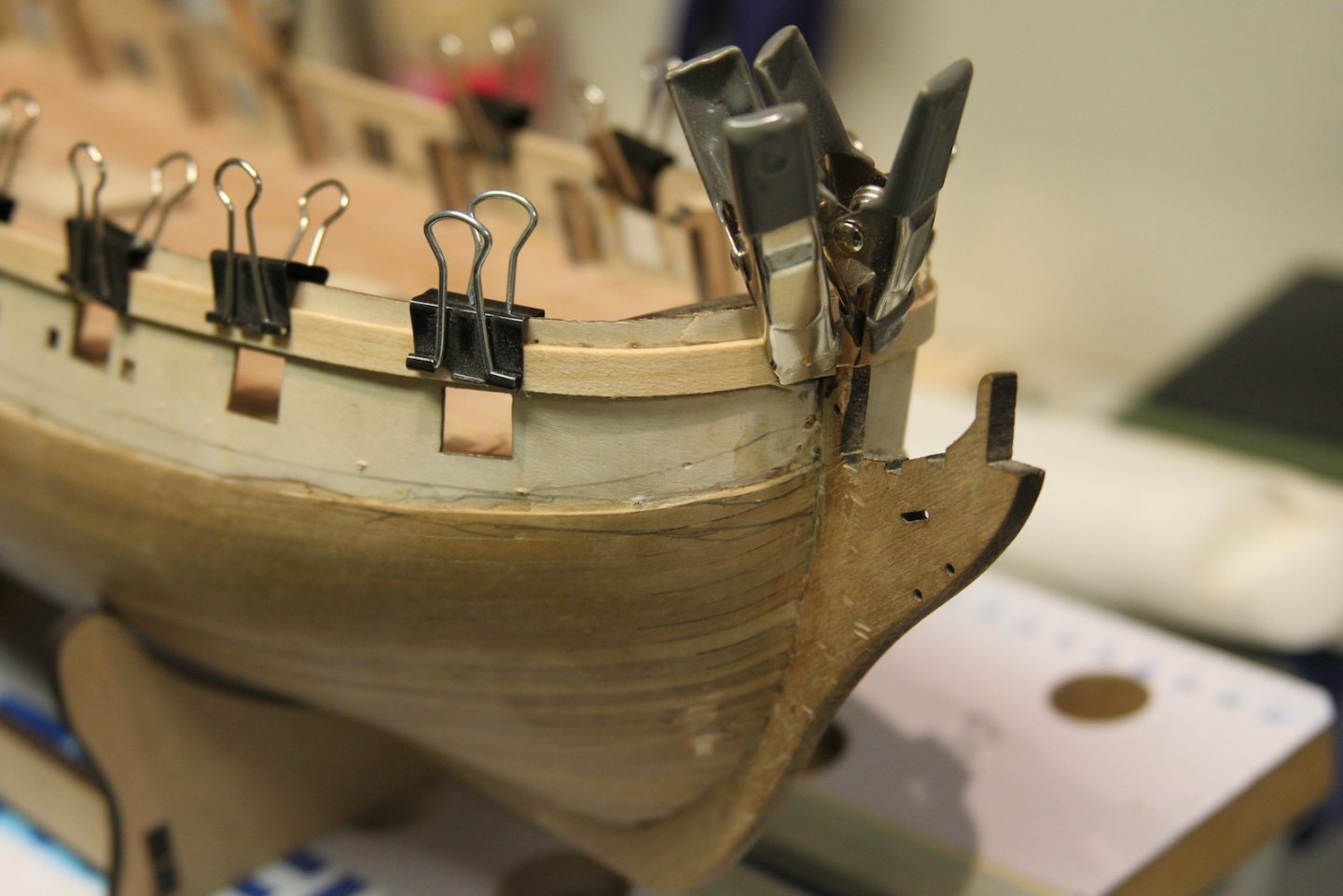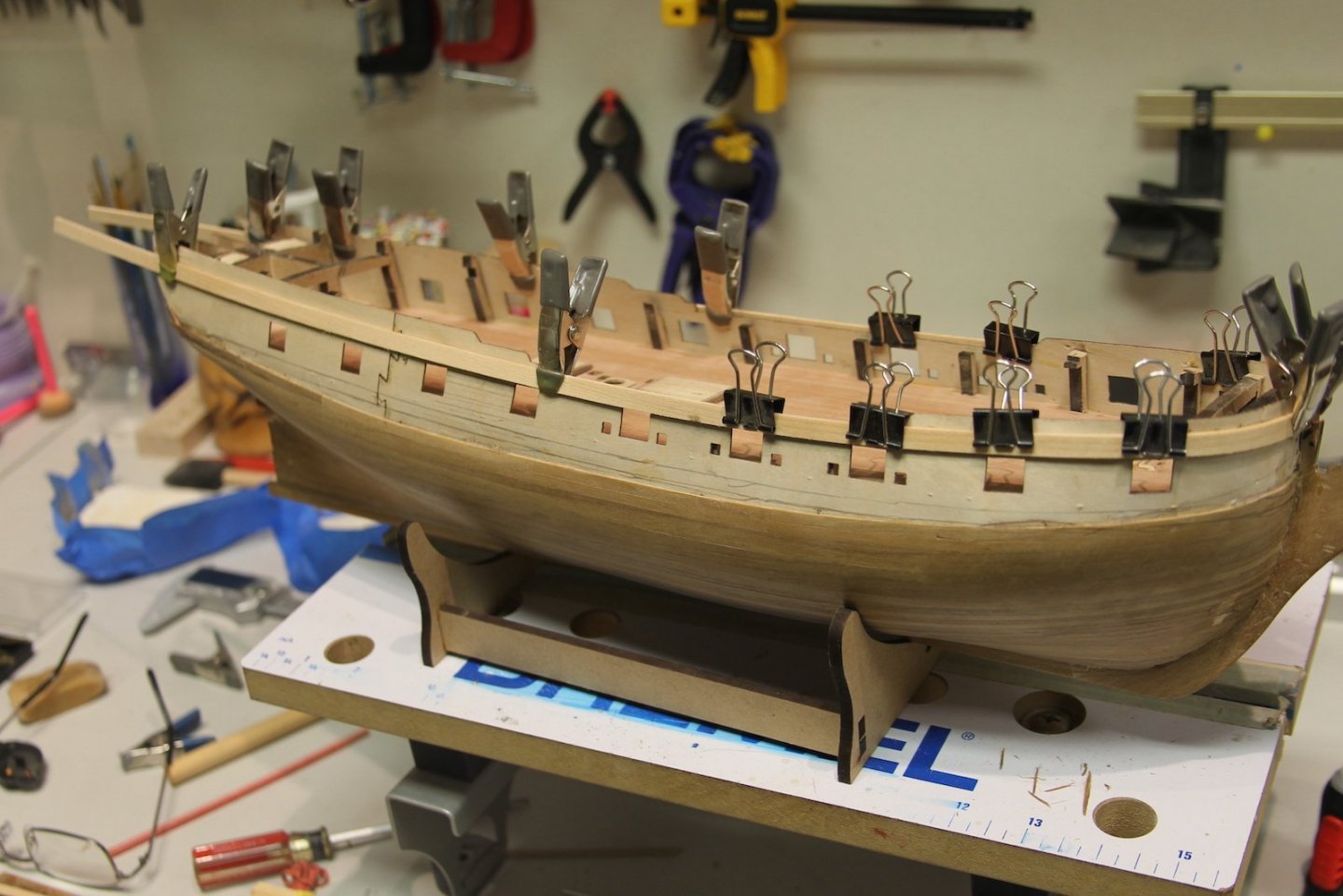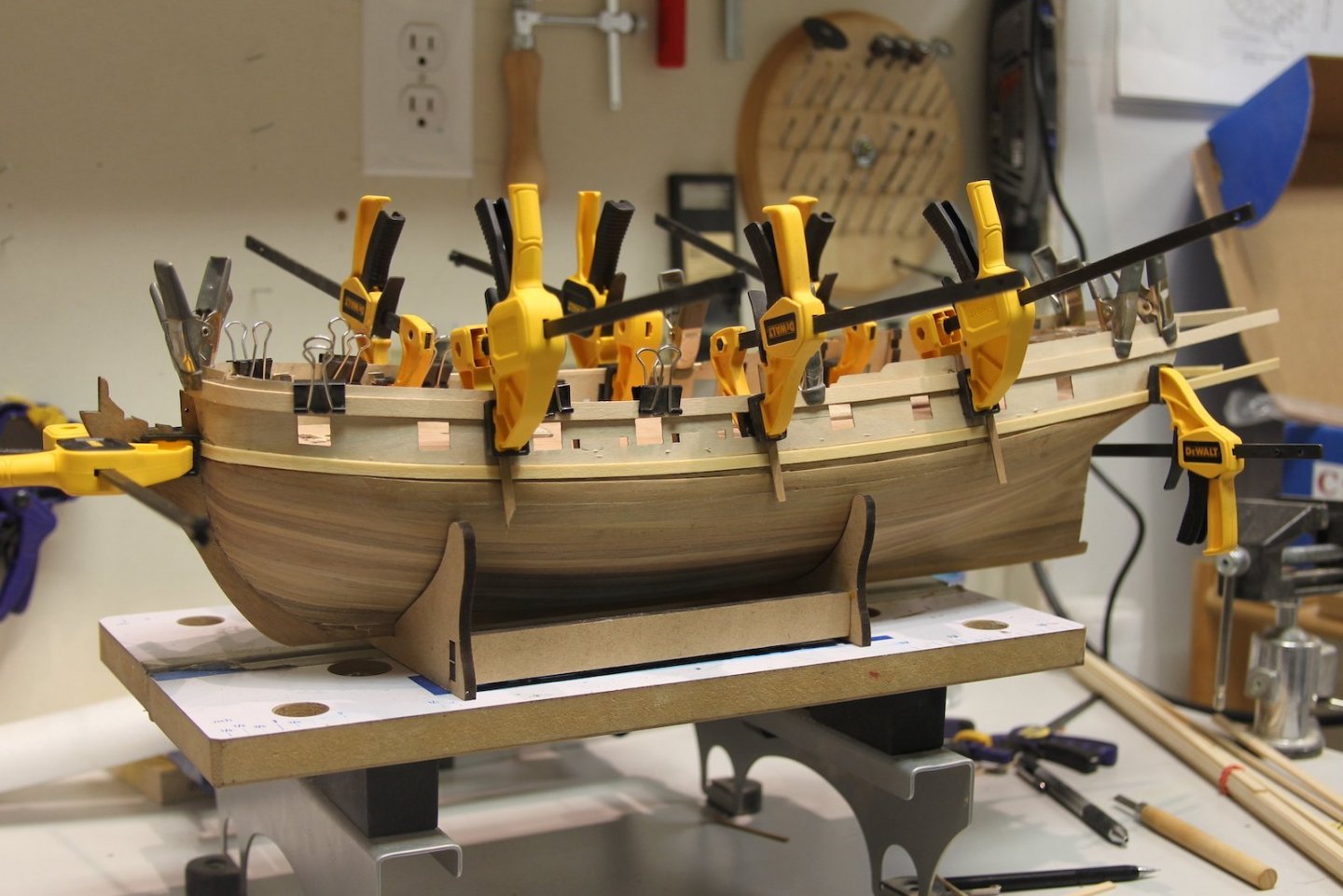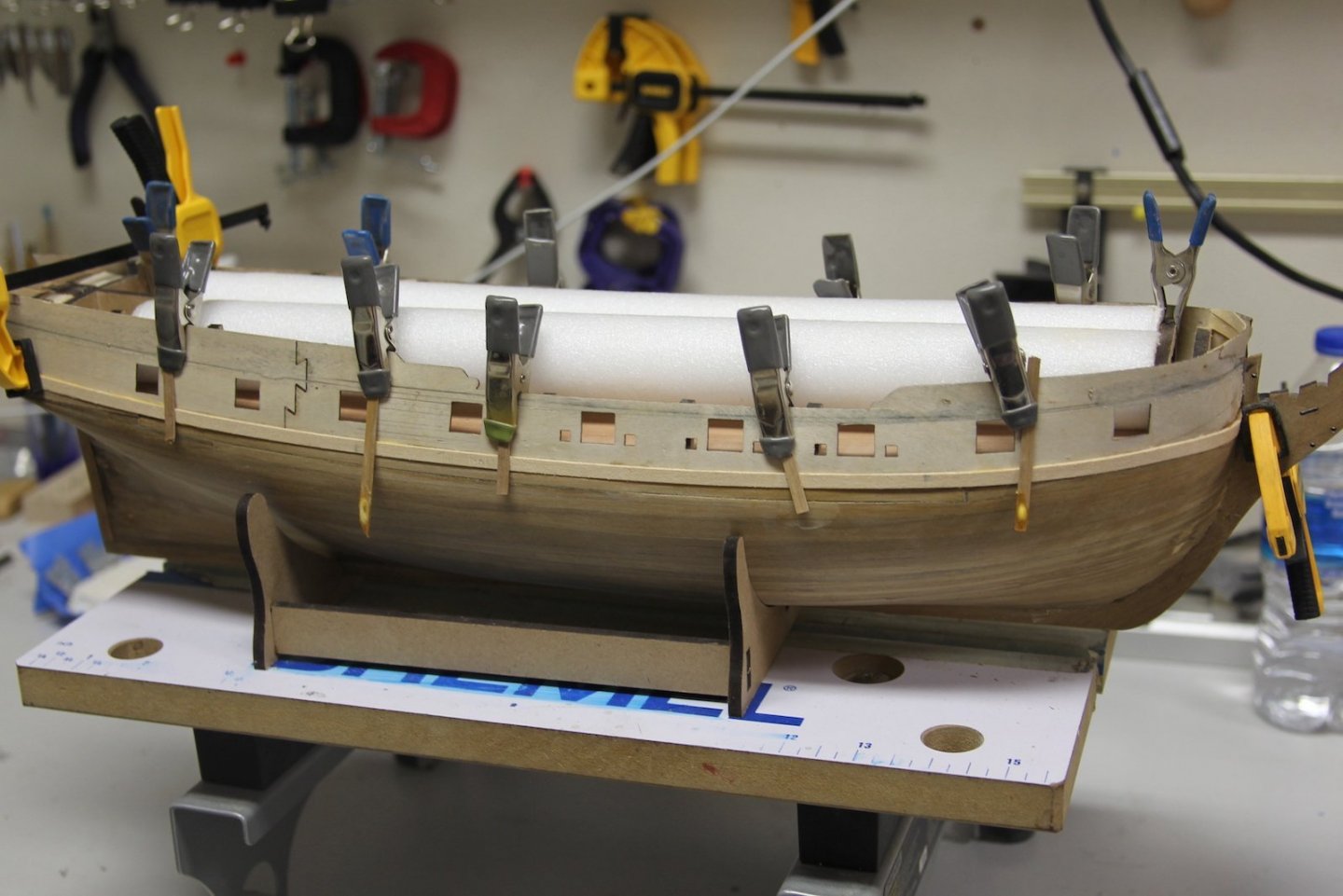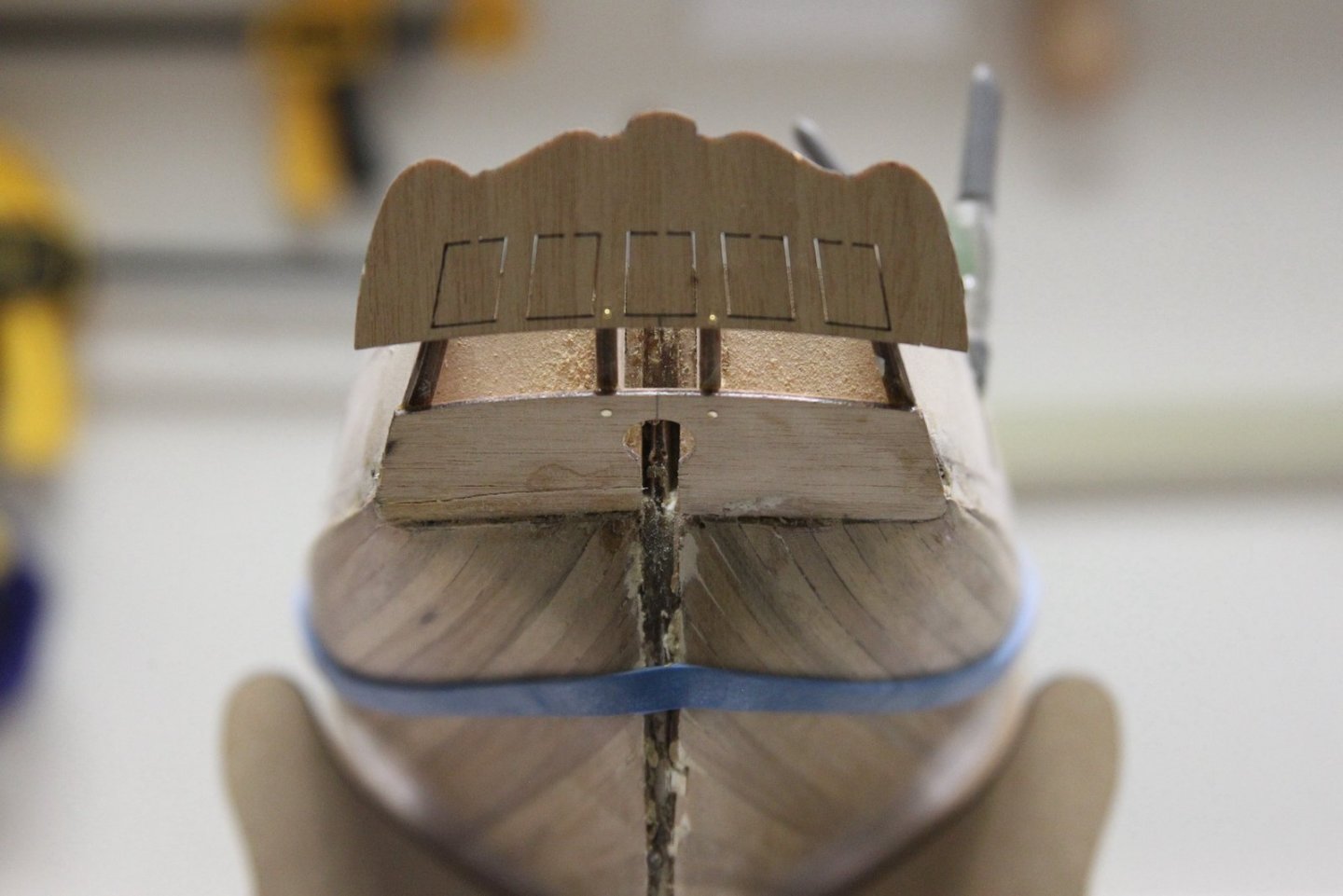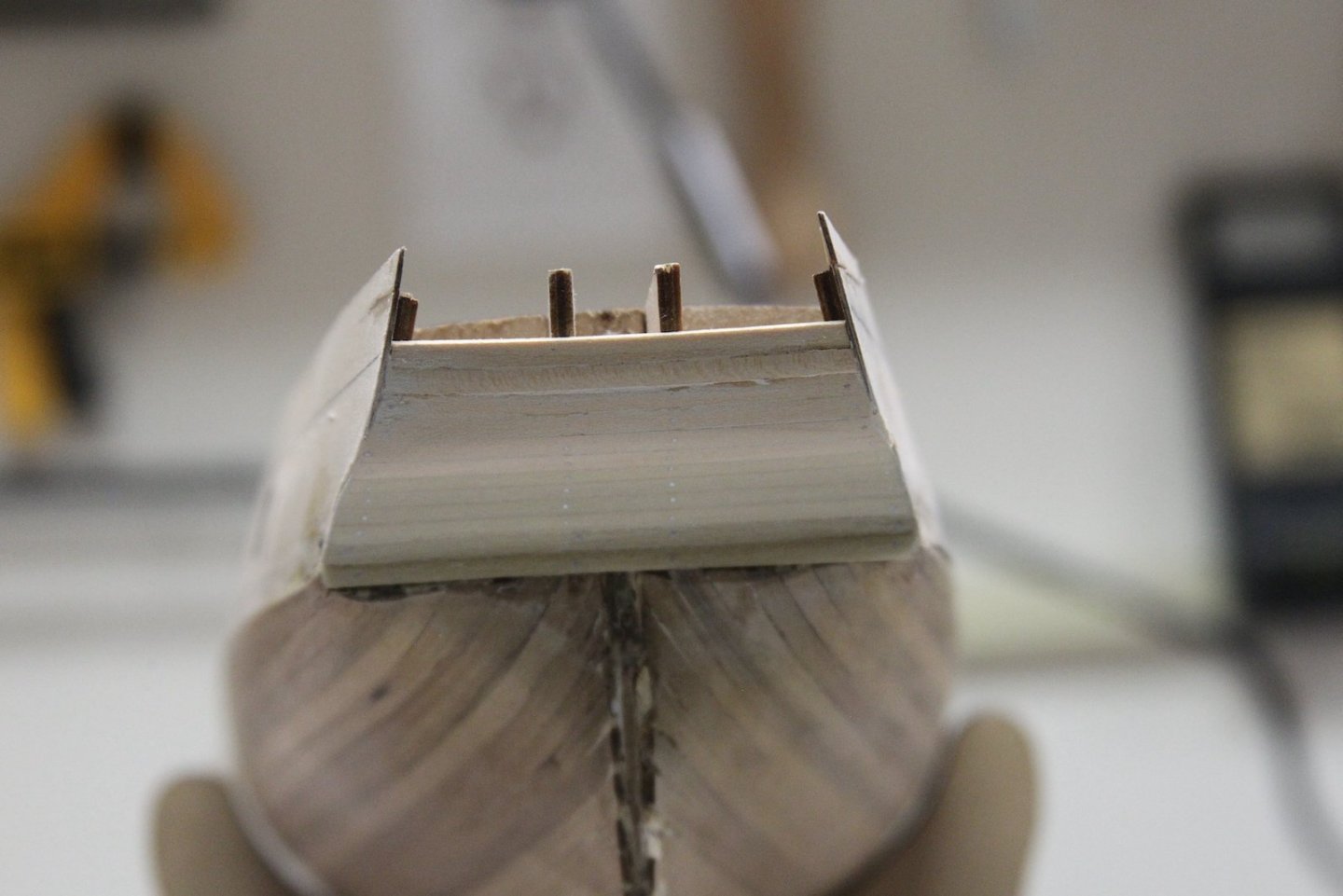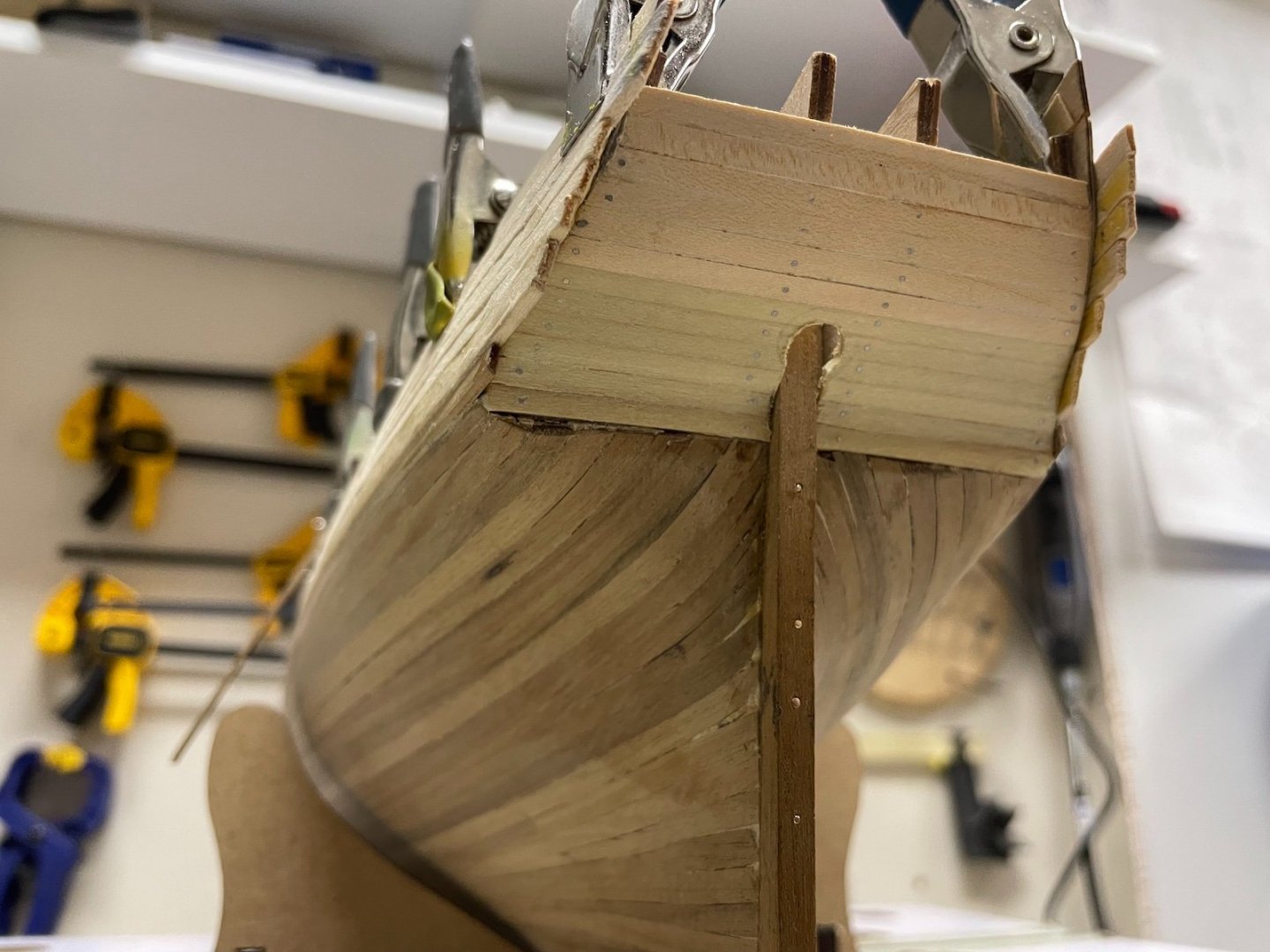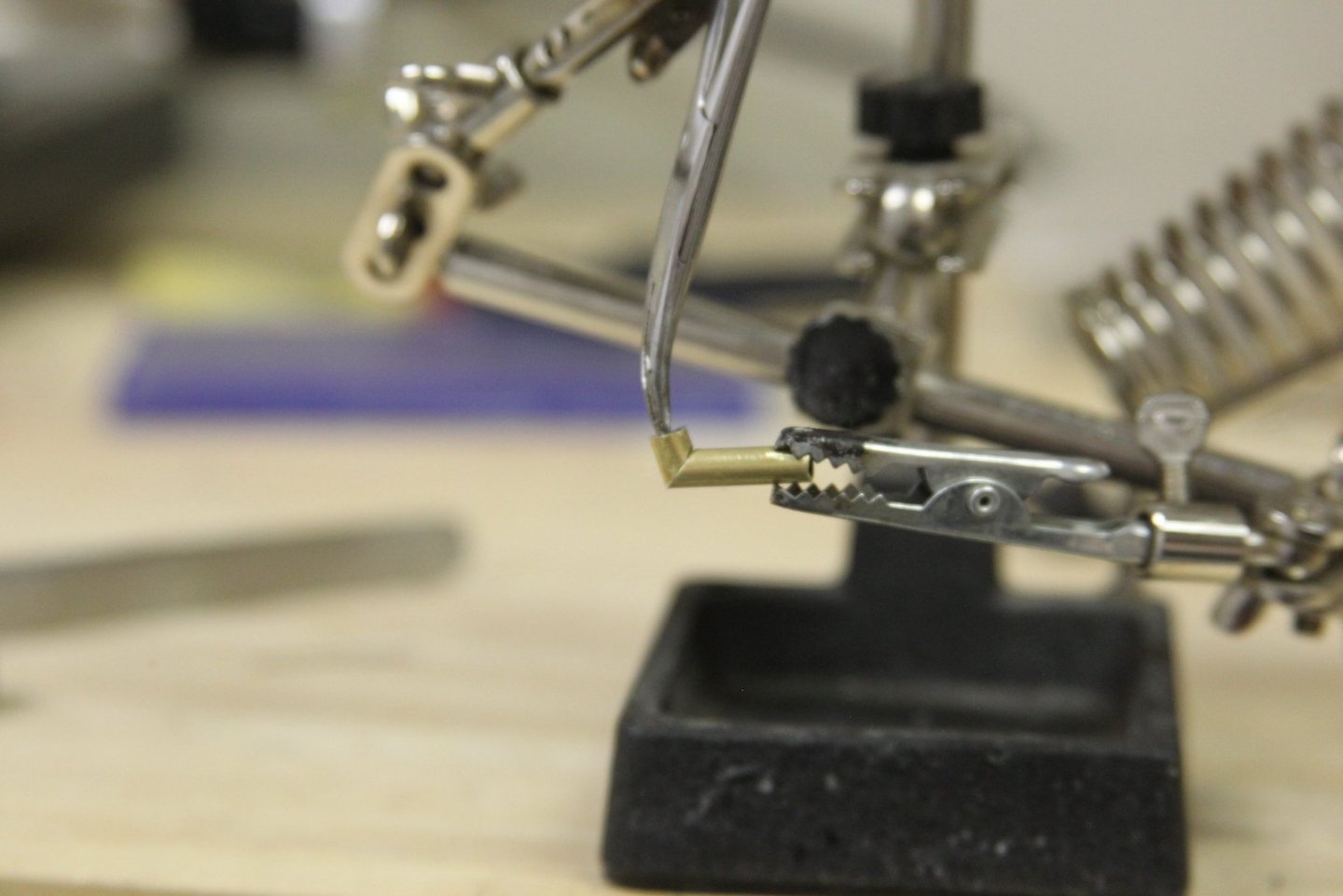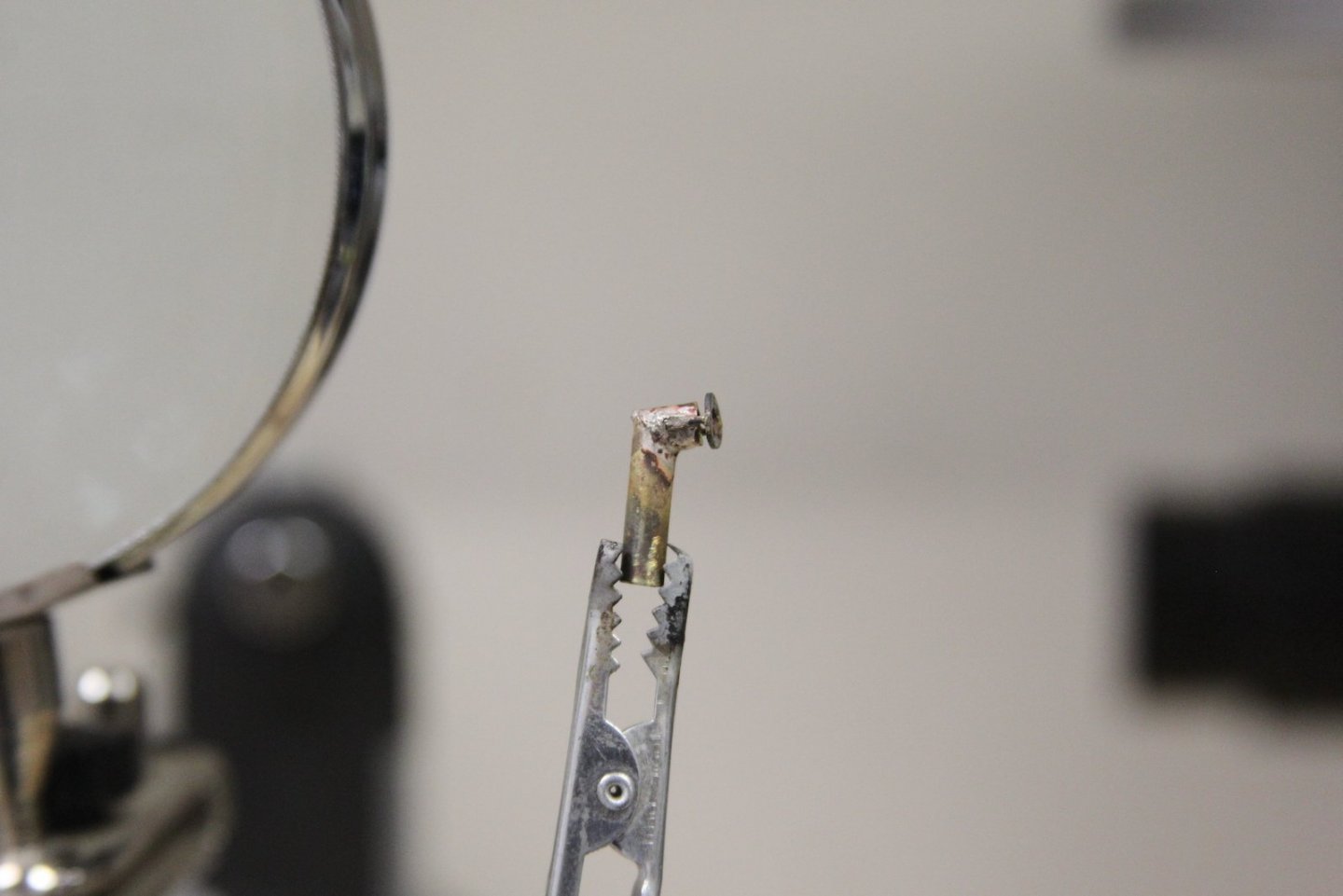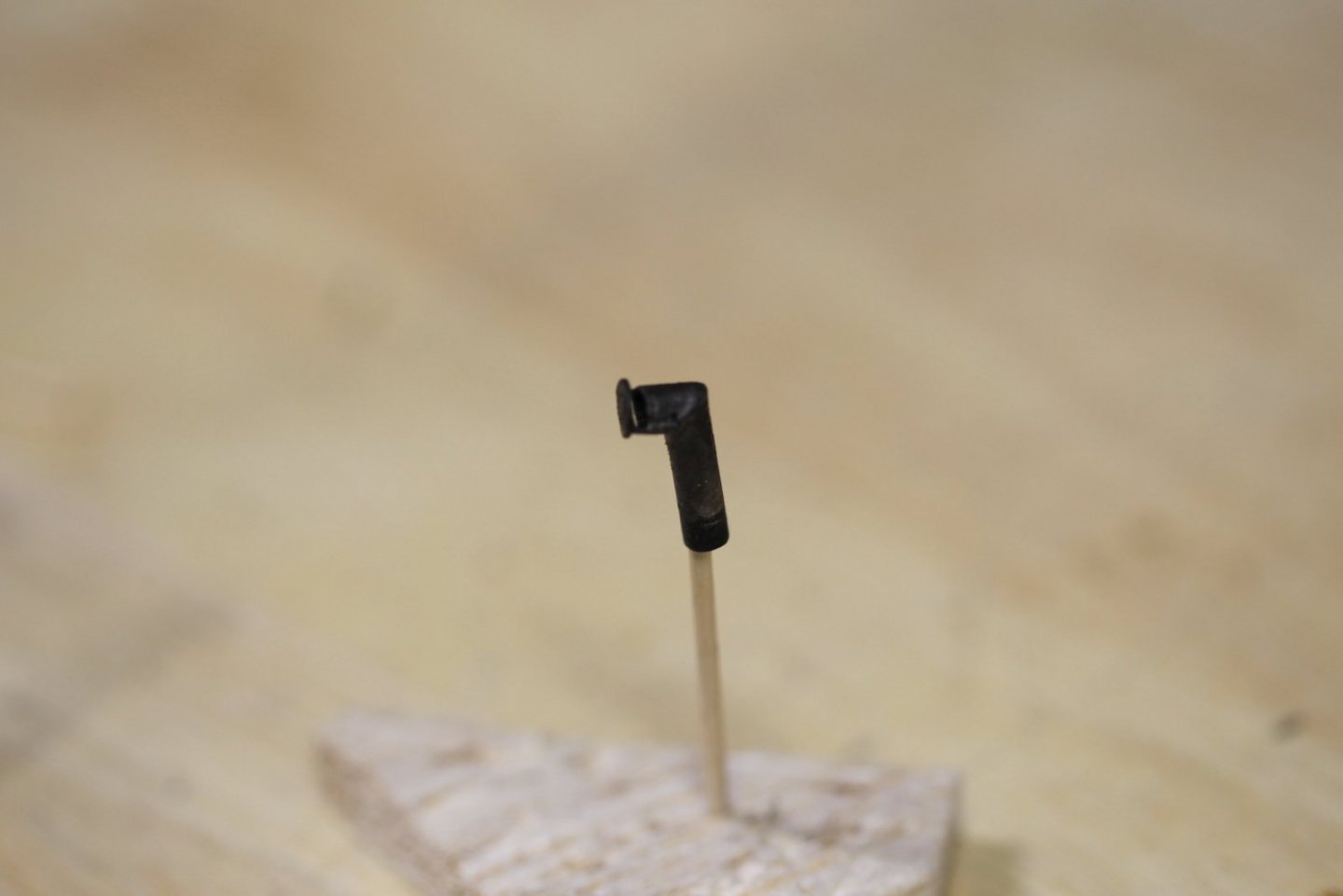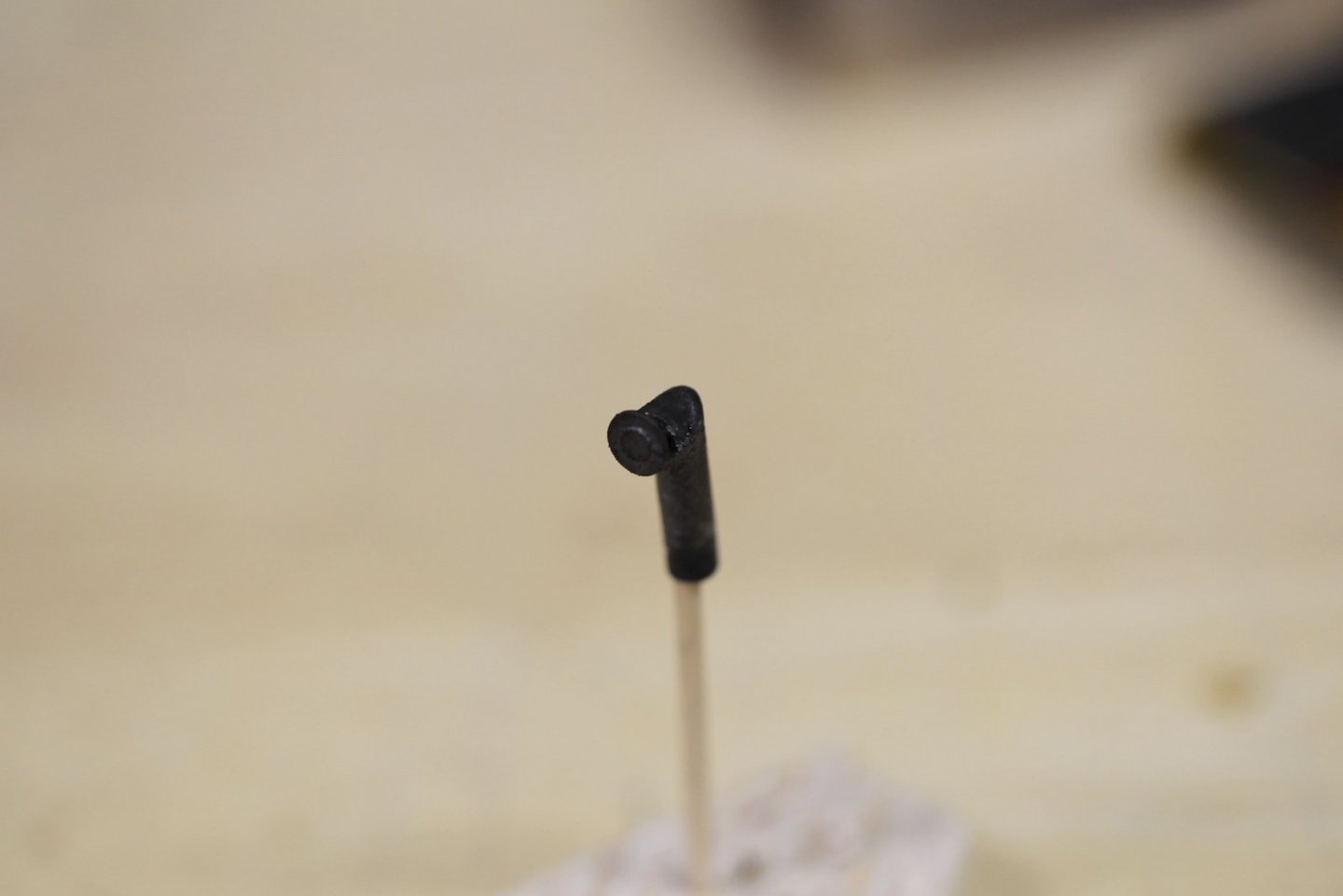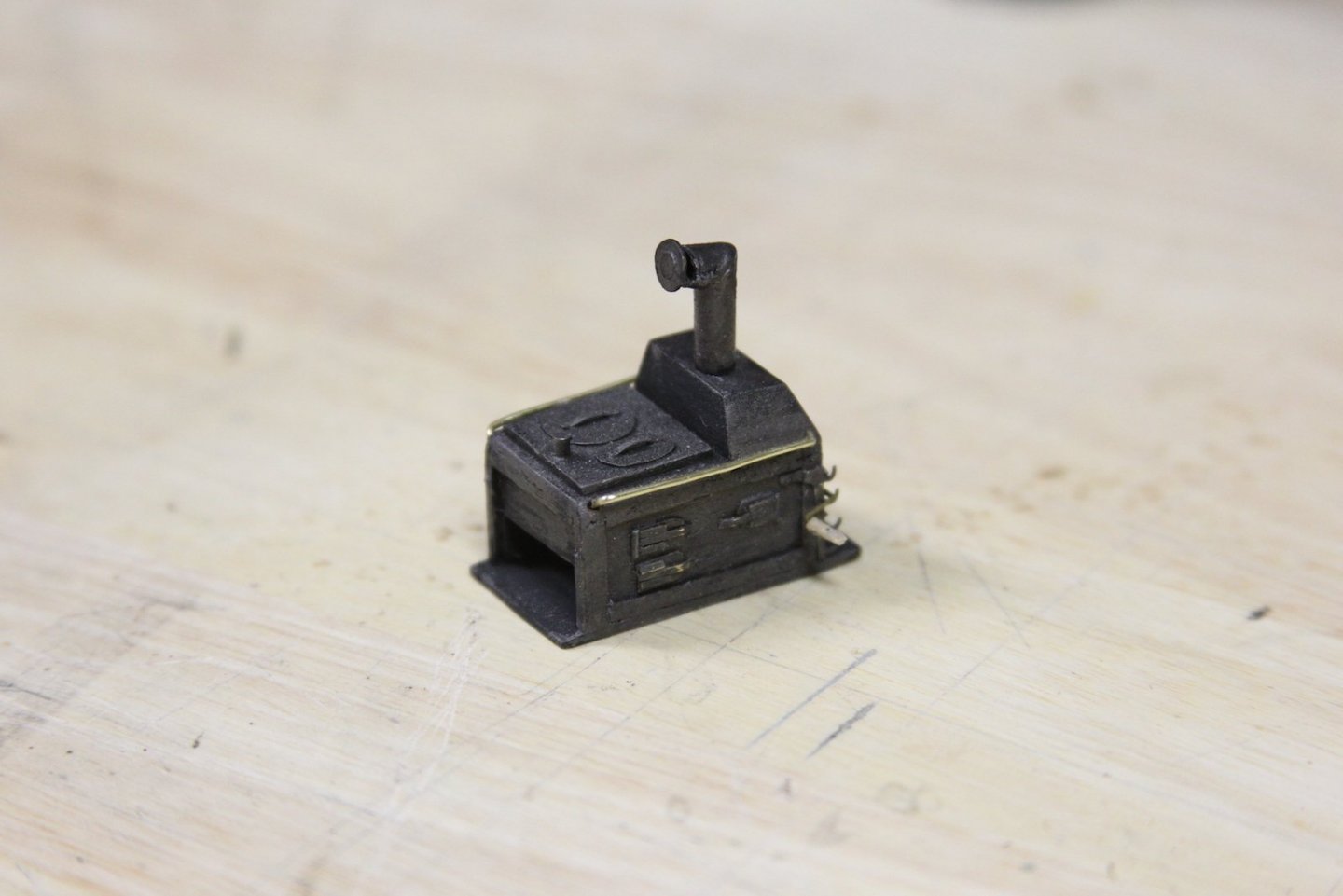-
Posts
963 -
Joined
-
Last visited
Content Type
Profiles
Forums
Gallery
Events
Everything posted by Moonbug
-
On to the assembly line that is guns and carriages. Like many folks who have together the Peg - I found that the guns and carriages that came along with the kit are adequate. That said - I was first introduced to the elegance of @Chuck's Syren guns and carriages when putting the Confederacy together and I couldn't help but add the same upgrade to the Peg. Obviously much of this process is well documented, so I'll just add some highlights in terms of how I handled the process. I created an assembly jig out of leftover scraps, and also used the boxwood pieces from which the carriages came as a jig that allows me to score the sides of the carriages and the wheels. Here's the assembly line. Keen eyes may catch the upper right corner with the iPad (for catching up on old episodes of "Boardwalk Empire" - my current binge) and the stiff rum & coke. 😶 I couldn't get as smooth of an edge off the small pieces provided for the quoin, so I substituted some of my own leftover boxwood. After cutting it down into strips, I fed about 3 or four inches up into the drill press, exposed a quarter inch at a time, lathed out a quoin and cut it off, then pulled the boxwood down another quarter inch and repeated the process. The fourth picture is my process for sanding down the char off the wheels. I have a devil of a time keep them round when I do it by hand, so I inserted a bamboo toothpick into my chalk and put the wheel on. I then VERY gently hold my fingernail against the wheel to get it to spin (rather than push it hard onto the tooth pick) and then barely brush it up against the edge 200 grit sandpaper that's hanging over the table. Couple of important notes: the Dremel is on is lowest speed, and it's important not to do it against a hard surface, but rather let it brush against a flap of sandpaper.
- 338 replies
-
- Victory Models
- Pegasus
-
(and 3 more)
Tagged with:
-

NAIAD 1797 by Bitao - 1:60
Moonbug replied to Bitao's topic in - Build logs for subjects built 1751 - 1800
Man - I just love stumbling across new builds that I have not seen before and being treated to elegant work such as this. So precise - really great stuff! -
Hey Mark, I've done both and really didn't see a noticeable difference to my eye. Like BE - I also use mostly Vallejo paints. However, When I have painted over a varnish - I've used a thin layer of wipe on poly, then gave it a really nice but gentle and consistent sanding with a 400 grit paper until anomalies are smoothed out. It gave the subsequent acrylics a nice surface to adhere to and I think mitigated inconsistencies. In the end, it's probably a lot of extra work for not much of a noticeable difference. Either way, I still think the real key to success is multiple light coats (with good drying time in between) vs. trying to lay it on a little thicker from the start.
- 505 replies
-
- vanguard models
- Sphinx
-
(and 1 more)
Tagged with:
-
This makes ALL the difference, especially with Macro.
- 607 replies
-
- winchelsea
- Syren Ship Model Company
-
(and 1 more)
Tagged with:
-
Thanks @Craigie65, @Beakerboy123 - my aft deck isn’t in place, so Craigie’s is a better representation for the moment.
- 338 replies
-
- Victory Models
- Pegasus
-
(and 3 more)
Tagged with:
-
Nice work B.E. - Please do let us know what you use for the flanges for the outer scuppers - something I've been pondering over myself.
- 858 replies
-
- Sphinx
- Vanguard Models
-
(and 1 more)
Tagged with:
-
Thanks B.E. - it was a bit agonizing. I will confess I was off by a couple millimeters on one deckside scupper - surely not to be noticed by passersby with the canon and rigging, etc - but I'll always know it's there. 😕 Much like the other fittings, the clerestory-style companion top that goes on the aft deck didn't much look like the ones I'd seen from other builds and swan class research. It seemed pretty easy (relatively) to construct one, so I put it together with boxwood. Created the grates first, used the far aft opening to measure out the top, then drilled the windows and filed them square. A leftover laser-cut bit from a previous build gave me a good template. One thing I did a little differently - that I'd been musing over for a while: the window panes. I typically use some sort of acrylic sheet or plastic lining to create the windows, but then I remembered reading in a model train forum that "nothing looks like glass like glass looks like glass..." So I ordered these little guys - .013-.017mm covers for microscope slides. While they're very cool - they're a MAJOR pain in the keister to work with because they shatter almost instantly. After completely unsuccessfully trying a handful of methods to 'cut' them (even trying a glass cutter), I ended up using forceps with the ends tape to brake them close to the right size, then gently sanding down the jagged edges with 400 grit sand paper. Probably took more time than reasonable given that the end result is unlikely to be noticed by most people. But - although it's very hard to tell the difference in photos - I notice the difference, and that's cool.
- 338 replies
-
- Victory Models
- Pegasus
-
(and 3 more)
Tagged with:
-
That definitely looks fiddly to me Mark - but it does look like you're getting close. It feels as though it would be just as difficult to get both sides to match once you get one dialed in.
- 505 replies
-
- vanguard models
- Sphinx
-
(and 1 more)
Tagged with:
-
I did manage to get in some shipyard time over the holiday weekend despite the busy-ness. For a while of it, my 31 year old son actually hung out with me a bit while I worked on the brake pumps. As others have pointed out - there is no reference what-so-ever to brake pumps in the kit instructions, which is a pretty big oversight in my opinion. My brake pumps consist of a wooden dowel that is drilled out then planked on the sides. I left a little knob on the bottom of the dowel so I could fit it into the deck. I chose to plank using the thin leftovers that were supposed to be used for deck planking to mix up the color a bit. Handles/brakes and cheeks are shaped and carved from boxwood with the sides sanded down for shape, then the inside sanded down to accommodate the slot for the handle. Pumps are finished up with a brass tube for a spout, wire eyelet for spear, and a metal strap - ready to mount later. After a few hours and me walking him through the process, my son (who's never been particularly interested in this type of stuff) said "Wow, I can't believe we just made that from nothing!"
- 338 replies
-
- Victory Models
- Pegasus
-
(and 3 more)
Tagged with:
-
Looks great! I've done two Swifts as gifts for friends, and I love the flexibility they offer. Interesting seeing the older version being put together.
- 44 replies
-
- first build
- Artesian Latina
-
(and 1 more)
Tagged with:
-
Beautiful work BE - I think it definitely makes the grade. Really nice looking transition between the sections as you move down the hull. Also, nice solid repair work on the bow!
- 858 replies
-
- Sphinx
- Vanguard Models
-
(and 1 more)
Tagged with:
-
One of the things that I really enjoy about this forum and interacting with all you fine builders - is the plethora of ideas when it comes to home-made tools and techniques. Here's my version of a scribe tool for rails and strips - a 90 degree angle chisel with the edge filed off. The 90 degree end get butted up against the side of the wood strip to keep the line even. I did need to compromise a little bit with the location of this particular strip; which after reading some of the other build logs is not uncommon. Apparently it's tough to get enough room to later attach the frieze, so I lowered this strip and instead notched out the tops of the sweep ports into it. Still looks pretty clean. From there it was about eight to ten hours of painting. First I masked each section off and hit light even coats with the airbrush to get the lines that I wanted, then I went through the entire ship touching up by hand. I've included my array of color choices: The Yellow is thinned down with a little brightness added to the yellow ochre. The Vermillion red is toned down with a nice earthy ochre, and the blue is Vallejo's blue grey. I'm still experimenting, but the sepia wash will be used to give the frieze texture after it's painted yellow ochre.
- 338 replies
-
- Victory Models
- Pegasus
-
(and 3 more)
Tagged with:
-
Just a short post about a small, but anxiety-ridden process for me - the scuppers. I measured them out and drilled the angle through from the black strake to the deck. Got almost all of them right on too! Most are 1.5mm and the pump dale scuppers at 2 mm. I have decided not to 'fill' the scupper holes with a simulated lining like some folks have. I tried it on a couple with a couple different things and I couldn't really get it to not look like a**. So I'm going with a cleaner, slightly less historically accurate angle of having them natural holes. Maybe I'll fill them later if I can find a nice tube that looks legit.
- 338 replies
-
- Victory Models
- Pegasus
-
(and 3 more)
Tagged with:
-
Thanks Andrew - that's an interesting idea, I'll have to give that a shot.
- 338 replies
-
- Victory Models
- Pegasus
-
(and 3 more)
Tagged with:
-
Thanks @mtaylor - Very true, the trick of course being how to mitigate the apparent sin. Hey Pete - great question of course and there seem to be as many personal techniques as there are people. But, for me it comes down to two key things: the type of tape and several light coats. Tape: The type of masking tape is crucial for me - the thinner the better. Tamiya modeler's tape works pretty well for most applications and comes in a variety of sizes. But, my favorite is this stuff that some companies call "Frog" tape. It's much thinner than traditional masking tape and feels more plastic-y than paper. It's meant for house painting, but I find it works well on wood. It is more difficult to tear - but I cut with scissors. This also allows you to create small curves. I prefer to cut the curves necessary. A couple other things that go along with it - I use this weird tool I found a long time ago to rub along the edge several times to get the edge seal very, very tight. The edge of a spoon also works well. The trick is to be able to press down the edge without making an indentation. When it comes to actually painting, my biggest mistake is lack of patience (like any aspect of building right?), but very light coats of paint and several coats work best for me. Too much paint on the brush or over thinned paint are deadly. This is why I prefer an airbrush when I can - I can adjust the flow for really, really light coverage which prevents running. Then I just go over the same spot several times with a little bit of drying time in between. A couple random extra notes: When I'm laying down the tape, if I don't get it in the exact right spot, I don't try to pull it up and re-lay it - I use a new piece of tape. It NEVER seems to stick as well on the second attempt no matter what kind of tape I use. When I'm painting with a brush, I paint across the tape edge instead of along it whenever possible. I start the brush on the tape and stroke down across it. Overall - and once again, this is just my experience - but trying different techniques on scrap wood (depending upon the application) and patience. Here's how the edge along the main wales turned out close up.
- 338 replies
-
- Victory Models
- Pegasus
-
(and 3 more)
Tagged with:
-
I was bound and determined to use the top and butt method for the main wales since it adds such a sense of authenticity to the overall look of the build. Once again - I'm not cutting my own planks, I'm using various sizes that I have in stock in my stash. So - I measured out about a 12 mm total with the wales, 4 mm for the top and a combined 8mm for the bottom two varying in widths from 5mm at the widest point to 3mm at the narrowest point. To achieve this, I measured out one plank and lined out the shifts, cut the plank, then overlapped it on top of the second plank to essentially create the opposite shift pattern so they could then be married together. I figured this offered me the best shot at the patterns fitting together smoothly. In the interest of full disclosure; at the end of the day (or a couple days as the case may be), this method was only moderately successful. There were still some sketchy and inconsistent gaps and I was ultimately glad that these wales are painted black so the variances are less obvious. I like hand painting for the most part, but I was having difficulty getting the crisp lines I usually get. I blame this on my laser eye surgery. Before the surgery I was basically blind with anything past about 18 inches from my face. I had like - point me in the direction of the eye chart cuz I can't see it - kinda vision. But - anything close was perfectly in focus. Great for ship / model building - not so great for... well, life. Now - I have 20/15 distance vision, which is awesome. Except, I can't see crap up close. So, I now have varying degrees of reading glasses, magnifying head gear, etc. But, I'm still getting used to it and it has indeed affected things like painting and small carving. Anyway - not to make this some kind of "woe is me" story - but I opted for taping off the ship and airbrushing the paint on the wales instead. I new I could get the tape much more precise than a brush by hand.
- 338 replies
-
- Victory Models
- Pegasus
-
(and 3 more)
Tagged with:
-
Adding the outside planking to the gun ports gave them (in my opinion) enough additional support and strength to allow me to hack off the side posts on the main deck. So - here's the thing: completely not sure what I was thinking planking the main deck all the way to the outsides before this part of the build. If I had to guess, I'd say that I was just a little excited to see how the Swiss Pear was going to look and just rolled on through the planking. Any - I DO recommend this to anyone else. Heh Completely violates @SpyGlass's policy of trying not to remove wood that you've already added. Anyway - what's done is done - so I cut off the posts, pulled up the planks, and replaced them by forming some card stock and cutting out the planks from wider pieces of Pear and adding a scarph joint. Since I have some trouble lining things up perfectly, my scarph joint is carved into the plank rather than actually adjoining two separate pieces.
- 338 replies
-
- Victory Models
- Pegasus
-
(and 3 more)
Tagged with:
-
Gunport planking continues. After getting the black strake sorted and mounted, I worked my way up mostly following examples from @Trussben and Dan's work - to some degree. Since I'm not cutting my own planking strips I couldn't necessarily scale them exactly to the planking plans from the NMM, instead I adjusted the math to work with the sized planking strips that I was using - 5mm for the sheer strake and 3mm for the 'tweeners' along the gunports. Perhaps not the easiest or preferred method, but I did one (sometimes two) strips all the way across before I carved out the gun and sweep ports. To me, this is jut easier than planking from port to port and ensures evenness across the whole thing. To get the sheer strake to protrude out from the rest and then fall into and blend into the rest of the planking, I cut out a section near the bow, doubled up on it, then blended it in. Finally, I sanded the thickness way down so it didn't jut out too far and look awkward.
- 338 replies
-
- Victory Models
- Pegasus
-
(and 3 more)
Tagged with:
-
After I got the second planking laid down and I adjusted the stern parts, I started laying out what the gunport planking would look like. I wanted something lighter than the walnut so I'd have more painting (or not painting) options, so I'm using basswood. It's not my favorite of course, since it's soft and difficult to get precise around the gunports and sweep ports, but it's what I have and It'll end up getting painted anyway. My intention is to paint some key parts (main wales, inner gunports, outer gunports, masts etc) but leave a lot of the deck fixtures and other parts more natural wood colors. Once again, a bit of artistic license being used here. At any rate - laying out the gunport planking made me quickly realize that my lines were off. Following the prefab gunport parts gave me a much more significant dip along the main wales than makes sense. I soaked and shaped the sheer strake and held that in place so I could sort out how many planks I'd need and where'd they'd go - you can see the nasty gap there. Yikes. Thanks what I get for blinding following the gunport and forgetting to look ahead far enough. Normally I'd start with lining up the main wales and work my way up, but I decided I would instead start with the black strake (not actually black) and work from there since it's critical that the black strake line up to the deck so the scuppers make sense. I wasn't too worried about trimming and filling in the second layer walnut in the areas that needed it because that will ultimately be covered up by the main wales. As you can see in the last photo - much smoother lines and more consistent with the NMM plans.
- 338 replies
-
- Victory Models
- Pegasus
-
(and 3 more)
Tagged with:
-
Exactly how to plank the gunports and fit the main wale has been giving me fits. I've been looking through books and logs and and have been agonizing over what to do here until I realized that the stern / transom area on the kit is a little bit of a debacle. Not only does it not really line up very well, but it doesn't appear to create the proper shape based on the NMM plans or really any of the other top-notch logs/builds. Not to mention there are some weird gaps and an oversized hole for the helm port. Since I re-created the stern post and needed to remount that anyway, I abandoned the kit parts and re-planked the counter. This gave me the chance to carve out a much more size-appropriate helm port and also get a better view of how my main wale and bulwark planking would line up.
- 338 replies
-
- Victory Models
- Pegasus
-
(and 3 more)
Tagged with:
-
My first go-round on the stove vent was both pre-drill press and pre-silver solder - so I gave it another attempt and I'm much more pleased with the result. Same basic process, but able to dial in a little more detail. The vent itself is a small brass washer with the hole filled in with a smaller disc. The entire thing is blackened, then dry-brushed with the same metalizer used in the previous attempt.
- 338 replies
-
- Victory Models
- Pegasus
-
(and 3 more)
Tagged with:
-
Thanks Cisco, Mark and B.E. Mark and B.E. - you’re both exactly right. I also don’t have the equipment to get the tapers perfectly consistent. I had a good sized eraser and I was erasing, remeasuring and remarking along the way - hence all the fun pencil marks like a university chalkboard. What an art from it is to get it nailed down like some of the great work we see on here! I’m going to make a couple of repairs and touch ups still - but when I started my goal was to have the option of coppering or not coppering. Internally - I’m a little disappointed that the flaws have essentially removed that option, but I’m still happy with it. At least I won’t have to stain the hell out of it to get it to look good like my first build the San Juan. 😛
- 338 replies
-
- Victory Models
- Pegasus
-
(and 3 more)
Tagged with:
-
She’s looking good Mark - I feel your pain of ad nauseam.
- 505 replies
-
- vanguard models
- Sphinx
-
(and 1 more)
Tagged with:
About us
Modelshipworld - Advancing Ship Modeling through Research
SSL Secured
Your security is important for us so this Website is SSL-Secured
NRG Mailing Address
Nautical Research Guild
237 South Lincoln Street
Westmont IL, 60559-1917
Model Ship World ® and the MSW logo are Registered Trademarks, and belong to the Nautical Research Guild (United States Patent and Trademark Office: No. 6,929,264 & No. 6,929,274, registered Dec. 20, 2022)
Helpful Links
About the NRG
If you enjoy building ship models that are historically accurate as well as beautiful, then The Nautical Research Guild (NRG) is just right for you.
The Guild is a non-profit educational organization whose mission is to “Advance Ship Modeling Through Research”. We provide support to our members in their efforts to raise the quality of their model ships.
The Nautical Research Guild has published our world-renowned quarterly magazine, The Nautical Research Journal, since 1955. The pages of the Journal are full of articles by accomplished ship modelers who show you how they create those exquisite details on their models, and by maritime historians who show you the correct details to build. The Journal is available in both print and digital editions. Go to the NRG web site (www.thenrg.org) to download a complimentary digital copy of the Journal. The NRG also publishes plan sets, books and compilations of back issues of the Journal and the former Ships in Scale and Model Ship Builder magazines.


